VAIL, JOSEPH A. (1835-1876). First lieutenant, 5th New York Infantry, Companies A, K, and G. Vail, who was born in New York City and resided at 158 Grand Street in Manhattan, was a tailor by occupation. After enlisting as a private on April 25, 1861, at New York City, he mustered into the 5th New York the next month on May 9. Vail showed heroism during the Battle of Big Bethel, Virginia, on June 10, 1861 when he ran over to take the flag from the color sergeant who was overcome by exhaustion. Vail bore the colors aloft until ordered to give them up against his will. He received promotions to corporal on August 3, 1861, and to sergeant on January 1, 1862. During the Battle of Second Bull Run, Virginia, he was wounded in the leg on August 30, 1862. Upon his promotion to second lieutenant on November 12, 1862, he was transferred to Company K and later transferred to Company G when he attained the rank of first lieutenant on February 8, 1863. He mustered out on May 14, 1863, at New York City.
Civil War Bio Search
After the War, Vail worked with his father in the merchant tailor business. His occupation was listed as tailor in the 1870 census. He last lived at 143 Avenue D in Manhattan. The cause of his death was Bright’s disease. Helen Vail applied for and received a widow’s pension in 1890, certificate 287,403. Section 24, lot 6785.
VALENTINE, HARRY W. (1851-1928). Drummer, 187th New York Infantry, Company G. Valentine may have served as a drummer boy in an auxiliary role for the 187th New York. Though his name does not appear on the muster roll for that regiment, his name is listed as having served with the 187th in the 1927 Roster of the Society for the Army of the Potomac. He last lived at 865 Union Street in Brooklyn. Valentine died of cancer. Section 175, lot 26737.
VALENTINE, WILLIAM H. (1840-1911). Private, 84th Regiment, New York State National Guard, Company B. A New York State native, Valentine enlisted at Brooklyn as a private in 1863 and served in the 84th Regiment for 30 days mustering out with his company at the expiration of his enlistment. In 1891, he applied for and received an invalid pension, certificate 791,399. His last residence was 354 4th Street in Brooklyn. Shortly after his death in 1911, his wife applied for a widow’s pension that was granted, certificate 721,301. Section 152, lot 18758, grave 2.
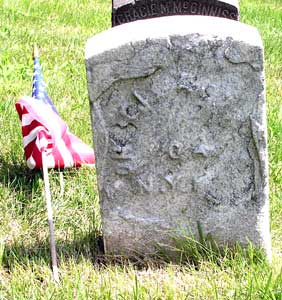
VALLIAN (VALLEAU, VALOO), CHARLES (1833-1914). Private, 8th Regiment, New York State Militia, Company A. He enlisted in the 8th New York State Militia for its three month activation in 1861. Other details are unknown. His last residence was 300 West 116th Street in Manhattan. Section 136, lot 28307, grave 927.
VAN BOKKELEN, WILLIAM KEMBLE (1822-1907). Captain, United States Army, Quartermaster’s Department. Van Bokkelen, a native of New York City, moved South with his family at a young age. After being a cadet and a graduate of the United States Military Academy in 1843, of which Ulysses S. Grant was a member, he began his career in the military when he was brevetted to second lieutenant on July 1, 1843, and commissioned into the 7th United States Infantry. He was promoted to second lieutenant in the 3rd United States Infantry on November 26, 1845, and returned to the 7th on June 27, 1846. A year later, he was brevetted to first lieutenant on August 20, 1847, “for gallant and meritorious conduct in the Battles of Contreras and Churubusco, Mexico.” He then transferred into the Reserve Quartermaster’s Department where he served from January 17, 1848-September 10, 1850, and was promoted to first lieutenant with rank from July 16, 1850.
On July 28, 1853, Van Bokkelen enlisted as a captain and was commissioned into the United States Army Quartermaster’s Department from which he was cashiered out on May 8, 1861, for “misapplication of $225 of public funds.” Once he became a civilian, he lived in Brooklyn for 45 years, was employed in the mercantile business and at the end of his life, was engaged in the real estate business. In 1895, an article in The New York Times described his golden wedding anniversary. An article in the Brooklyn Daily Eagle on February 17, 1901, noted that he and Francis Pinto (see) were the only two officers of the Mexican War still living in Brooklyn. He last lived at 294 St. James Place in Brooklyn. His death was caused by Bright’s disease. Section 108, lot 1809.
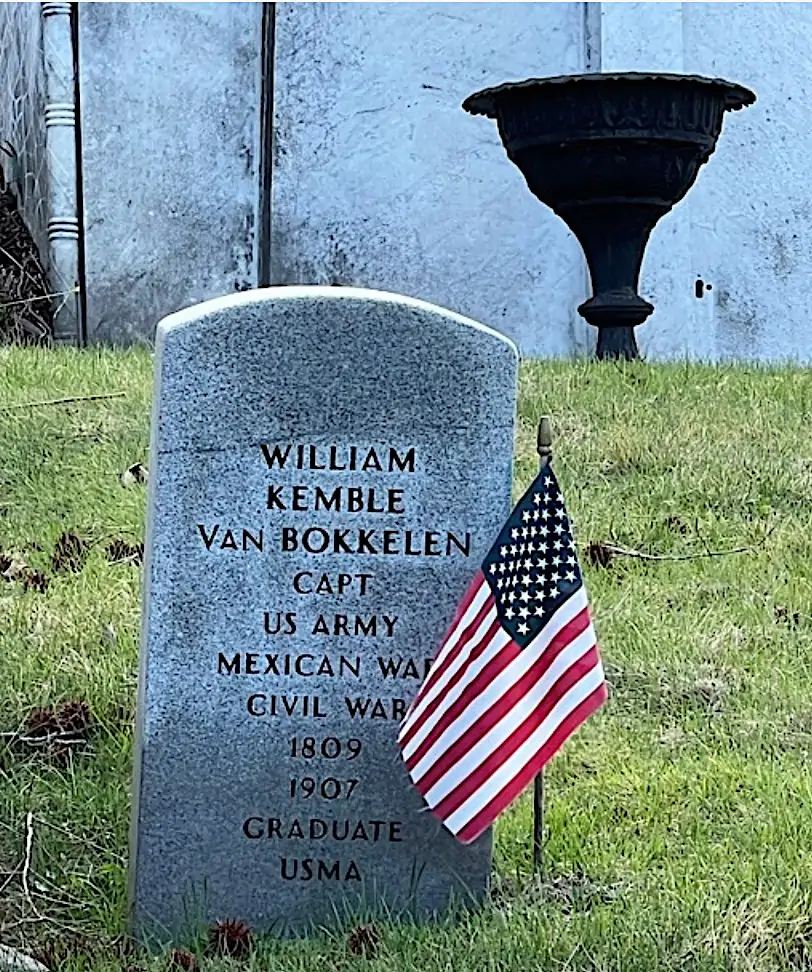
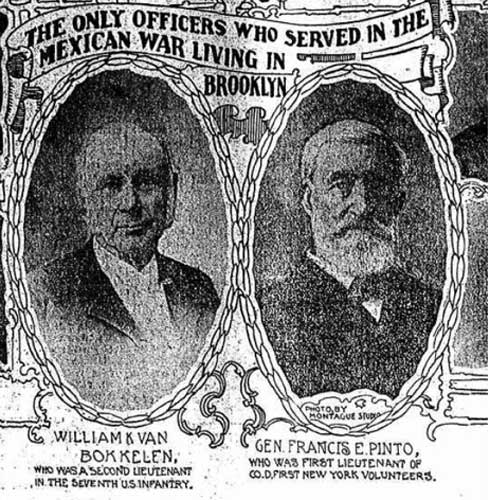
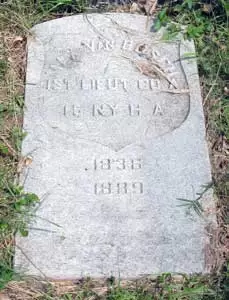
VAN BOSCH (or VAN BOOSH, VAN BOSH), MAX (or MARCUS) (1836-1889). First lieutenant, 15th New York Heavy Artillery, Companies A and C. Born in Neuenhaus in Hanover, Germany, Van Bosch enlisted at New York City as a sergeant on August 23, 1861, and mustered into Company A of the 15th Heavy Artillery, 3rd Battalion, on September 23. On January 2, 1862, he was promoted to second lieutenant and was transferred into Company C that day. After his promotion to first lieutenant on September 2, 1863, he returned to Company A. His pension record and the muster roll indicate that he served as a quartermaster in the Field and Staff of the 15th Heavy Artillery.
During his service as quartermaster from December 15, 1861, through January 1, 1863, Van Bosch was accused of improprieties. He was investigated by Levi C. Turner and Lafayette C. Baker beginning in May 1863 for selling clothing and other material to officers of the regiment in July- August 1862 at Fort Ethan Allen. It was rumored that he accepted a gold watch and $50 as a bribe for allowing merchandise to pass the guard without examination. Van Bosch, in defense, stated that he took a felt hat, appropriated pepper and leather to the men for resoling their shoes and returned the liquor that came in the shipment under question. Though the results of this investigation are unclear, Van Bosch mustered out on August 22, 1865, at Washington, D.C. His name, listed as Max Van Bosh, appears on a list of Jewish veterans of the Civil War.
Van Bosch became a naturalized citizen on October 27, 1865. According to the census of 1880, he was employed as a merchant; the Brooklyn Directory of 1888-1890 lists him as an agent. He also was a Freemason. His last residence was 233 Hooper Street in Brooklyn. In 1890, his wife, Louise Van Bosch, who is interred with him, applied for and received a widow’s pension, certificate 335,434. His wife, née Joachim, whom he married in November 1864, was the sister of Conrad (see) and aunt of Charles Joachim (see) who are buried in the Soldiers’ Lot. All three served with the 15th and, according to a descendant, Van Bosch promoted Charles Joachim to second lieutenant. Section 115, lot 11193, grave 214.
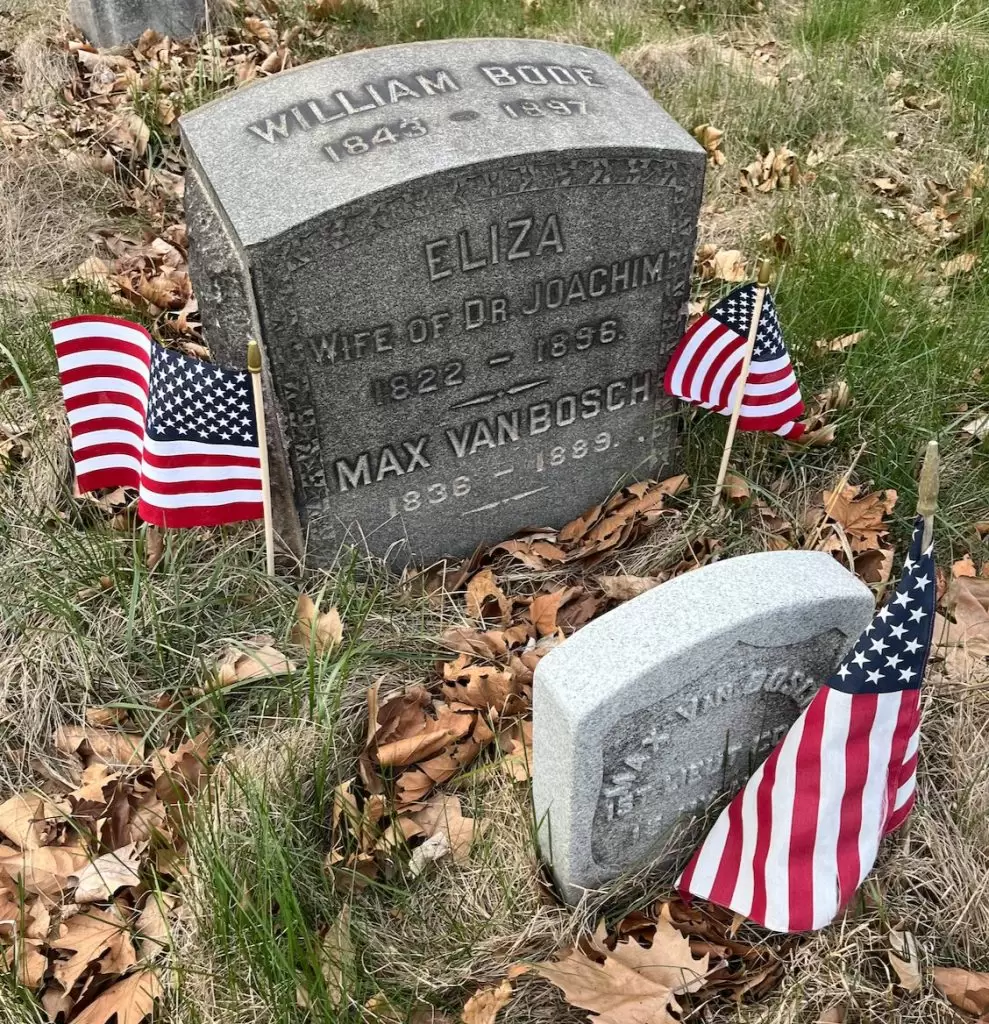
VAN BRUNT, CHARLES F. (1841-1870). Private, 5th New York Infantry, Company F. Van Brunt was born in New York City. As per his muster roll, he enlisted as a private on April 30, 1861, and mustered into Company F of the 5th New York Infantry at Fort Schuyler, New York on May 9. His muster roll describes him as 5′ 7″ tall with hazel eyes, light hair and a light complexion. He noted his occupation as coachman. He was paid by New York State $5.04 from April 30 through May 14. On July 27, 1861, he was discharged for disability at Fort Monroe, Virginia. His disability was deafness that was a result of having had scarlet fever when he was young.
Van Brunt married Sarah Jane Davis in New York City on October 22, 1867. A bookkeeper at the time, their marriage was recorded in the United Methodist Church Records, 1775-1949 for New York, New Jersey and Connecticut. The 1870 census, which lists him as married also shows that he died from consumption in January 1870. He last lived in New York City. Section 117, lot 8411.
VAN BRUNT, CORNELIUS A. (1826-1870). Sergeant, 8th Regiment, New York State National Guard, Company E. Van Brunt, who was born on Long Island, served in his company twice. The first time was for three months as a corporal in 1861 when the regiment was part of the New York State Militia. He then served for 30 days in 1863 as a sergeant when the regiment was part of the New York State National Guard.
According to the census of 1870, he was an organ builder with real estate valued at $8,000. Van Brunt last lived at 68 South 3rd Street in Brooklyn. In 1871, his widow, Louisa, went to court after he died without a will, asking to administer his estate which, she reported, was valued at less than $11,000. Section 60, lot 183.
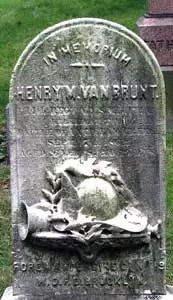
VAN BRUNT, HENRY M. (1836-1862). Private, 84th New York (14th Brooklyn) Infantry, Company A. Listed as a carriage driver on the 1860 census, Van Brunt was the foreman of Engine Company #19 in Brooklyn before his military service. An article in the Brooklyn Daily Eagle dated February 8, 1861, notes that he was elected assistant engineer of Empire Engine Co. 19, presented with a full fire suit and feted at a local restaurant. A Brooklyn resident who served his country for less than one month, he enlisted there on August 20, 1862, mustered in on that date, and was killed in battle at Antietam, Maryland, on September 17, 1862.
On September 25, a fellow private, John Moody wrote a letter to the Brooklyn Daily Eagle detailing Van Brunt’s injuries and expressing the sorrow that his company felt, “He received a ball through his head and another through his thigh. His comrades buried him with military honors. The deceased was a most promising young man, but twenty-six years of age, and had only been on to the regiment three weeks.” Van Brunt was the brother of Alderman James Van Brunt of the 8th Ward. Interment at Green-Wood was on October 1, 1862; an invitation was extended to members of the 14th and to his engine company. Section 44, lot 4672.
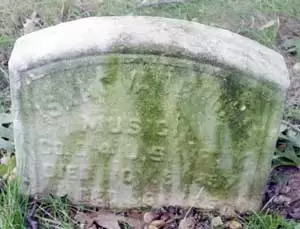
VAN BRUNT, ISAAC (1850-1896). Musician, 4th Infantry, United States Army, Company C. A New Yorker by birth and listed as a boy on Army records, Van Brunt was only 14 (though he most likely claimed to be 16) when he enlisted on November 5, 1864. At that time, he had brown hair and eyes, a fair complexion and was 5′ 1¼” tall. Van Brunt served in the 4th Infantry of the United States Army as a musician during the War and was discharged at the expiration of his enlistment on November 5, 1867, at Fort Laramie, Wyoming.
According to the census of 1880, Van Brunt was employed as a carpenter. He became a member of the G.A.R. on October 17, 1883. He was employed as a merchant in 1892. An article about his sudden death was published in the Brooklyn Daily Eagle on November 6, 1896. Identified as a carpenter and labor leader, he was walking up the stairs of the subway station at 23rd Street and Third Avenue in Manhattan when stricken. He died at Bellevue Hospital a half an hour later; an autopsy disclosed an undiagnosed heart condition.
Van Brunt was reportedly employed by an unnamed New York newspaper at the time of his death and was at work erecting election bulletin boards. His obituary in the Brooklyn Daily Eagle confirms his military service and notes that he was a member of the New York Brotherhood of Carpenters and Joiners. The Evening Telegram and Sun, two local New York newspapers, also identified Van Brunt as a labor leader in recording his death, and state that he was secretary of the Brooklyn Carpenters’ Union. George Van Brunt, his brother, was the paymaster of the Norfolk, Virginia, Navy Yard. He last lived on Logan Street in Brooklyn. Shortly after his death In 1896, his widow applied for and received a pension under certificate 441,252. Section 117, lot 8411.
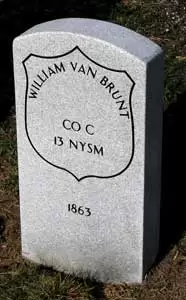
VAN BRUNT, WILLIAM (1833-1863). Private, 13th Regiment, New York State Militia, Company C. Van Brunt served for three months in 1861 when the 13th Regiment was activated. According to his obituary in the Brooklyn Daily Eagle, members of the 13th were invited to his funeral that was held at his residence at Falton Avenue and Oxford Street in Brooklyn. His tombstone in the Soldiers’ Lot at Green-Wood, an area set aside for Civil War veterans, confirms his service in the 13th State Militia and date of death in 1863. Section 115, lot 13536 (Soldiers’ Lot), grave 68.
VAN BRUNT, WILLIAM HALLIDAY (or G.) (1832-1917). Adjutant, 52nd Regiment, New York State National Guard, Field and Staff; first lieutenant, 145th New York Infantry, Company C; unknown rank, 13th Regiment, New York National Guard, Company D. Census data from 1900 and 1910 report that Van Brunt was born in New York City but the census of 1860 indicates that he was born in Canada. The New York State census of 1855 indicates that he was living with his parents in Brooklyn. As per the census of 1860, he was a policeman living with his parents and siblings with a personal estate of $500. His father, also named William, was an undertaker who apparently dug up the body of Thomas Stockwell (see) at Burnside’s Bridge along Antietam Creek and brought it back to Green-Wood.
According to his pension index card, Van Brunt first served in Company D of the 13th Regiment (rank not stated) from May 30 through early September, 1862. After re-enlisting as a first lieutenant on September 9, 1862, at New Dorp, Staten Island, he was commissioned into Company C of the 145th New York two days later, and was discharged on March 1, 1863, by order of General Henry Slocum (see). Van Brunt re-enlisted as an adjutant at Brooklyn and was commissioned into the Field and Staff of the 52nd Regiment on June 19. He mustered out on July 25, 1863, at Brooklyn. In 1897, he applied for and received an invalid pension, certificate 943,452. His pension index card also notes service in Company D of the 13th New York Infantry but does not indicate the details of that service.
As per the census of 1900, he was a ship broker living as a boarder in Brooklyn; he had been married for three years. At the time of the 1910 census, he was a single lodger living on Cumberland Street in Brooklyn, was able to read and write and was a survivor of the Union Army. His last address was 135 Cumberland Street in Brooklyn. The cause of his death was myocarditis. Section 44, lot 4672.
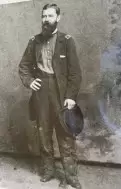
VAN BUREN, DANIEL TOMPKINS (1826-1890). Brigadier general by brevet; colonel, United States Volunteers Aide-de-Camp; major, United States Volunteers Adjutant General’s Department; captain, 20th Regiment, New York State Militia. Born in Kingston, New York, Van Buren was an 1847 graduate of the United States Military Academy, number 6 in his class of 38, and an instructor of ethics while a cadet. His family’s roots could be traced back to the 1660s and his family tree shows a connection to President Martin Van Buren. He first served as a second lieutenant in the United States Light Artillery from 1847 to 1855, including service in the Mexican War, teaching duty as a professor of natural and experimental philosophy at West Point, and selection for the Coastal Survey in 1852. He resigned from the Army after his father’s death in 1855 to take care of the family estate, then had a career in law and as a civil engineer with specialty in practical math and science. In 1858, New York’s Governor King appointed him colonel of engineers in the Third Division of State Militia.
When the Civil War began, Van Buren enlisted as a captain on April 27, 1861, at Kingston, New York, where he resided, and was commissioned into the Field and Staff of the 20th Regiment as captain of engineers that day. After serving for 100 days, he mustered out at Kingston on August 2. The next day, he was commissioned as major and assistant adjutant general in the United States Volunteers Adjutant General’s Department where he served on the staff of Major General John A. Dix. Dix wrote, “His services were of the greatest value and during my absence on a commission he discharged all the duties of the Department. He deserves from the government all that he asks, for his faithful, zealous, efficient and unremitted service.” He was subsequently promoted to colonel and aide-de-camp with the United States Volunteers Aide-de-Camp on June 1, 1862, and was brevetted a brigadier general on March 13, 1865, for “faithful and meritorious services during the Rebellion.” By order of the Headquarters Department of the East, United States Army, dated April 23, 1865, he was named a member of the Guard of Honor detailed to stand near the body of the assassinated President Abraham Lincoln as it was put on view in the City Hall of New York City. He mustered out on March 20, 1866.
After the War, Van Buren was employed as a surveyor and civil engineer where he was renowned for his knowledge of his native county in Kingston, his expert testimony in boundary disputes and other complicated territorial issues. William Burns, who wrote an obituary for his classmate at the West Point Reunion of 1891, commended him not only for his achievements but for his humor, kindness and affectionate nature. His last address was in Plainfield, New Jersey. Section 175, lot 26671.
VAN BUREN, JAMES H. (1843-1864). Musician, 2nd Connecticut Heavy Artillery, Company G. A resident of Cornwall, Connecticut, he enlisted on August 18, 1862, as a musician, mustered into the 2nd Connecticut Heavy Artillery on September 11, and became a private when he transferred to ranks on an unknown date. He was severely wounded in the left leg at Winchester, Virginia, on September 19, 1864, had the limb amputated, and succumbed to his wounds on October 7. He was interred at Green-Wood a year later on October 3, 1865. Section 184, lot 9962, grave 181.
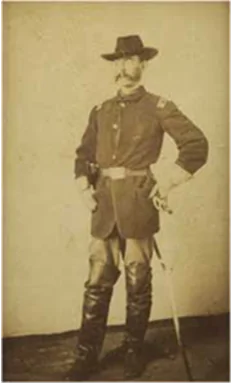
VAN BUREN, JAMES LYMAN (1837-1866). Brigadier general, colonel and lieutenant colonel by brevet; major, United States Volunteers Aide-De-Camp; second lieutenant, 53rd New York Infantry, Company D. Born in Dunkirk, New York, and a cousin of President Martin Van Buren, he entered the Free Academy, a prestigious institution, in 1852, with advanced placement in English and mathematics. After his graduation in 1856, James Lyman Van Buren studied law at the College of the City of New York and traveled in Europe and lived in Germany for several months before returning to the United States prior to the Civil War.
Van Buren enlisted as a second lieutenant at New York City on October 12, 1861, was commissioned into the 53rd New York, also known as the D’Epineuil Zoaves, two weeks later on October 26, and mustered out on March 13, 1862. He was promoted to major and commissioned into the United States Volunteers Aide-De-Camp on July 7, 1862. Knowledgeable in signal code, he was a signal officer on the staff of General John G. Foster at Roanoke Island, where he was cited for bravery, and New Berne, North Carolina, was secretary to Governor Edward Stanly, and served as a judge advocate on the staff of Major General Ambrose Burnside, who commanded the Army of the Potomac, first as a judge advocate and later during the East Tennessee Campaign. In November 1862, Van Buren was on sick leave in New York with his father’s family but returned when Burnside took command in East Tennessee. Van Buren wrote letters during the siege of Knoxville and Battle of Lookout Mountain that were notable for their scholarly perspective. In 1864, he participated in Grant’s campaign against Richmond, Virginia, and was recognized for his efforts in the assault on the works at Petersburg, Virginia. During the aforementioned campaign in the Potomac, he kept a detailed journal of the Battle of the Wilderness in May 1864, which is cited below:
“Wednesday, May 4. Left our camp at Warrenton Junction today. Reveille at 5:00 and broke camp soon after though we did not move till about 10. Very hot and dusty. Stopped at Bealton Station – the general discovering a telegraph office – Loring and I searched around the dismal waste – found some starved and dusty grass – a small patch – and sat down to lunch – bread, cold ham and sherry. Thence on to Rappahannock Station – stopped – sat around for a time and Pell established camp. I stayed at the office with the general telegraphing up and down the road about rations, trains, etc. In the midst whereof came the startling dispatch from Grant to pull up stakes and push with all speed for Germanna Ford on the Rapidan. Reconnoitered the roads and found them blocked with Army of the Potomac trains, so stayed in camp till early morn. Had my hair cut by an 8th infantry man. Told him about one-half inch shorter – he understood about half inch short and rendered my locks to that measurement. Dispatch from Meade that crossing of the Rapidan had been effected without opposition. Very glad we shall be in the row after all.
“Thursday, May 5. Broke camp about daylight but did not move for an hour, Willcox reporting roads blocked. Crossed the Rappahannock on railroad bridge – marched steadily on – halted to rest at Paoli Mills, also about 3 mi. from Rapidan, and lunched. Colonel Dent of Grant’s staff came up in rather an excited frame of mind, reporting Lee massing to oppose us and considerable fighting having taken place. As we pushed to the river could see far in the distance the long line of dust across the river leading from the rebel positions to the Ford. Reached Germanna Ford about 2:00 p.m., sent Stevenson across and he was put in position near the river by one of Grant’s aides. Crossed the whole force later and the general and staff went on to a house couple of miles up – where we stayed all the afternoon. Fighting going on in Sedgwick’s front – he had right of army. I was sent to him with tender of assistance. Found him and Wright sitting on a log by the roadside – the country a tangled, dense low growth – terrible for fighting through – saw Whittier, McClellan and the rest. After dark rode with General to Old Wilderness Tavern to see Grant. I saw him not. Returned to camp, supped and soon after going to bed was roused to take orders to Willcox and see what he could do about discovering force in his front. He utterly suggestionless. About 2:00 a.m. the whole force started for the left of the Army of the Potomac, an attack being ordered for 4:30. We did not get up in time owing principally to Willcox being behind. Found Warren at the Lacy House. An opening had been left for us between Hancock the extreme left and Warren the center. Pushed Parke and Potter in. Willcox came up and was put behind them. Stevenson was ordered over to reinforce Hancock. The General seeing at once the vital point started our column for Parker’s store, an admirable move that if followed out would have pierced their center and probably resulted in crushing their right wing.
At this point Van Buren has drawn in the positions of Warren, Sedgwick and Hancock’s Corps vis a vis that of their opponent, A.P. Hill, and Parker’s store. We pushed out on the Parker’s store road. As we left the woods and came out on a hill a battery opened on us – the general having carried his staff and escort with him – and they dropped shells among us in quite a lively manner. Nobody hurt. Gen. Parke had a chill. Potter’s division went in on the run and the battery soon shut up. We went into edge of woods and sent troops in. After some little time, Comstock came up and muddled matters- getting Grant to transfer us to Hancock’s flank. So transferred our troops – reconnoitered the ground. I was sent to Meade to learn the news from Hancock. Found him – was curtly referred to General Grant who was present. Found Ulysses sitting at the foot of a tree puffing a weed. He reported Hancock getting on well, asked what we were doing and I told him and passed back. Bliss’ brigade was ordered in but was very slow. Finally got in the two divisions less one brigade. Heavily engaged. Christ’s brigade had to be thrown in and the position on the Parker’s store road abandoned. I brought Christ over – the enemy jumped onto us as we were leaving but were repulsed. General went to front and I with him. Porter came over and said everything depended on our going in. Dense thicketed country. I found Potter and Willcox and brought them back to the general. Things did not go right at all, it struck me from Willcox’s lack of vim – he having the front line. Loss quite heavy and fighting indecisive. At sundown general and some of us rode up to see Grant. General talked with him and we with Porter, Babcock, Badeau etc. Then up to Warren’s where was Parke still suffering from his chill – administered some caudine (sic) to him. A colonel turned up with a couple of regiments for Potter and I took them up to him – delivering orders about entrenching to him and Willcox. Then had a beastly half hour searching for camp, only found it by accident down in the lowlands. Enemy made a heavy attack on Warren and drove in Sedgwick’s left. Things looked a little stampedish – General cool. Pell contradicts so supped and went to bed. I was routed out there and sent with orders to Marshall. Dark as a pocket and my idea of Marshall’s locality very indistinct. Found him after much tribulation. Home again to bed.
Saturday May 7. Rather a quiet day – we laid around on the hillside most of the day doing nothing in particular, one of us getting sent off occasionally. A mild popping going on all through the line with occasional crescendo. Orders came in the afternoon to move off by the left with route laid down for us as Childsburg. Started the columns late in the afternoon – the general went on ahead. General Parke and most of the staff started under guidance of Hulton. Reached the Old Wilderness Road and Hulton’s knowledge gave out. I rode up to Meade’s headquarters to get bearings, rode off and found the general at Potter’s headquarters wherein I sent orderly back to bring up the rest and I took a hasty cup of coffee and a biscuit with Gowan to my great refreshment. General and I rode back to the road. Parke and party not yet up so I started back to find them. Broke through a bridge but Dick [his horse] gallantly rescued himself without harm. Cruised around in the darkness but could discover none of my friends and so headed back again to the house on the hill where we were to rendezvous and found them there. Built fire in the yard of the house – Loring produced a pate de Perigord, I some chocolate and hard tack, and General Parke, Loring, Larned, Harris and I feasted quite primely. Thereafter we slept for a while till about midnight when we pushed along – found the roads crowded with troops and trains, moving very slowly. Stopped in a plowed field and slept till near daylight. Rode hurriedly through lines of troops in the dim dawn, they all recognizing the general and making remarks (Old Buccaneer, etc.). Found Sedgwick by the roadside, stopped with him until his corps was out of the way. He made naive and A.P.ish remark that he had been waiting for six hours for the wagons in front to get out of the way. After he left we made beds of old grain bags on the slope of a rebel breast work and sought sleep. To me it came not. Pushed on through infinite dust to Chancellorsville. Halted there amidst the ruins, horribly hot and forlorn. Met Will Eastman who took me to his shanty and brought forth ham and hard tack. Thereafter I produced a pate which was soon disposed of. Then an ambulance came up with grog and a general assault was made with unabated energy. Pell started off and pitched camp to which we went after a time. Took a bath – clean clothes and was happy temporarily. We laid around till 9:00 p.m. waiting for news from the front. Heard that fighting at Spotsylvania Courthouse would prevent our movement and went into camp again on same place.”
Van Buren was promoted by brevet to lieutenant colonel and colonel on August 1, 1864, for his bravery in the campaigns in Richmond, Virginia, and Knoxville Tennessee, and to brigadier general on April 2, 1865, “for gallant and meritorious conduct at Forts Stedman and Sedgwick, Virginia.” In ill health beginning in August 1865, suffering from the effects of malaria that he contracted in North Carolina, and confined to his chamber, he ran up a medical bill of $802, an extraordinary debt at that time but his physician returned the payment on January 1, 1866, “You have given me your services, your health and almost your life, in helping to preserve for me the integrity of my country. So, whilst wishing you a Happy New Year and a restoration to health, allow me, so far as it goes, to cancel your indebtedness by presenting you with the enclosed.” He died in New York City of a hepatic abscess on April 13, 1866, two weeks after he mustered out on March 31. General Burnside wrote a note to his parents the next day:
You and your family have my heartfelt sympathy in the terrible affliction which has fallen upon you. The son you have lost was one of my most valued friends and faithful, efficient assistants in the field- not only his friends but the country has met with great loss in his death. The same loyalty, courage and intelligence that made him one of the most brilliant staff officers in the army would have won for him a high place in civil pursuits…God bless and comfort you and yours in this great affliction.
The United States Service Magazine (1866) said of him:
He was a brave and affectionate man; with his heart right and with a strong sense of duty always awake. He was conscientious and candid beyond most men. Knowing himself and his faults very well, he was magnanimous in the true sense; he had noble ambitions and ready sympathies. He was a sagacious officer, full of resources, and prompt in action. And he always loved his country with that truer love that desired her moral greatness more than her material prosperity.
Members of the 12th Regiment National Guard were escorts at his funeral. Van Buren’s possessions, including a folding camp chair and the journal that he kept during the Battle of the Wilderness, Virginia, in May 1864, were given to his parents, and were up for auction in 2011. A plaque that was placed on the back of the chair read, “Carried all through the War of the Rebellion by Brevet Brig. Gen. James Lyman Van Buren, my son.” In 1967, some of Van Buren’s descendants presented other mementoes to the New York Civil War Round Table, a group first organized in the state in 1951 to continue discussions on all aspects of the conflict. A collection of Van Buren’s correspondence and memorabilia is housed at the Special Collections Research center at the Syracuse University Library; the data is unprocessed and is not available to the general public. Section 180, lot 16588.
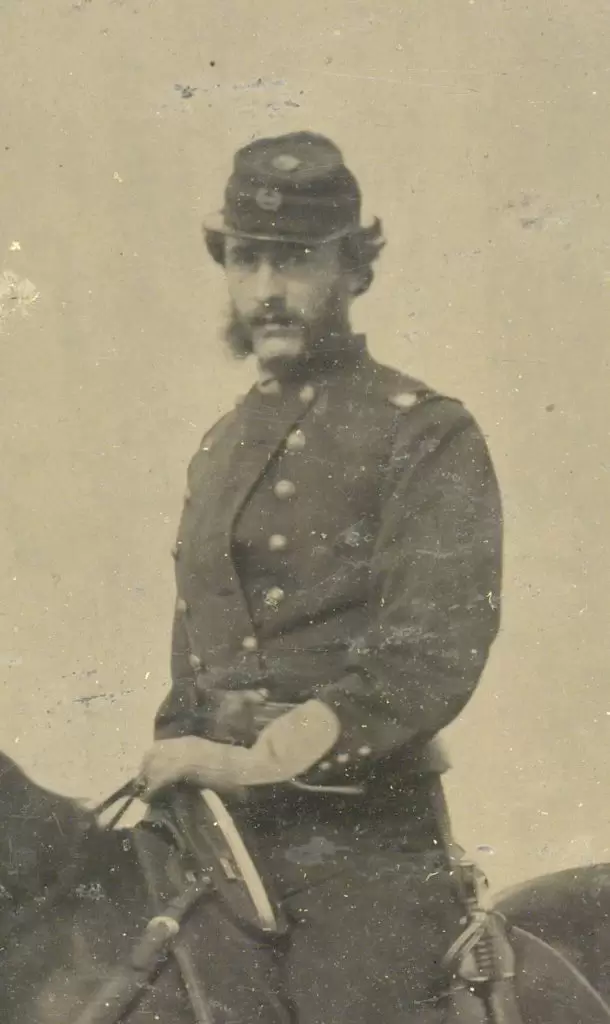
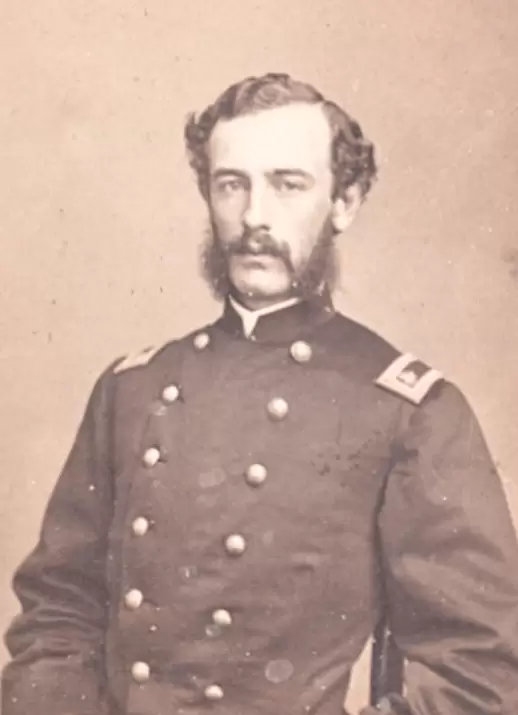
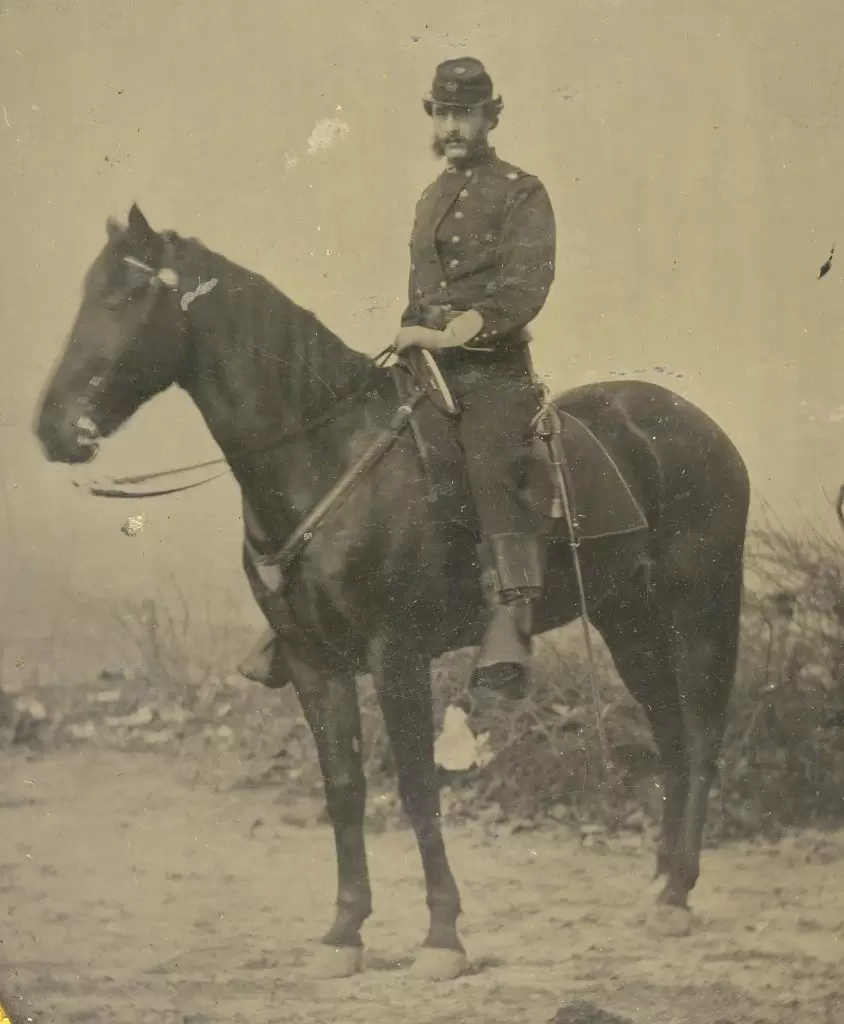
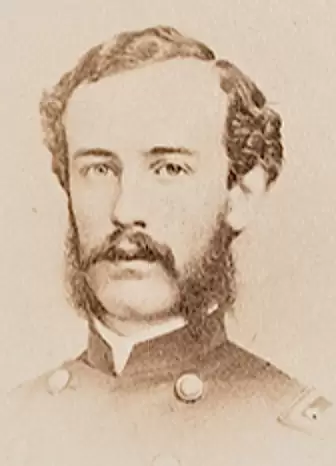
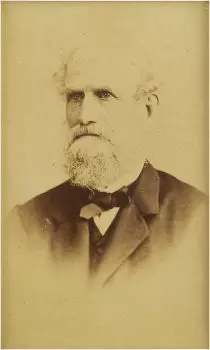
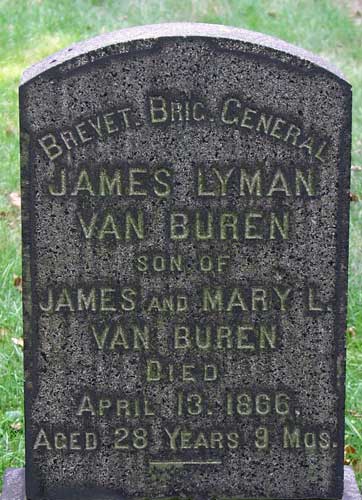
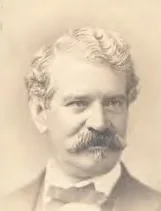
VAN BUREN, WILLIAM HOLME (1819-1883). Physician and member of the United States Sanitary Commission. A nephew of President Martin Van Buren by one account, and the son of a physician, William Van Buren was born in Philadelphia, Pennsylvania (or New York City according to other sources). He entered Yale in 1834, left in his junior year and returned to Philadelphia where he studied and received his medical degree from the University of Pennsylvania in 1840 after spending some time studying in Paris. His thesis on the use of starch dressing for the treatment of fractures was published, an honor for a young medical student. After graduation, he was an assistant surgeon in the United States Army until 1845, ranking first in the exam for that position, married a daughter of renowned surgeon Valentine Mott (see), and was a professor of anatomy at University of New York from 1852-1865. In 1859, he became vice president of the New York Academy of Medicine.
Van Burenwas instrumental in urging President Lincoln and Secretary of War Simon Cameron to establish the United States Sanitary Commission; that was accomplished by executive order on June 9, 1861. Van Buren and a group of doctors, professors and leaders in the health field offered to work without government compensation to ensure the health of soldiers by raising the level of hygiene in military camps and hospitals. Once underway on June 19, the Sanitary Commission was considered a humanitarian triumph that made up for the government’s inefficient Medical Bureau. Nation-wide, its auxiliary women’s groups were active in raising money and supplies for Union soldiers and tending to their needs by emphasizing the preservation and restoration of health of soldiers, providing for the general comfort of troops, and supplying the proper provisions for cooks, nurses and hospitals. The members of the Commission were given a room in Washington, D.C., for meetings and the Commission was given access to communication with the Medical Bureau and the War Department. Although Van Buren was offered the position of surgeon-general of the United States, he declined the appointment. In 1861, he wrote Rules for Preserving the Health of the Soldier, an excerpt of which follows:
As a rule, cuts, even when extensive, are less dangerous to life than they seem; the contrary is true of bayonet and bullet wounds.
Whenever blood is flowing freely from a wound by spurts or jets, there is immediate danger, and, if the wound is situated in one of the limbs, a stout handkerchief or band should be promptly tied loosely around it, between the wound and the heart; a drum-stick, bayonet, ramrod, or jack-knife is to be then inserted between the skin and the bandage, and twisted around until the strangulation of the limb stops the flow of blood, and it should be held thus until the surgeon arrives.
In a less urgent case, or where the wound is differently situated, pressure applied directly to its surface, and kept up steadily, will often save life.
Wounded men should always be handled with extreme care, especially if bones are broken. The medical assistants are always provided with spirits and anodynes.
It is by no means necessary that a bullet should always be extracted; they often remain in the body, and do little or no harm, much less, in fact, than might be done in attempts to remove them.
Even though the work of the Sanitary Commission was lauded, not all of its recommendations were heeded. In May 1863, Van Buren wrote to Secretary of War Edwin Stanton about conditions at Camp Douglas (where Confederate prisoners of war were held) that still were in need of improvement after inspection. He wrote:
More than a year ago the very bad condition of Camp Douglas and its hospital was recognized by the president of the Sanitary Commission on …inspection and reported to Colonel Hoffman, U.S. Army…It was promised by this officer that the evil should be remedied.
By recent reports …from two eminent members of the medical profession employed by the Sanitary Commission as special inspectors of hospitals, it is evident that the improvements promised by Colonel Hoffman have not been made and that the state of the hospitals in question is many degrees worse than when his attention was called to the condition of its inmates.
In a Letter to the Editor of The Evening Post after his death, Van Buren’s was commended for his service to the Sanitary Commission, “…The labor involved in such a duty was immense. It was shared by every member of the Committee, each one of whom gave up unhesitatingly during the war time and strength of great value to him in his particular calling to employ it in this disinterested work of helping the cause of his country.” In traveling to battlefields, meetings, or distributing materials to returned prisoners, “…no one hesitated to go, however great the sacrifice.” The aforementioned letter noted that the Commission met almost every day in New York for the duration of the Civil War and members traveled to Washington, D.C., two or three times a month in 1861. At some point, Van Buren contracted typhoid fever that weakened his health and ultimately curtailed his medical practice and other professional duties. Yale University, in recognition of his service, re-instated him on his class roll, granted him a M.A. in 1866, and, awarded him a law degree in 1879.
Van Buren’s translations of French medical texts (Morel’s Histology and Bernard and Huette’s Operative Surgery) were made available to Union surgeons. In 1868, he became professor of surgery at Bellevue Hospital Medical College, a position he held until his death. Throughout his life, he contributed articles to professional journals and in 1874, co-authored a text on genito-urinary surgery. A consulting surgeon at many New York City hospitals, he headed a venereal clinic in New York City, was a president of the Pathological Society, and a corresponding member of the Paris Society of Surgeons, an honor bestowed on only one American before him. His obituary in the Medical News noted the breadth of his knowledge, his joy in reading Latin classics, his skill as a surgeon, and concluded, “He was a man, take him for all in all, I shall not look upon his like again.” According to one obituary, his funeral drew possibly the largest number of attendees of any medical man in New York. He is buried in the same lot as Dr. Valentine Mott. His last address was 1 Park Avenue in Manhattan. Section 98, lot 6035.
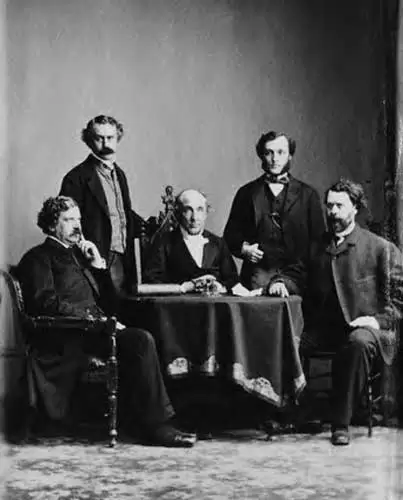
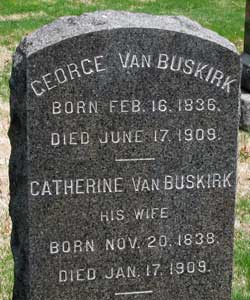
VAN BUSKIRK, GEORGE (1836-1909). Private, 82nd New York Infantry, Company B. A New York native, Van Buskirk enlisted as a private at New York City and mustered into his company of the 82nd New York on July 14, 1861. A month later, he was discharged for disability on August 18, 1861, at Poolesville, Maryland. According to the 1870 and 1880 censuses, he worked as a policeman; the 1900 census notes that he had retired. His last residence was at 193 Prospect Avenue in Brooklyn. Section 130, lot 31571, grave 1.
VAN BUSKIRK, JAMES A. (1842-1863). Private, 10th Battery. A New York native, he enlisted as a private at New York on February 5, 1862, and mustered into the 10th Battery. He is listed as having deserted from the hospital on June 6, 1862, though that may not have been the case. Van Buskirk died from consumption on January 7, 1863, at his home at 55 Greene Avenue. Section 115-116, lot 4196, grave 779.
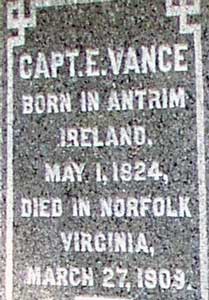
VANCE, EZEKIEL (or EZIKEL) (1824-1909). First lieutenant, 12th Regiment, New York State Militia, Company H. Born in Ireland, he enlisted at New York City for three months on April 19, 1861, was commissioned into the 12th Regiment on May 2, and mustered out with his company on August 5 at New York City. A wine and spirit merchant, he was a member of the G.A.R. In 1901, while living in Virginia, he applied for a pension; it was granted, certificate 1,023,448. He lived in Norfolk, Virginia, at the time of his death. Section 29, lot 13349.
VANCE, JR., JOHN (1844-1867). Private, 19th Regiment, New York State National Guard, Company E. A native of Ireland, Vance enlisted as a private at Newburgh, New York, on May 26, 1862. He mustered into the 19th Regiment the next day and mustered out after three months on September 6, 1862, at Newburgh. His last address was 861 Pacific Street in Brooklyn. Section 127, lot 140838, grave 64.
VAN CLEEF (or VAN CLEAF, VAN CLEIF, VAN CLEFF), FREDERICK M. (1844-1906). Sergeant, 56th Regiment, New York State National Guard, Company D; private, 21st New Jersey Infantry, Company K. A New York City native, his name appeared under numerous spellings on official documents. He was a merchant according to the 1850 census. After he enlisted as a private on August 28, 1862, he mustered into the 21st New Jersey on September 15, and mustered out on June 19, 1863, at Trenton, New Jersey. He re-enlisted as a sergeant on July 11, 1864, mustered into Company D of the 56th New York National Guard, and mustered out after 100 days on November 6.
As per the 1870 census, Van Cleef was employed as a bank clerk. His application for an invalid pension was granted in 1897 under certificate 1,116,493. He last lived at 423 1st Street in Brooklyn. Although his widow applied for a pension, application 1,092,890 in 1917, it was never certified. Section 151, lot 16343.
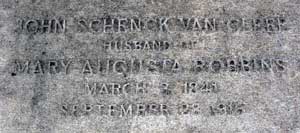
VAN CLEEF, JOHN SCHENCK (1841-1916). Second lieutenant, 13th Regiment, New York State National Guard, Company H. A Brooklynite whose family had long roots in the region, Van Cleef’s grandfather came from Holland and settled first in Monmouth County, New Jersey. He was one of the first students at Poly Prep in Brooklyn.
During the Civil War, Van Cleef served as a second lieutenant for three months with the 13th Regiment (Heavy Artillery) in 1862, enlisting and being commissioned in at Brooklyn on May 28, and mustering out on September 12. According to his obituaries in The New York Times and the Evening Post, he attained the rank of captain at the end of the War but that is unverified; the Brooklyn Daily Eagle cites that he attained but never used that rank.
His father-in-law, Daniel Robbins, was one of the biggest builders in Brooklyn. After Robbins died, Van Cleef was executor of his estates in South Brooklyn and Brooklyn Heights. He was also a cap and hat manufacturer and headed the firm, Van Cleef & Nutman in Manhattan. One of his sisters-in-law was married to Thomas S. Dakin (see), a captain of the 13th Regiment. A member of the Hamilton Club ad the Crescent Athletic Club, he last lived at 71 Livingston Street in Brooklyn. Section 64, lot 3631.
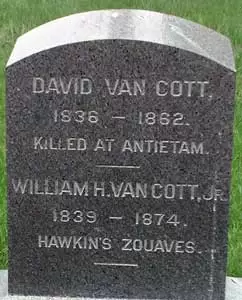
VAN COTT, DAVID (1836-1862). Corporal, 9th New York Infantry, Company A. Van Cott is not buried at Green-Wood; a cenotaph in the family’s lot honors his memory. David Van Cott, a relative of William Van Cott (see), was a pattern maker according to the census of 1860 and lived in New York City. He enlisted as a private on April 23, 1861, at New York City, mustered into the 9th New York on May 4, and was promoted to corporal on August 19 of that year. Mortally wounded on September 17, 1862, at the Battle of Antietam, he succumbed to gunshot wounds nine days later at Smoketown, Maryland. His widow’s request for a pension increase in 1916 indicates that he was a color sergeant at the time of his death.
On November 25, 1862, Catharine Van Cott, applied for and received a widow’s pension under certificate 53,667. In 1866, she asked for an increase in her pension of $8 a month; it was increased by $2 a month. Ida Van Cott, his daughter, received a minor’s pension of $8 a month in 1870, when her mother remarried, certificate 147,607. Catharine Van Cott Parkerton’s pension resumed when her second husband died in 1912; at the time of her death in 1924, her pension was $24 a month.
David Van Cott is buried at Antietam National Cemetery in Sharpsburg, Maryland, grave 847. His cenotaph at Green-Wood is inscribed, “Killed at Antietam.” He was related by marriage to Louis Hallen (see) who is buried in the same lot. Section G, lot 18611.
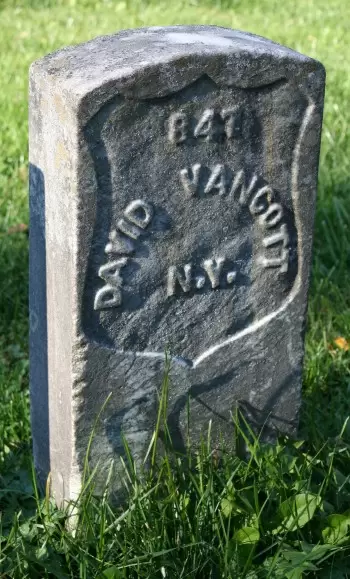
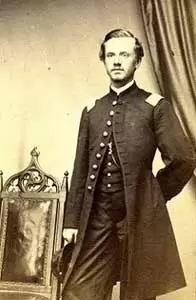
VAN COTT, LEONARD BOOLE (1844-1862). Second lieutenant, 119th New York Infantry, Company I. A resident of 238 East 10th Street in Manhattan, Van Cott was a student at The Gunnery in Washington, Connecticut, prior to his Civil War service. He enjoyed playing baseball at the school where the game was introduced in the 1850s. Van Cott’s father, Judge William Hathaway Van Cott, was elected president of the National Association of Baseball Players, the game’s first governing body, in 1858. The headmaster and students of The Gunnery presented Leonard Van Cott with a sword on August 16, 1862, in an elaborate and festive ceremony that was the custom of the day for a commissioned officer. (The Van Cott family still owns the sword today.) Prior to receiving the sword, Leonard wrote of it in his diary as a “gift which I shall prize more highly than if it came from almost any other parties….This looks like a good beginning: Lieutenant at 16 with the presentation of a sword.” An article in the Litchfield Enquirer on August 21, 1862, detailed the event and printed his speech upon receiving this gift. Van Cott was given the blessings of his school:
Lieutenant: In presenting you this sword, it is hardly necessary for me to say before this audience, that you will do honor to it: for, from what we know of your past life, we feel assured of this. In the long weary march in pursuit of the foe, (for we hope you will never march in retreat), when dispirited, hungry, without food, think of the good old time we have had in Washington; think of your school-mates, and remember that we are all watching and praying for your success and glory. Think of the young ladies, and I trust your heart will not be carried away by any of the Southern beauties who shoot at our wounded and weary soldiers from their parlor windows while passing through the streets. Think of our Teacher, and cherish the ardent love of Liberty, which he has instilled into our hearts. In presenting you, Lieutenant, this beautiful but terrible gift, we hope and trust that you will return to us, perhaps bearing honorable scars, and show us once again your sword, sheathed, never to be drawn from its scabbard, till the present generation has passed away.
Leonard Van Cott then addressed the audience:
Teacher and School-Mates; Ladies and Gentlemen: Whatever may be my fortune, the feelings of pleasure and gratification which I now experience can never be surpassed. To receive from the hands of my beloved teacher and schoolmates this token of their friendship, inspires me with the desire to prove more worthy of it and them. I cannot hope to express, as I would wish, my thanks; but to my Teacher I would say that it would please God to put me before the enemy, fidelity to the principles which he so firmly and justly holds, and which will always influence me, will nerve me to strike with a stronger arm my weak blow at this Rebellion.
To my schoolmates, for this token of their affection, I render my heartfelt thanks; and I trust and know, that when you have the strength, if your country needs, you will also the will, to go fight her battles.
To all—to Washington [Connecticut]-my thanks are due to the happy years I spent in her society. And were it not to the defense of my Country, the saddest moments of my life would be when I leave its pleasant families, maybe never to return. But I trust that I shall return once more to enjoy your companionship. Let me conclude with the hope that Washington will remain ever as now the “good old Washington.”
He enlisted at New York City on August 25, 1862, and was commissioned into the 119th New York, also known as the Halleck Guard, as a second lieutenant, on September 10. On December 3, 1862, he died of typhoid fever at Centreville, Virginia. His father, Judge William Van Cott, traveled to Centreville to be with his son at the end of his life, wrote a letter to William Gunn, a lawyer and headmaster of the Gunnery, thanking him for his expression of condolence. Although the lengthy letter details his journey to be with his son, Leonard’s final day, and his feeling about the War, the opening sentences, below, sum up his feelings of loss.
I am as one in a dream! I saw our poor Leonard die, and I saw him buried, but yet I cannot realize that I never shall see him again. It seems impossible to give up the idea that I must see him and hear his voice again, and it is only by the sternest and most careful thought that I can full realize that the loss is actual and irremediable. When I look back to last spring and remember the part he took in your celebrations and more lately, the sword presentation, preceded by the game of Ball, the most active and strong of all engaged, how can it be, I ask myself, that he is now silent, speechless and dead! He was a noble boy! Meanness and falsehood were as unknown to his soul as to that of the purest angel! The noblest epitaph that can be placed upon his tombstone is that I never knew him to tell a lie. I relied as implicitly upon his word, as I did upon any declaration of God’s holy word. I always had a different feeling towards him, from that which I felt toward my other children. Not that I am conscious of having loved him more or having been improperly partial towards him, but he always seemed to me, at least for several years, so manly and intelligent, that I felt he was more of a companion, than either of my other boys, although two of them were older than he….
Van Cott’s brother, William H. (see), also served in the Civil War. In 1890, his father, who was also a leader in the temperance movement in New York State, applied for and was granted a pension under certificate 349,445. Section 92, lot 3453.
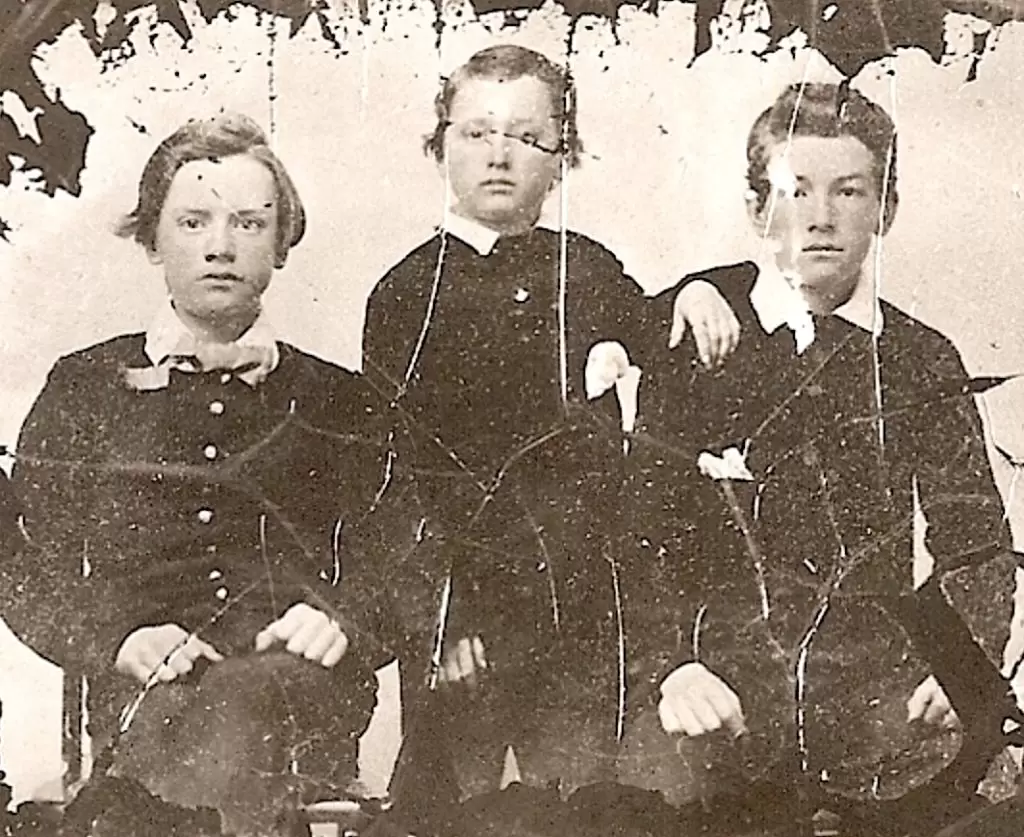
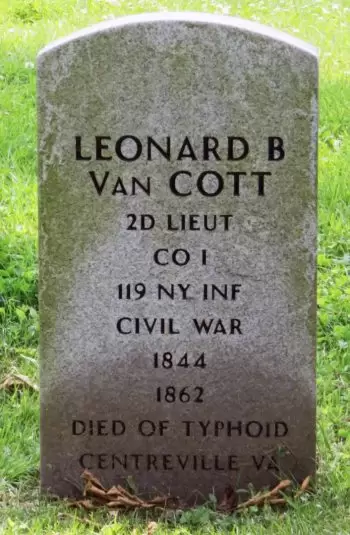

VAN COTT, JR., WILLIAM H. (1839-1874). Private, 9th New York Infantry, Companies A and E. A native of New York City, he enlisted there as a private on April 23, 1861, mustered into Company A of the 9th New York on May 4, and was transferred into Company E on January 1, 1862. Van Cott was wounded on April 19, 1862, at Camden, North Carolina, hospitalized at Washington, D.C., and mustered out on May 20, 1863, at New York City.
William’s brother, David Van Cott (see), who was in the same regiment and who was mortally wounded at Antietam, Maryland, is honored with a cenotaph in the family’s lot. Van Cott was related by marriage to Louis Hallen (see) who is buried in the same lot. He last lived at 530 Hicks Street in Brooklyn but died of carditis at the Hamilton Ferry-house after suffering a seizure there. Section G, lot 18611, grave 2.
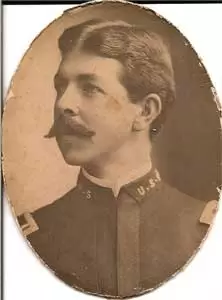
VAN COTT, JR., WILLIAM HATHAWAY (1843-1923). Second lieutenant, 15th New York Infantry, Company C; 102nd New York Infantry, Company H. He was born in New York to a well-known family whose roots in New Amsterdam can be traced back to 1654. His father, Judge William Hathaway Van Cott, was elected president of the National Association of Baseball Players, the game’s first governing body, in 1858. His uncle, Thomas Van Cott, was a baseball pitcher for the Atlantic Baseball Club of Brooklyn. A brother of Leonard Van Cott (see), he was also educated at The Gunnery, a preparatory school in Washington, Connecticut.
William Van Cott enlisted at Mount Vernon, New York, on April 6, 1864, and was commissioned into the 15th New York on June 6, 1864. On July 7, 1864, he mustered out at Fort Richmond, New York Harbor. He re-enlisted at New York City on August 8, 1864, was commissioned into the 102nd New York two weeks later on August 25, and mustered out at New York City on November 13, 1864. He had prior service in the 17th New York Infantry, Company C.
According to the censuses of 1900 and 1920, Van Cott was living in New York where he was employed as a teacher. His obituary in The New York Times confirms his military service and notes that he was a public school teacher in New York City for 44 years. In 1906, he applied for and received a pension under certificate 1,130,564. At the time of his death, he lived at 51 Fiske Avenue in the West New Brighton section of Staten Island, New York. In 1923, Janet Van Cott, who is interred with him, applied for and was granted a widow’s pension, certificate 936,329. Section 92, lot 3453.

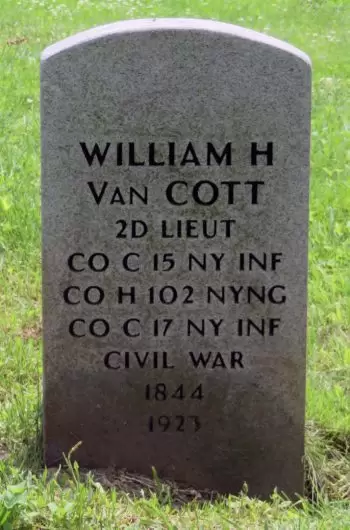
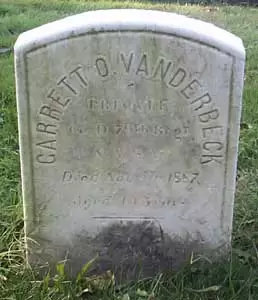
VANDERBECK (or VANDERBEEK), GARRETT (or GARRY) ODELL (1844-1887). Private, 79th New York Infantry, Companies E and D. Vanderbeck descended from a very early Brooklyn family, dating back to Paulus Vender Beeck, who arrived in New Amsterdam circa 1640, and who owned the land that would become Ocean Hill in Green-Wood Cemetery. Although soldier records show him to have been 28 years old at the time of his enlistment, he was, in fact, only 18. After enlisting as a private on May 13, 1861, at New York City, he mustered into the 79th Infantry, also known as the Highlanders, on May 28, transferred to Company D on December 22, 1861, served as regimental armorer, and mustered out on May 31, 1864, at New York City.
According to the census of 1870, which listed him as Garry Vanderbeck, he was employed as an iron rail maker (though another source lists his profession as engineer). The Veterans Schedule for 1890 confirms his military service. His brother, John Jacob Vanderbeck (see), also served in the Civil War. He last resided at 222 Hamilton Avenue in Brooklyn. In 1892, Silas Dutcher applied as a guardian for a minor’s pension, application 543,680, but there is no certificate number. Section 3, lot 18372, grave 49.
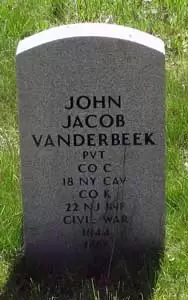
VANDERBECK (or VANDERBEEK), JOHN JACOB (1844-1867). Private, 22nd New Jersey Infantry, Company K. After enlisting as private on September 4, 1862, Vanderbeek, who was born in New Jersey, mustered into the 22nd New Jersey on September 22, and mustered out on June 25, 1863, at Trenton, New Jersey. He died of an abscess on June 29, 1867. He was the brother of Garrett Vanderbeck (see). As per his death certificate, which spelled his name as Vanderbeck, he was single and worked as an iron railing maker. He last lived at 308 West 16th Street in Manhattan. Section 121/126, lot 11189, grave 107.
VANDERBILT, AARON (1844-1913). Acting ensign, United States Navy. Born in Tompkinsville, Staten Island, he was a distant relative of Cornelius Vanderbilt, and great-grandson of John Vanderbilt, one of the first members of the New York State Legislature. His family lineage can be traced back to 1650 in Flatbush, Brooklyn. He was educated at schools in Staten Island and Brooklyn. In 1859, he left school and became a clerk in a shipping concern. He was 5′ 7″ tall with brown eyes, brown-black hair, a dark complexion, and a slight scar on his forehead.
During the Civil War, Vanderbilt enlisted as a master’s mate in the United States Navy at Brooklyn on July 20, 1863, serving on the Vicksburg and Savannah, then became an acting ensign as of February 1, 1865. He took part in the Battle of Fort Fisher, North Carolina (December 23-25, 1864, January 13-15, 1865); the siege of Wilmington and Cape Fear, North Carolina (February 22, 1865); and the siege of Petersburg and Richmond, Virginia, onboard the USS Malvern. According to his biography at the New-York Historical Society and his obituary in The New York Herald, he was a fleet signal officer after the Siege of Wilmington, but that is not noted on any of his extensive pension records. On April 4, 1865, he helped escort President Lincoln on his visit to Richmond after its fall.
After his discharge on October 12, 1865, he rejoined his shipping business in Brooklyn, spending 1867 in Jacksonville, Florida, where he had a line sailing packets (small boats shipping mail and freight) between the two ports, before returning to Brooklyn. In 1869, he married Lillie Wheeler. In 1877, he was appointed general superintendent of the Ward Steamships, also known as the New York & Cuba Mail Steamship Company, and subsequently was a founder of the American Shipping and Industrial League. He was also the vice president of the Wheeler Condensor and Engineering Company. The census of 1880 confirms his employment in the shipping business.
Remaining active in military affairs, Vanderbilt served as part of the honor guard for President Grant’s burial in 1885, was instrumental in securing passage of the act establishing the New York State Naval Militia in 1889 and served during the Spanish-American War as senior officer in command of New York’s naval force. As per one obituary, he was known as the “Father of the Naval Reserve.” An article in The New York Times on June 16, 1889, quoted Vanderbilt in describing the purpose of the aforementioned act establishing the Naval Reserve, “…The intention is to utilize as a naval war force the various men in ports who have a knowledge of seamanship….The militia will be instructed just as sailors of the navy are except that their education will be confined pretty closely to such work as is particularly needed in coast defense.…” He later became chief of ordnance for the New York Naval Reserve from which he retired with the rank of lieutenant commander. The Veterans Schedule of 1890 verifies his Civil War service. In 1897, Vanderbilt applied for and received a pension from the Navy citing inability to perform manual labor, certificate 37,933. The pension was increased in 1906 and 1912. The latter pension application noted that he had an insurance policy with the Equitable Fund and another with the New York Produce Exchange Gratuity Fund, whose membership fees were paid by his daughter as of 1906. In 1912, he wrote on the application for a pension increase that he owned no property and his net worth of $10 consisted of a broken watch and some old clothes.
Vanderbilt retired from business in 1905. He was a member of many societies including the Merchant Marine League of the United States, the Society of the Army of the Potomac, the United States Navy League, the New York Board of Trade, the American Society of Mechanical Engineers, the Grand Army of the Republic, and the Military Order of the Loyal League. His work with the Maritime Society led to the establishment of the International Maritime Congress in Washington, D.C., an organization that protects life and property at sea. He last lived in Remsenburg, New York, at the home of his daughter, Lilian Vanderbilt Speir, who kept detailed paperwork noting her expenses for his medical care, his funeral, and written communication regarding his pension. He was also survived by another married daughter. A scrapbook of his papers including material from the Civil War from a naval perspective is on file at the New-York Historical Society. Section 52, lot 4766.
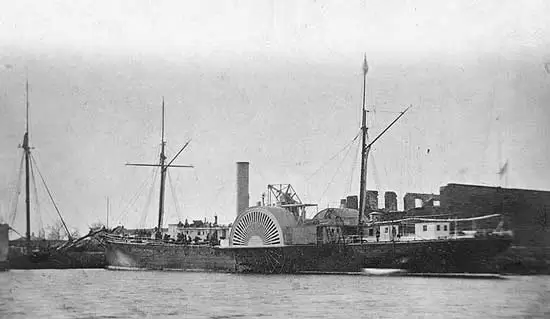
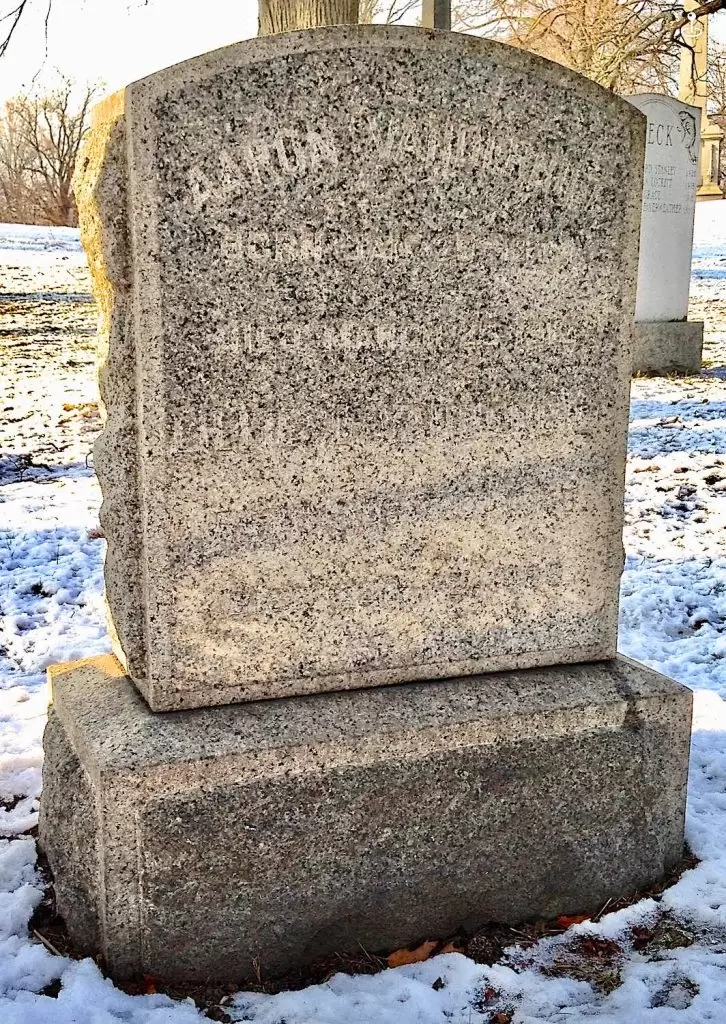
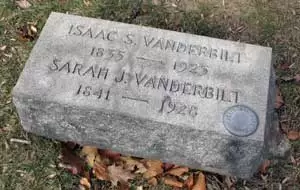
VANDERBILT, ISAAC STEVENS (1835-1925). Private, 7th Regiment, New York State Militia, Company B. Vanderbilt served in the 7th Regiment, New York State Militia, for 30 days in 1861, and then again for three months in 1862 when the 7th was part of the National Guard. He applied for a pension in 1905, certificate 1,119,495. At the time of his death, he lived in Englewood, New Jersey. Sarah Vanderbilt, who is interred with him, applied for and received a widow’s pension in 1925, certificate 969,061. Section 69, lot 2004.
VANDERBILT, JEREMIAH (1840-1880). Sergeant, 1st Infantry, United States Army, Company H. Vanderbilt, who was born in New York, was a clerk at the time of his enlistment. He was 6′ 1″ tall with hazel eyes, brown hair, and a fair complexion. After he enlisted as a sergeant on an unknown date, Vanderbilt served in Company H of the 1st Infantry, United States Army. He was discharged on February 25, 1865, at New Orleans, Louisiana.
According to the census of 1870, he was a clerk in a shoe store and had a personal worth of $2,000. An advertisement in the Brooklyn Daily Eagle on September 28, 1871, alerts readers to look out for the grand opening of a new boot and shoe store under J. Vanderbilt’s proprietorship at 78 Court Street in Brooklyn. At the time of his death, he lived at 472 State Street in Brooklyn.
His last will and testament, which was submitted to King’s County Surrogate’s Court, notes that his estate consisted of the stock and fixtures of the aforementioned shoe store valued at $8,000. Eliza Townsend Vanderbilt, applied for a widow’s pension in 1888, application 377,862, but there is no certificate number. In 1890, a minor’s pension, filed by Gary H. Cannell, guardian, was granted under certificate 270,116. Section 64, lot 4071, grave 514.
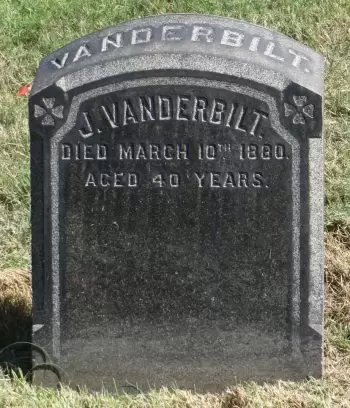
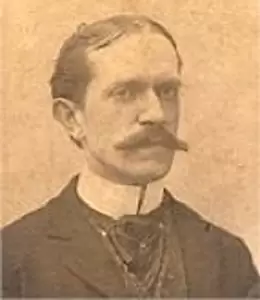
VANDERBILT, JOHN (1821-1894). First sergeant, 48th New York Infantry, Companies B and C; private, 13th Regiment, New York State Militia, Company H. A New York City native, he first served in the 13th Regiment as a private for three months in 1861. He then enlisted at Brooklyn as a private on August 25, 1861, and mustered into Company B of the 48th New York on September 5. On July 10, 1863, he was severely wounded in the leg at the assault on Morris Island, South Carolina. He became a sergeant at some point and then was promoted to first sergeant on September 21, 1863. In 1863, he was wounded in the jaw at Olustee, Florida, and suffered a permanent disability that eventually caused his death. Although he could have been discharged for disability, he declined and served out until the expiration of his term. During his service in the 48th, he was transferred to Company C. He was discharged on April 20, 1864.
In civilian life, he was treasurer of Castle Garden, an entertainment venue at the Battery where Jenny Lind and Catherine Hayes performed. Vanderbilt was a member of the James H. Perry Post #89 of the G.A.R. In 1879, his application for an invalid pension was granted, certificate 209,509. His last residence was 119 Waverly Avenue in Brooklyn. His wife applied for and received a widow’s pension, certificate 427,083. Section 24, lot 6921, graves 1 and 2.
VANDERHOEF (or VANDERHOFF, VANDERHOEFF), PETER (1814-1888). Fireman, United States Navy. Born in Brooklyn, Vanderhoef was a cartman according to the census of 1860 whose personal worth was $200. He was 5′ 9½” tall with light hair and eyes. He shipped from Old Point Comfort, Virginia, at age 51, on the USS Commodore Barney, where he served as a fireman. He was discharged from the service due to disability. In a letter written from Hampton Roads, Virginia, on December 5, 1862, Surgeon Delavan Bloodgood (see) wrote that Vanderhoef was suffering from amaurosis (vision loss), a pre-existing condition, and his wishes to be discharged from duty were approved.
The census of 1870 lists Vanderhoef’s occupation as keeper of a fish stand. In 1886, his application 11,613 for an invalid pension from the Navy, citing eye problems, was rejected. He said that the excessive heat and lack of ventilation in the fire-room permanently damaged his eyes and at present, he could not safely cross the street or read fine print. The August 15, 1887, rejection from the Navy Pension Bureau stated, “…the alleged disease existed from the time of enlistment…” He last lived at 670 Warren Street in Brooklyn.
In 1890, Catharine Vanderhoef, his second wife, was awarded a widow’s pension of $8 a month under certificate 11,346. However, her application was subsequently fraught with controversy for many years because she apparently did not have the proper official marriage records. Numerous legal papers confirming their living together as husband and wife since 1860, the lack of any divorce, and no previous marriages by Catherine Vanderhoef were submitted to the Navy Pension Bureau under case 9,527. Section 4, lot 21316, grave 369.
VANDERPOEL, ANN PRISCILLA (1814-1871). Finance Committee member and founder, Ladies Home U.S. General Hospital. Ann P. Vanderpoel, who also used her husband’s name, Mrs. Edward Vanderpoel, was a native of London, England. She immigrated to the United States with her family in 1833 and married Dr. Vanderpoel four years later. In 1861, she was instrumental in founding and supporting the Ladies Home U.S. Hospital, a facility for sick and wounded soldiers at Lexington Avenue and 51st Street in Manhattan. The women who founded the institution in April 1862 sustained it until July of that year when it was taken over by the government. Her work was recognized by President Abraham Lincoln who sent her an engraved certificate memorializing her work. Her devotion as a nurse led her to be known as the “Florence Nightingale of New York.”
During the Draft Riots of July 1863, Vanderpoel helped save Mayor George Opdyke’s house by riding through the mob in an open carriage to the police station on Mulberry Street to secure soldiers who came to the aid of the mayor. In an article in The New York Times, dated May 5, 1864, she delivered the report of the Finance Committee at a second anniversary reception for the soldiers who were tended to at the Ladies Home Hospital. At the 1864 reception, Mrs. Vanderpoel thanked Dr. A. B. Mott (see) for his efforts running the facility and to the public who gave generously to support the hospital after the government takeover at which time four of the seven founding women left with the money and books, leaving a debt of more than $3,000 which ultimately was repaid by Mott ($2,850) and the rest by the three remaining women. In 1864, there was $1,520 balance in the treasury after expenses. A basket of flowers was presented to Mrs. Vanderpoel for her work on behalf of the hospital. Her last residence was 133 Macdougal Street in Manhattan. She died from an abscess.
In advance of Decoration Day, 1876, a detail from the Abraham Lincoln Post #13 of the G.A.R. planted an American flag on her grave on Grove Avenue in Green-Wood. The article in the Brooklyn Daily Eagle, dated May 29, 1876, confirmed that Mrs. Vanderpoel had previously received an engraved certificate for her work that was ordered by President Lincoln and signed by Surgeon General Barnes. Benjamin Vanderpoel (see) was a nephew by marriage. Section 74, lot 1785.
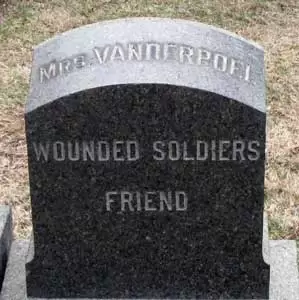
VAN DERPOEL (or VAN DERPOLE, VANDEROOL), BARENT (or BARRET) (1842-1862). Second lieutenant, 40th New York Infantry, Company H. Born in New York State, he enlisted as a second lieutenant at Washington, D.C., on February 6, 1862, and was commissioned into the 40th New York that day. Wounded in action at White Oak Swamp, Virginia, on June 30, 1862, he succumbed to his injuries on August 3, 1862, at Fort Hamilton, New York Harbor.
On January 13, 1863, an article in The New York Times, “Another Blunder: A Dead Officer Is Dismissed From the Service,” noted that Van Derpoel was mistakenly dismissed as an officer instead of his vacancy being listed as having been caused by his death. He was immediately reinstated when Colonel Egan of the 40th New York realized he made the error, not having known of Van Derpoel’s sickness and wounds. Egan attested to Van Derpoel’s unblemished reputation and his courage at Williamsburg, Virginia, when he led his troops and rallied his men toward victory. In 1870, his mother applied for a pension under application 183,939, but there is no evidence that it was certified. Section 11, lot 4620.
VANDERPOEL (or VANDERPOOLE, VANDERPOOL), BENJAMIN W. (1836-1878). Captain, 59th New York Infantry, Company G; second lieutenant, 4th New York Heavy Artillery, Companies D, H, E, and F. A native New Yorker from a prominent family, Vanderpoel traveled to Europe in 1859, describing the cultural details in extensive letters to his mother. A year later, he was a student of law according to the census of 1860. He was 5′ 6″ tall with gray eyes, brown hair and a fair complexion. On November 20, 1861, Vanderpoel, who was also borne on the rolls as Vanderpool, enlisted as a first lieutenant at New York City, and was commissioned into the 59th that day.
The Vanderpoel Family Annals And Household Memories – Volume II by George Burritt Vanderpoel includes recollections of his trip with his father to Washington, D.C., to see Benjamin (his older brother) at the 59th’s encampment in the spring of 1862. (The elder Vanderpoel, who harbored some sympathies with the South, kept his feelings to himself.) At the time of the family visit, Benjamin was healthy, in good spirits, and hadn’t seen any action. He was promoted to captain on February 18, 1863, and was discharged for disability on May 28 of that year. The family annals cited wounds and hardship in Southern prisons as the reasons for his disability discharge.
On February 16, 1864, Vanderpoel re-enlisted as a private at the 7th District of New York. That same day he mustered into Company D of the 4th New York Heavy Artillery. He was transferred to Company H upon his promotion to second lieutenant on January 8, 1864. Subsequently, he transferred to Company E on July 29, 1864, and was listed as missing from Reams’ Station, Virginia, on August 25. In fact, he had been taken prisoner and was held subsequently at Libby, Salisbury and Danville Prisons. The Family Annals notes that at one point, the elder Vanderpoel paid $200 for a ham and $50 for boots to a “sordid spirit” when his son was starving and suffering in prison. (The true value of the goods was $20). Benjamin’s father sought to facilitate his son’s exchange from Andersonville and went to meet him at Annapolis, Maryland, in the fall of 1864 after receiving word of his release. The father was astonished at his son’s pathetic condition after nine months of deprivation and said, “He looked like one who had risen out of the grave.” The elder Vanderpoel never again mentioned any sympathy for the Confederates. Although Benjamin Vanderpoel returned to his company after being restored to health, the effects of exposure and hardship resulted in chronic medical issues. He transferred into Company F on February 26, 1865, and transferred back to Company H on May 19, 1865, before he mustered out on September 26, 1865, at Washington, D.C.
On September 27, 1867, he enlisted as a landsman for three years in the United States Navy, listing his occupation as lawyer. Ann Priscilla Vanderpoel (see) was his aunt by marriage. He last lived in Antwerp, Belgium, where on April 25, 1878, he wrote home that he was “skin and bones,” did not fear death and wished to be buried by charity. First buried at the cemetery of the Hospital of Saint Elizabeth there, his family visited there in June 1878, made a contribution to the sisters for their care and arranged for the body to be removed to the family plot at Green-Wood. According to his gravestone, he died “from wounds and disease incurred during the War of the Rebellion.” His gravestone also confirms that he was confined as a prisoner of war at Libby, Salisbury, and Danville Prisons. Section 74, lot 1785.
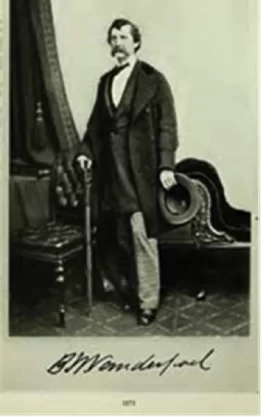
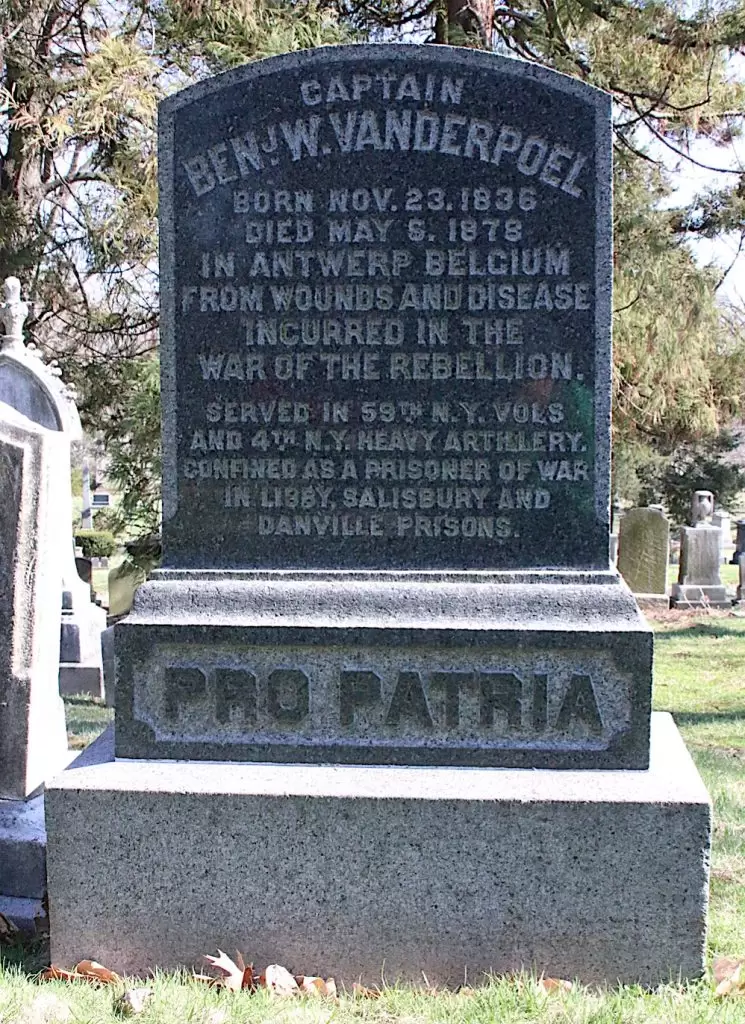
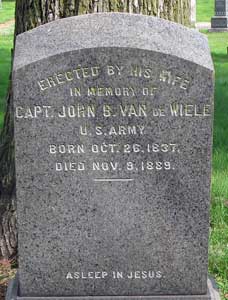
VAN DE WIELE, JOHN BABTISTE (1837-1889). Major by brevet; captain, 4th New York Artillery; corporal, 8th Regiment, New York State Militia, Company E. Van De Wiele began his service in the 8th New York State Militia where he served as a corporal from April 25 to August 2, 1861. He then re-enlisted as a first lieutenant on November 1, 1861, and commenced serving in the 4th New York Artillery where he was promoted to captain on August 2, 1862, and mustered out on February 1, 1865. The next month, on March 13, he was brevetted to major, “for gallant and meritorious service during the War.”
Two months later, on May 20, 1865, Van De Wiele joined the 1st United States Veterans as a first lieutenant, was promoted to captain on August 24 of that year when he was transferred to the 8th United States Veterans, and mustered out on April 28, 1866. Resuming military service on January 22, 1867, he became a captain in the 10th Cavalry and was brevetted major on March 2, 1867, “for gallantry and meritorious service in the Battle of Reams Station, Virginia.” He retired from the military on March 20, 1879. Van De Wiele last lived at 21 East 133rd Street in Manhattan. His death was caused by nephritis. Section 180, lot 13587.
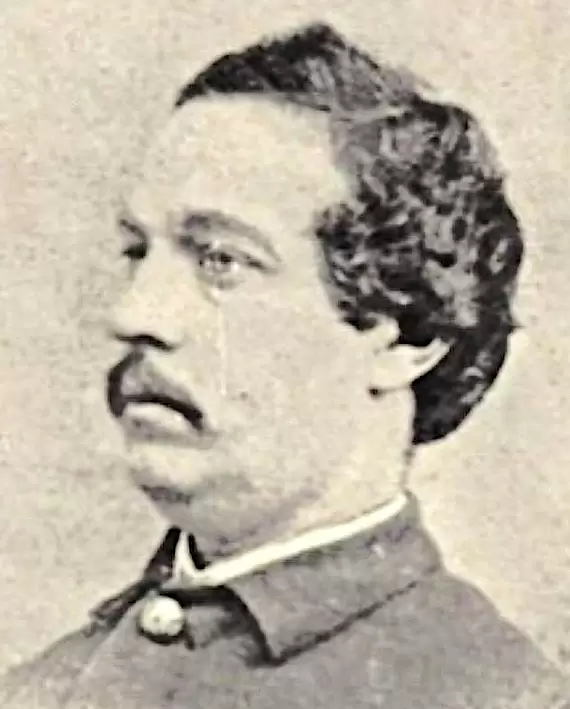
VAN HOESEN (or HEUSEN), GEORGE M. (1836-1909). Major, 13th Iowa Infantry, Company E. Born in New York City, he was a descendant of an old Dutch family whose roots could be traced back to New Amsterdam. A graduate of the University of the City of New York, class of 1852, he subsequently studied at the State and National School of Law at Poughkeepsie, New York, taught pleadings and evidence there, then moved to Davenport, Iowa, where he set up his practice and worked as a newspaperman for the Iowa State Democrat.
At the onset of the Civil War, Van Hoesen helped raise a company in 1861, and was commissioned captain of the 13th Iowa Infantry on October 28. Serving under General Ulysses S. Grant in Missouri, he was promoted to major on April 17, 1862, in recognition of his gallantry at the Battle of Shiloh, Tennessee. He also participated in the capture of Vicksburg, Mississippi. At one point, he was provost marshal for the armies in the field in the Department of the Missouri. He mustered out on January 21, 1863, at Memphis, Tennessee.
Returning to New York City to practice law after his military service, Van Hoesen was elected judge of the Court of Common Pleas in 1875, as a Democrat, for a 14-year term. An article about him in The New York Times on October 3, 1901, noted that he was among the first New Yorkers to advocate for an elevated railroad, a measure that passed in the State Assembly but was defeated in the Senate. That same article stated that he had been chairman of the Tammany Hall General Committee for the past several years. In 1901, he made an unsuccessful run for president of the Board of Aldermen on the Tammany ticket. After resuming his practice at the expiration of his judgeship, he became a trustee of the Holland Trust Company and a founder and president of the Holland Society.
Van Hoesen was a member of the G.A.R.’s Lafayette Post #140 and chairman of its Memorial Committee. Among the other civic organizations to which he belonged were the Union Club, the St. Nicholas Society, the Zeta Psi Fraternity, and the New York, Liederkranz, Lotos, and Amsterdam Clubs. He last resided at 320 Central Park West in Manhattan. He succumbed to Bright’s disease. Section 114, lot 17418, grave 3 and 4.
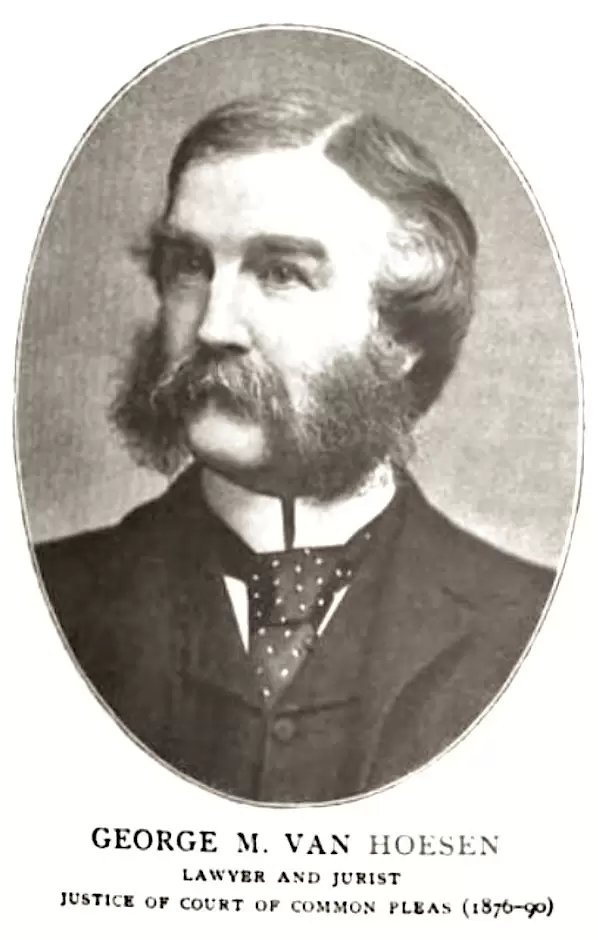
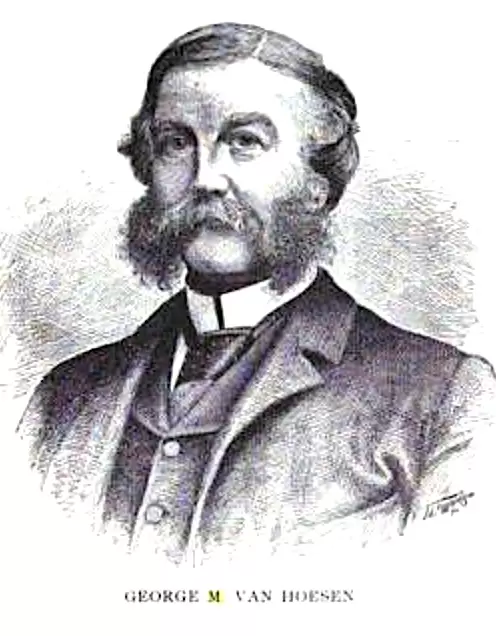
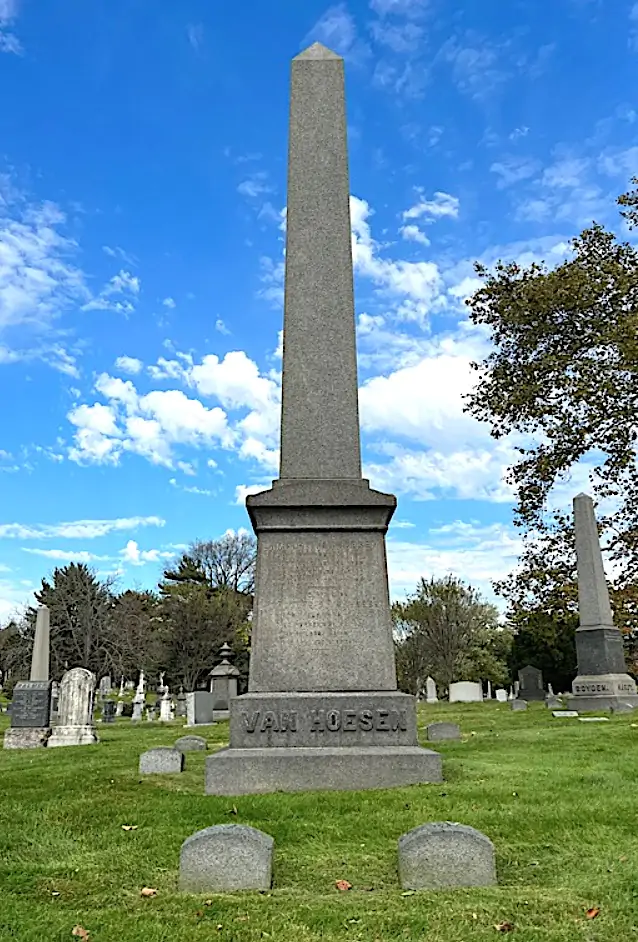
VAN HORN, BARNARD (or BERNARD) E. (1833-1911). Corporal, 139th New York Infantry, Company G. Born in New York State and a carpenter by trade, Van Horn enlisted at Brooklyn as a corporal on August 25, 1862, and mustered into the 139th New York on September 9, 1862. On February 1, 1864, he was reduced in rank to private. He was wounded at the Battle of Cold Harbor, Virginia, on June 1, 1864, and mustered out on May 26, 1865, at Washington, D.C. In 1884, he applied for and received an invalid pension citing rheumatism, certificate 293,236. In 1906, when he entered the Soldiers’ Home in Bath, New York, his last residence, he was 5′ 8″ tall with gray hair and eyes, a light complexion, and was unable to read or write. Section 136, lot 28307, grave 447.
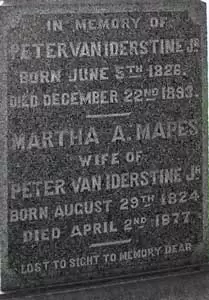
VAN IDERSTINE, JR., PETER (1826-1893). Private, 7th Regiment, New York State National Guard, Company I. A native New Yorker, he enlisted there on May 25, 1862, but apparently did not muster in at that time. When the 7th Regiment was activated in 1863, he served in Company I for 30 days. Van Iderstine was a member of the G.A.R. He last resided at 213 Cumberland Street in Brooklyn. Section 45, lot 11727.
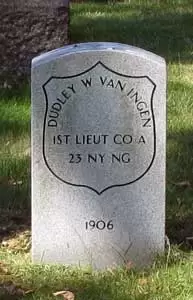
VAN INGEN, DUDLEY W. (1836-1906). Captain, 23rd Regiment, New York State National Guard, Company A. Van Ingen was elected second sergeant of the 23rd Regiment’s State Militia on January 29, 1862, and was appointed second lieutenant of the 23rd Regiment on September 4, 1862, when it was part of the New York State National Guard. When the 23rd was activated in 1863, he was commissioned in on June 18 and mustered out on July 22 at Brooklyn. On November 2, 1863, he was appointed captain with rank from October 23 of that year.
Van Ingen and other family members were wealthy wool merchants whose business was at 150 Fifth Avenue in Manhattan. According to an article in the New York Evening Telegram of December 31, 1903, five children of their brother died in a Chicago fire at the Iroquois Theatre during a performance of Mr. Bluebeard. Henry Van Ingen, the father, was injured, one child escaped, and the mother was seriously injured. It was reported that Dudley Van Ingen was on his way to Chicago to assist the family. Section 189, lot 17007.
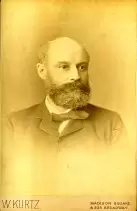
VAN INGEN, PETER D. (1835-1908). Second lieutenant, 12th Veteran Reserve Corps, Company H; private, 13th Regiment, New York State Militia, Company C; 84th New York (14th Brooklyn) Infantry, Company K; 2nd Battalion, Veteran Reserve Corps, Company 39. Van Ingen was originally from Amsterdam, Holland. According to his obituary in the Brooklyn Daily Eagle, he set sail at age fourteen and after traveling the world, settled in Brooklyn at age seventeen.
At the onset of the Civil War, Van Ingen served with the 13th Regiment for three months in 1861. He re-enlisted on August 20, 1862, at Brooklyn, and mustered into the 14th Brooklyn two days later. As per his muster roll for that enrollment, he was employed as a clerk and stood 5′ 8″ tall with blue eyes, dark hair and a light complexion. His muster roll states that he was wounded while skirmishing on the Rappahannock in April 1863, and at the Battle of Reynolds Crossing, Virginia, on April 29, 1863. His obituary notes that he was wounded in the right arm at the Battle of Chancellorsville, Virginia. He returned to the muster rolls in June and was transferred to the 2nd Battalion of the Veteran Reserve Corps on September 30, 1863. On June 29, 1865, he was discharged with a promotion to second lieutenant of the 12th Veteran Reserve Corps. In 1879, his application for an invalid pension was approved under certificate 193,263.
According to his obituary, he was a past commander of the Cushing Post #231 of the G.A.R. and had served for 20 years as a clerk in the Naval Office of the United States Custom House. Van Ingen also belonged to the Veterans’ Association of the Fourteenth Regiment, Concord Council, National Provident Union, and the Twelfth Assembly District Republican Club. He last resided at 92 16th Street in Brooklyn, his home for 40 years. He succumbed to nephritis.
Sarah Ann Van Ingen, who is interred with him, applied for and received a widow’s pension in 1908, certificate 665,416. Sarah Van Ingen was a member of the Cushing Women’s Relief Corps, an auxiliary of the G.A.R. whose members assisted with Memorial Day services, promoted pensions for nurses and sponsored patriotic education. She was also a member of the Wives and Daughters of the 14th Regiment. Section 85, lot 17932, grave 25.
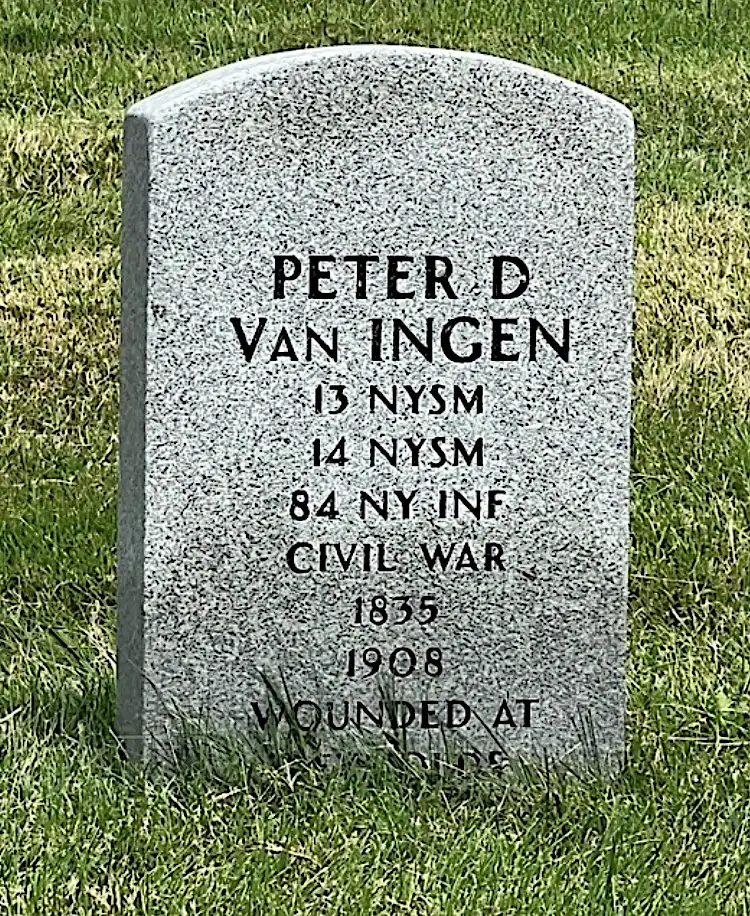
VAN KEUREN (or VAN BUREN), CORNELIUS (1837-1898). Private, 5th New York Infantry, Company G. Van Keuren was born in Dutchess County, New York, and was a jeweler by trade. After enlisting as a private at New York City on July 16, 1861, he mustered into the 5th New York that day. His name was incorrectly listed on the muster rolls as Cornelius Van Buren which has led to some confusion about the details of his service; a hand-written note to that effect was on his discharge certificate. He was described on his muster roll as 5′ 6½” tall with black eyes, dark hair, and a dark complexion. Though he is listed as a deserter on October 6, 1862, this appears to be in error, since he was treated at Park Barracks in New York City from June 7-August 6, 1862. He was discharged from service on July 6, 1864. A Cornelius Van Keuren appears on the regimental list of Duryée’s Zoaves, the familiar name of the 5th New York.
A physician after the Civil War, Van Keuren graduated from Columbia University’s College of Physicians and Surgeons in 1874. The 1880 census confirms his occupation as physician. He also served as a police surgeon for the New York Police Department from July 7, 1887, until his retirement in October 1897, and was secretary of the Board of Police Surgeons in 1892. A Freemason, he was also a member of the Meade Post #88 of the G.A.R. He last lived at 54 Jane Street in Manhattan. In 1898, Alethe Van Keuren applied for and received a widow’s pension, certificate 482,024. Section 203, lot 29565.
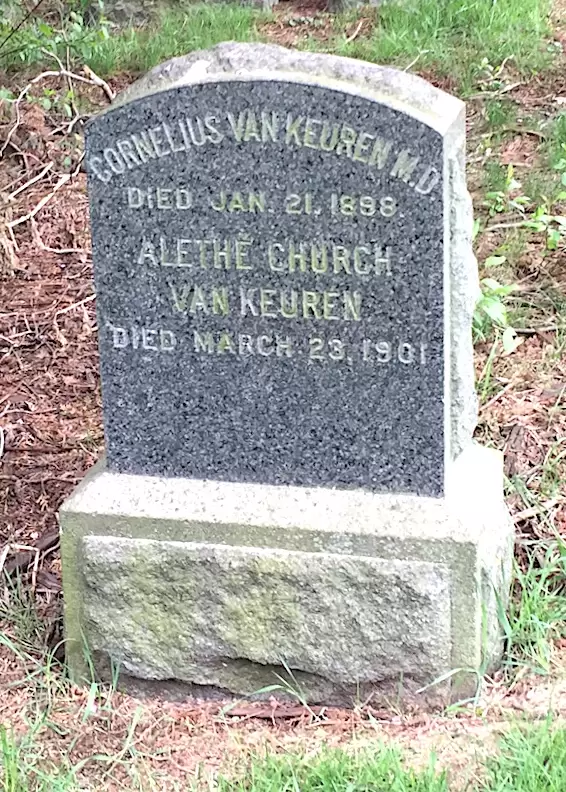
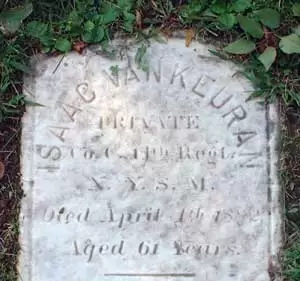
VAN KEUREN, ISAAC (1821-1882). Private, 84th New York (14th Brooklyn) Infantry, Company C. At 40, he enlisted on April 18, 1861, mustered in on May 23, and was discharged on June 6, 1864, at New York City. In 1881, his application for an invalid pension was approved, certificate 378,025. His wife received a pension at some point after his death, certificate 238,489. Section 67, lot 2743.
VAN KEUREN, JAMES W. (1835-1865). Captain, 21st New Jersey Infantry, Company F. Born in New York State, Van Keuren enlisted as a captain on September 2, 1862. His commission took effect on September 15 when he mustered into Company F of the 21st New Jersey. He mustered out of service on June 19, 1863, at Trenton, New Jersey. His last residence was 306 Garden Street in Hoboken, New Jersey. Section 156, lot 17068.
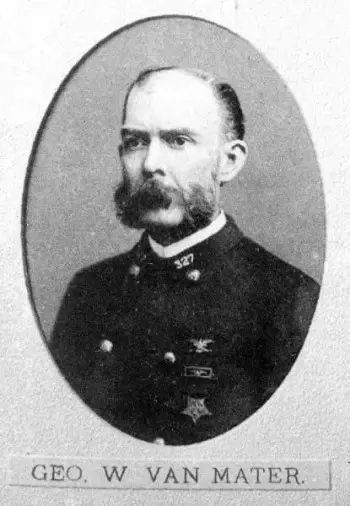
VAN MATER, GEORGE W. (1838-1909). Lieutenant and aide-de-camp, 56th Regiment, New York State National Guard, Company C. A native of Brooklyn, he was educated in the public schools and was employed in the manufacturing business before the Civil War. After serving with the 56th National Guard in 1862, he re-enlisted as a private on June 5, 1863, and mustered into the same regiment and company for a 30-day term. His unit fought at the Battle of Gettysburg, Pennsylvania, where they were mentioned in orders for cutting off retreating units of the Army of Northern Virginia from the local area. On July 7, 1864, he returned to the National Guard for 100 days as a lieutenant and aide-de-camp. His unit was assigned to Hart’s Island (Bronx, New York) to guard Confederate prisoners of war who were held there.
Van Mater returned to the New York State National Guard in 1868, was promoted to captain and put in command of all the commissary stores. He remained in service until 1874 when he resigned his commission to General Meserole (see) who commanded the 11th Brigade of the State’s National Guard. Active in military affairs in Brooklyn, he joined the G.A.R.’s William Rankin Post #10 where he was elected to many leadership positions including chaplain, senior vice-commander, and delegate to the department national encampment. He then withdrew from the Rankin Post and started the Ulysses S. Grant Post #327 in 1883. He also served as a past regent of the Burnside Council of the Royal Arcanum. When Ulysses S. Grant died, he was part of the Honor Guard at City Hall in New York City. In private life, he was associated with the firm of Charles E. Teale & Co., drapers and tailors on Fulton Street in Manhattan. His last residence was 682 Greene Avenue, Brooklyn. Section 65, lot 4746.
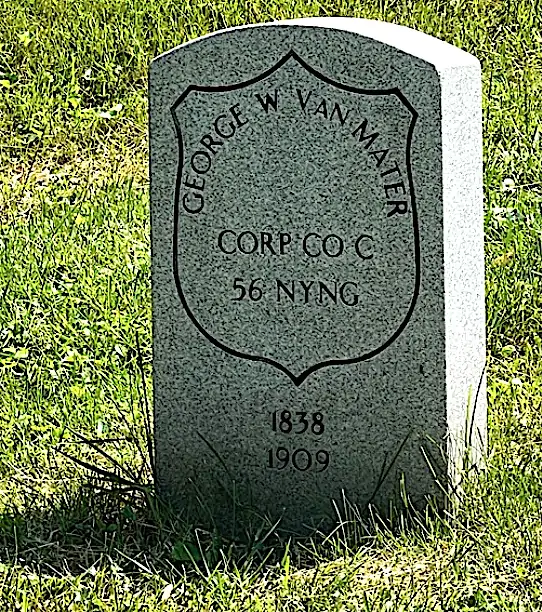
VANNESS (or VAN NESS), EDWARD (1838-1891). Quartermaster, 87th New York Infantry. A native New Yorker, he enlisted there as an adjutant on October 15, 1861, was commissioned into the Field and Staff of the 87th New York the next month on November 20, and was promoted to regimental quartermaster on July 1, 1862, at Harrison’s Landing, Virginia. He participated in these Virginia battles: Yorktown, Williamsburg and Fair Oaks. At some point during his service, he was listed as absent and sick at Alexandria, Virginia, and was absent when he mustered out when the troops were consolidated on September 6, 1862. His bio is listed in William Swinton’s History of the Seventh Regiment (1870); it is not known when he served in Company G.
A jeweler, Vanness’s business was also his residence at 42 Fulton Street in Manhattan. According to his obituary in The New York Times, he died of heart disease at a local eatery, where he was taking sips from a bottle, later determined to be medication for a cardiac condition. The obituary also notes that he was a gambler who once made $40,000 at one sitting at Saratoga, New York. A member of the Vanderbilt Post #136 of the G.A.R., he also belonged to the Order of Foresters and the Republican Association of the Eleventh Assembly District. Most likely, he and Frederick Van Ness (see) were brothers. Section 163, lot 16235.
VAN NESS, EUGENE (1805-1862). Lieutenant colonel and deputy paymaster general, United States Army Paymaster’s Department. Born in New York, Van Ness enlisted and was commissioned into the United States Army Paymaster’s Department as major on July 12, 1838. He was promoted to major and paymaster on December 18, 1839, and to lieutenant colonel and deputy paymaster general of the department on February 1, 1855. He died from pneumonia on May 28, 1862, at Baltimore, Maryland. Section 119, lot 12113.
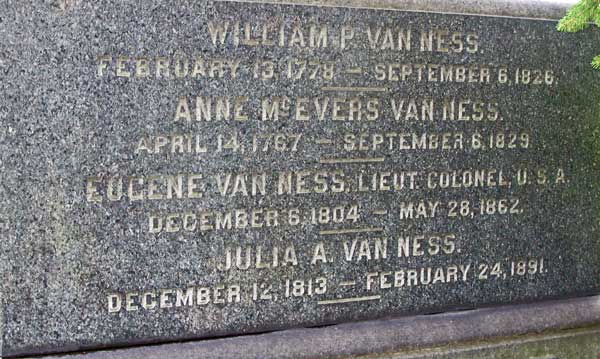
VAN NESS (or VANNESS), FREDERICK (1842-1884). Corporal, 3rd New York Infantry, Company F. Van Ness enlisted and mustered in on October 16, 1861. He was discharged three years later on October 16, 1864. Most likely, he and Edward Van Ness (see) were brothers. Section 163, lot 16235.
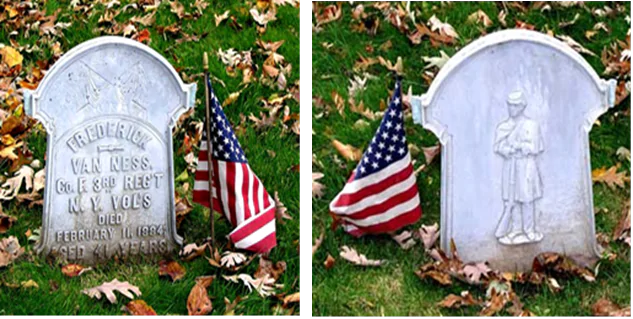
VAN NESS, GEORGE (1837-1890). Corporal, 61st New York Infantry, Company A; Vetern Reserve Corps. After enlisting as a private at Brooklyn on February 12, 1864, he mustered immediately into the 61st New York. He was promoted to corporal on March 29, 1864, and transferred into the Veteran Reserve Corps on February 15, 1865. In 1880, his application for an invalid pension was approved under certificate 213,252. He last lived on Herkimer Street in Brooklyn. Van Ness succumbed to apoplexy. Section 163, lot 16235.
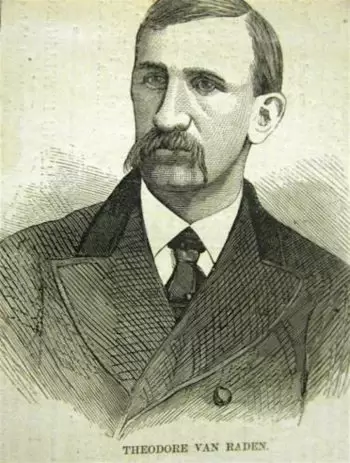
VAN RADEN (VAN RUDEN, VAN RADIN, VAN RAVEN), THEODORE (1841-1914). Private, 8th Regiment, New York State Militia, Companies E and G. Van Raden was born in New York City. As per the 1860 census, he lived in New York City with his parents and siblings. Van Raden enlisted as a private at New York City on April 28, 1861, and mustered into the 8th Regiment, serving for three months. He returned to the 8th regiment, then part of the New York State National Guard, in July 1863. His pension index card notes that he also served in Company G of the 8th Regiment. According to a descendant’s entry on a family tree, her “Uncle Teddy,” was a Union veteran who captured the seal of Fredericksburg, Virginia, used by George Washington, and held it for almost fifty years before returning it shortly before his death.
The 1870 census reports that Van Raden lived with his parents in New York City, was in the grocery business and had a personal estate valued at $1,000. On November 30, 1871, he married Anna Ferguson. Van Raden was on the executive committee of the National Association of Amateur Oarsmen and the Harlem Regatta Association. He rowed on the American crew of four against England in 1872 and with the Atlantic crew. That race, in 1872, marked the origin of a transatlantic friendship that began with a challenge by the Atalanta Rowing Club of New York, to which Van Raden belonged, to the London Rowing Club for a four-oared race on the Thames, known formally as the Anglo-American Boat Race. The race captivated citizens in both countries, especially after a defeat of Harvard College by Oxford; the yearly race, which continued until World War II was dominated by the British, especially in the early years because of the 16 foot rise and fall of the tides on the Thames.
Van Raden mustered into John A. Dix Post #135 of the Grand Army of the Republic on April 12, 1882, and stated that he was a commission merchant; his membership in the G.A.R. was noted in his New York Times obituary. The Veterans Schedule of 1890 confirms Van Raden’s Civil War service. The census of 1900 states that he had re-married in 1889, lived with his wife at 219 West 121st Street, and was employed as a salesman. He applied for and received an invalid pension in 1904, certificate 1,090,685. As per the New York Produce Review and American Creamery, he was well known in the butter and egg trades and was associated with firm of Bourne & Farrand until his death. His last residence was 104 West 90th Street in Manhattan. Although his wife applied for a widow’s pension in 1914, application 1,029,866, it was never certified.
As per New York State Wills and Probate Records, he left his personal and real estate to his wife Mary and bequeathed his watch, chain and locket presented to him by the Atalanta Boat Club to a minor, William Scrivener Rurode (relationship unknown), whose mother was charged with its possession until the boy reached the age of maturity. Section 59, lot 1328.
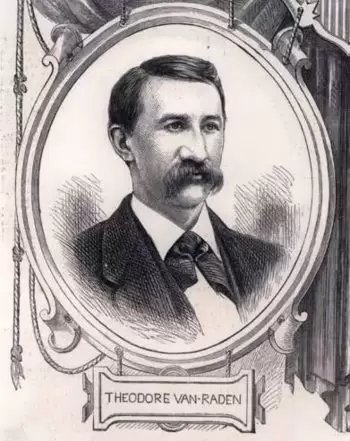
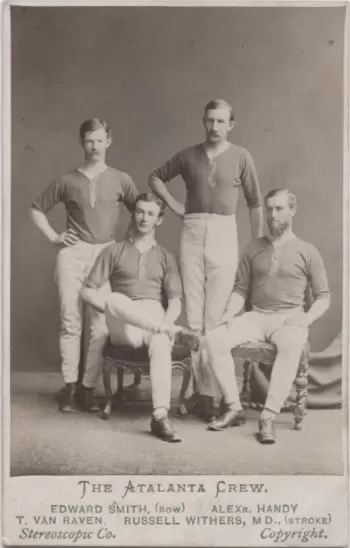
VAN RENSSELAER, KILIAEN (1845-1905). Captain, 39th New York Infantry. Born in Albany, New York, he was seventh in the line of descent from Kiliaen Van Rensselaer, the wealthy merchant of Amsterdam who in 1630 created the patroon of Renselaerwyck, which included nearly all of what would be the counties of Rensselaer and Albany. He was also a descendant of Revolutionary War General Philip Schuyler and Philip Livingston, a signer of the Declaration of Independence. He enlisted during the Civil War, and became a captain of the 39th New York, serving under Grant and Hancock in 14 engagements. He served as president of the Grand Army Mission and the Sanitary Aid Society. His last address was 55 East 72nd Street in Manhattan. He died of angina pectoris. Section 22, lot 3561.
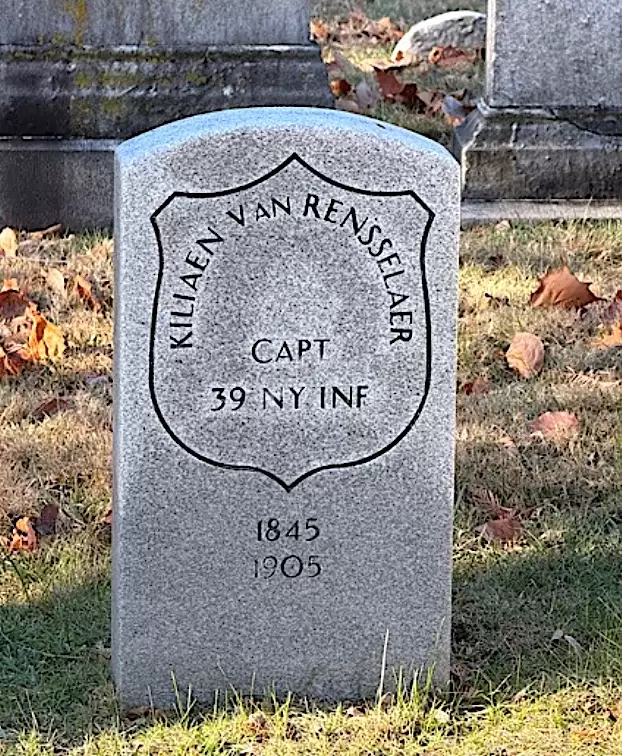
VAN RENSSELAER, STEPHEN (1838-1904). Major, 12th Regiment, United States Army; 7th Regiment, New York State Militia, Company K. According to his obituary in The New York Times, he was a direct descendant of the patroons who settled in Albany, New York. A native of New York City, he joined the 7th Regiment as a sergeant at the onset of the Civil War and fought his way through Baltimore, Maryland, to Washington, D.C. He soon resigned from the 7th, and on May 14, 1861, joined the 12th Regiment, United States Army, as a first lieutenant. Van Rensselaer served in the Peninsula Campaign during the Seven Days Battle, Virginia, was promoted to captain on December 20, 1862, and was severely wounded on the second day of fighting at Gettysburg, Pennsylvania (July 2, 1863), and confined to his bed for three months. He was promoted to major on July 10, 1863, and resigned on September 9, 1863.
In civilian life, Van Rensselaer was a wine merchant with a shop that bore his name at 21 William Street in New York City. A member of the choir at his church, he also belonged to the Union Club and the Essex County Country Club. He died at the Park Avenue Hotel where he was spending the winter, but had lived for thirty-five years in West Orange, New Jersey. His death was caused by anemia. Section 42, lot 10262.
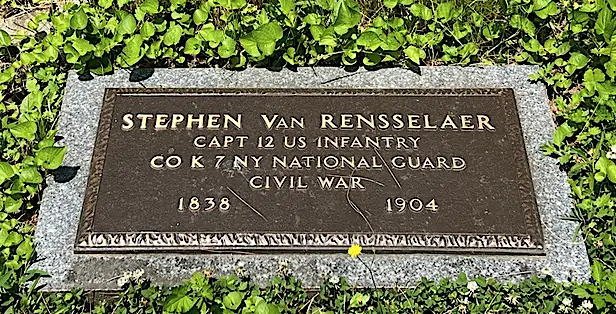
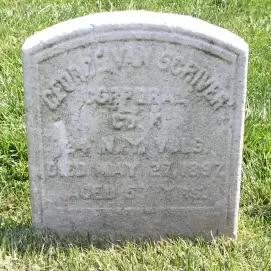
VAN SCRIVER (or VAN SCIVER, VAN SEIVER), GEORGE (1839-1897). Corporal, 124th New York Infantry, Company K; Veteran Reserve Corps. Born in Newburg, New York, he enlisted on July 31, 1862, at Wallkill, New York, as a private, mustered into the 124th’s Company K, also known as the Orange Blossoms, and was promoted to corporal on September 5. He was listed on all of his soldier records, as well as Green-Wood’s records, as George Van Sciver, but his tombstone spells his last name as “Van Scriver.” He was wounded on May 3, 1863, at Chancellorsville, Virginia. On April 10, 1864, he transferred into the Veteran Reserve Corps where he served until his discharge on June 28, 1865, at Washington, D.C.
In 1877, he applied for and was a granted an invalid pension, certificate 147,332. On October 22, 1885, he joined the Henry M. Lee Post #21 of the G.A.R. His last residence was 670 President Street, Brooklyn. His widow received a pension after his death, certificate 474,515. Section 135, lot 14964, grave 323.
VAN SYCKLE, WILLIAM B. (1836-1862). Private, 9th New York Infantry, Company E. A native of New York, he enlisted at New York City as a private on April 23, 1861, and mustered into the 9th New York, also known as the Hawkins Zouaves, on May 4. After suffering a gunshot wound in battle at Roanoke Island, North Carolina, on February 8, 1862, he succumbed to his wounds there on April 22. He was interred in Green-Wood on May 8. On August 28, 1862, his wife applied for and received a widow’s pension, certificate 2,384; a minor’s pension was granted under certificate 126,657. The stone on his grave is incorrectly inscribed with service in the 19th New York Infantry instead of the 9th New York. Section 13, lot 9519.
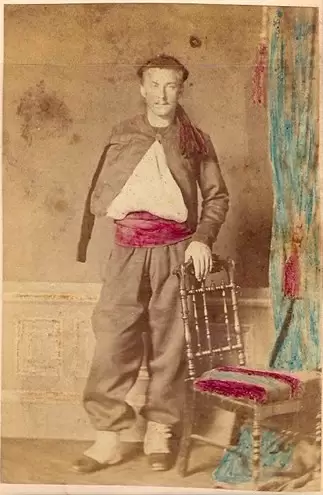
VAN TASSELL, WILLIAM H. (1834-1869). Private, 95th New York Infantry, Company I. He enlisted as a private at Sing-Sing, New York, on February 24, 1862, the same day that he mustered into the 95th New York. He re-enlisted on February 11, 1864, and returned to the same regiment and company where he served as a private until his discharge on July 16, 1865, in the field in Virginia. His last residence was 11 Greene Avenue in Brooklyn. Section 165, lot 16933.
VAN VALKENBURG (or VALKENBURGH), EUGENE (1842-1917). Corporal, 109th New York Infantry, Company F. His obituary in the Brooklyn Chat, which confirms his Civil War service, reports that Van Valkenburg was born in Marcellus, New York. He enlisted while his parents lived in Ithaca, at Dryden, New York, on August 5, 1862, and mustered into Company F of the 109th New York on August 14. He was badly injured in the left arm, requiring its amputation, during the Battle of Spotsylvania Court House, Virginia, on May 12, 1864, while under the command of Colonel Benjamin F. Tracy (see). Van Valkenburg was discharged for wounds on October 3, 1864.
On October 22, 1864, he applied for an invalid pension that was granted under certificate 46,381. His pension records include information on the loss of his left hand and disability of the left arm resulting in total disability of same. The 1865 New York State census shows him living in Ithaca, New York with his parents, siblings, and other family members. While recovering from his wounds, he obtained a position at the New York Custom House through the efforts of his friend, Alonzo Cornell. The 1870 census reports that he was still living in Ithaca and was working as a clerk at the New York Custom House. At the time of his death, the Brooklyn Chat notes that Van Valkenburg was one of the oldest surviving members of the United States Customs service in New York. He was also a member of Sumner Post #24 of the G.A.R..
As per the 1900 census, which uses the spelling of Van Valkenburgh, he lived in Brooklyn at 134 Rutland Road in a mortgaged house, had been married to Delia, sixteen years his junior, since 1886, worked as a clerk at the Custom House, and had a five-year-old daughter and two-year-old son. By the time of the 1910 census, his house had been paid off, he was still working at the Custom House, and lived with his wife and children. The 1915 New York State census confirms that he was the head of his family. He last lived at 134 Rutland Road. His obituary notes that he had been a Brooklyn resident for 20 years.
According to his death certificate, which names his wife as executor, Van Valkenburg was still a Custom House clerk and died from unresolved lobar pneumonia and cardiac asthenia (a syndrome marked by shortness of breath, rapid pulse and heart palpitations). He was survived by his widow, his two children and two brothers. Another un-cited obituary confirms his Civil War service and battle wounds. In 1917, Delia Van Valkenburg applied for and received a widow’s pension, certificate 843,457. Although the family monument uses the spelling “Valkenburgh” with an “h,” only the 1900 census uses that spelling. Section 193, lot 26588.
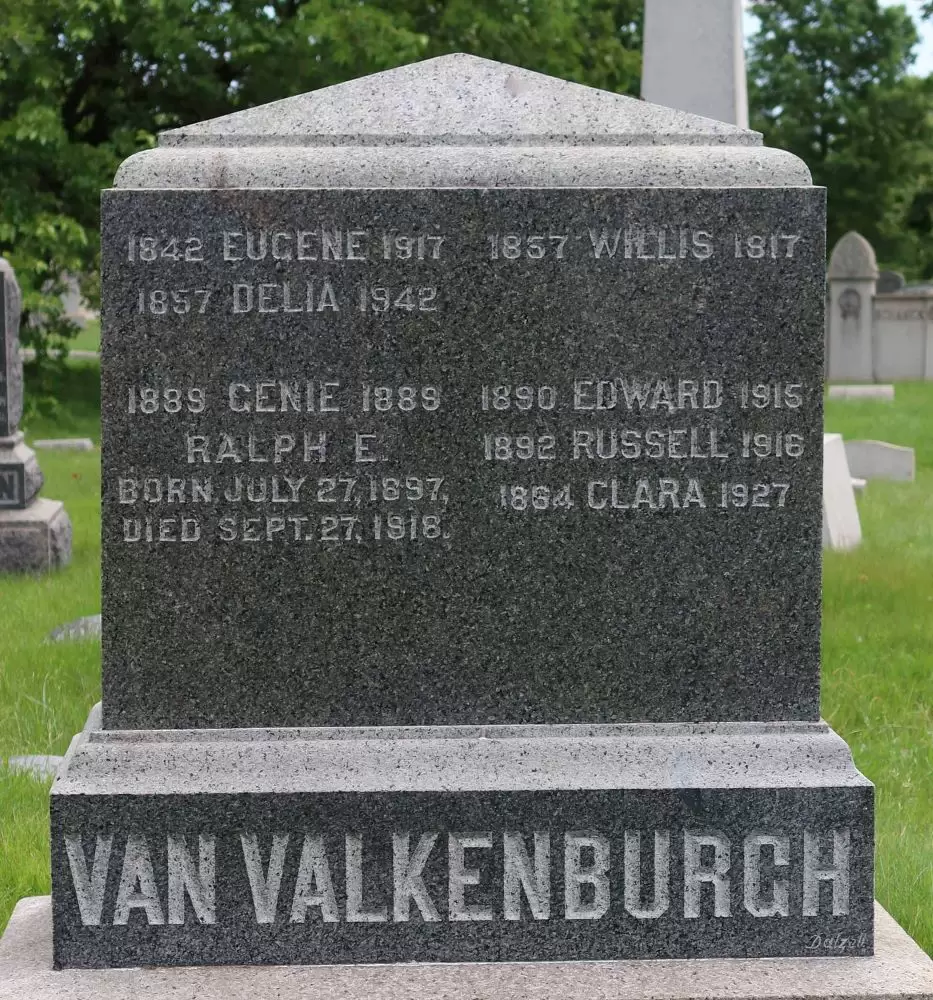
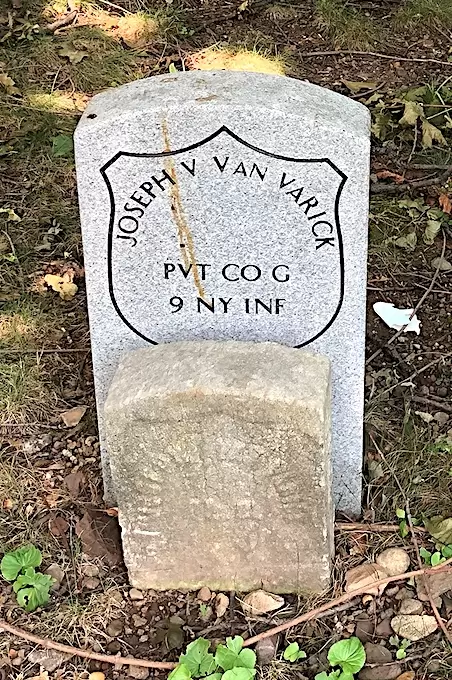
VAN VARICK (or VARICK), JOSEPH V. (1845-1884). Private, 9th New York Infantry, Company G. New Jersey-born, he enlisted at New York City on September 26, 1861, immediately mustered into the 9th New York, and mustered out on May 20, 1863, at New York City. He last lived at 9 Newark Street in Hoboken, New Jersey. His death was caused by heart disease. In 1890, his wife applied for and received a widow’s pension, certificate 366,986; a minor applied for a pension, application 653,949, but there is no evidence that it was certified. Around 1900, a government-stone was ordered from the Vermont Marble Company noting his death on March 12, 1884; his interment at the present location at Green-Wood was in 1888. Section 3, lot 8368.
VAN VELSOR, EDWARD PRYOR (1835-1893). Landsman, United States Navy. Van Velsor was born in New York. The 1850 census reports that he was living with his parents and five younger siblings in Waterbury, Connecticut. By the time of the 1860 census, he was living with his wife and child in Brooklyn; he was a brass roller whose personal estate was valued at $100. This information is confirmed by an online family tree that shows that he lived in Brooklyn and was married in 1863. He and his wife, Jane née Palmer, whom he married on May 21, 1857, at the Norfolk Street Baptist Church in New York City, had four children; their eldest daughter was born in 1858.
As per Jane Van Velsor’s pension application, Edward Van Velsor enlisted as a landsman on August 24, 1864. On September 15, 1864, he was hospitalized with erysipelas while onboard the USS North Carolina. His hospital ticket, outlining his belongings, is pictured below. He served on the North Carolina until November 5, 1864. Among the ships that he also served on were the USS Wyandank, a wood-hulled sidewheel New York City ferry which was converted into a store ship for the Potomac Flotilla; he served for only three days until November 8, 1864. He then was aboard the USS Yankee, a steam-powered side wheel tugboat whose last major operation saw her joining three other ships to raid Hamilton’s Crossing, near Fredericksburg, Virginia, on March 7, 1865; he was on that vessel until May 15, 1865. Although listed as serving on that ship on one document in his wife’s Navy pension files, another document in that file notes that his name did not appear on that ship’s records and that he may have been aboard using an alias. Lastly, he served aboard the USS Fuschia, a steamer that had been used for blockades, until was honorably discharged on August 25, 1865.
In 1870, Van Velsor was living with his wife in Greenpoint, Brooklyn. The census of that year reports that he was a brass roller who had four children ranging in age from two months to twelve years. The 1880 census shows that he lived at 202 Manhattan Avenue in Brooklyn with his wife and children and was still working as a brass roller. The 1889 Brooklyn Directory identifies him as a foreman. His death certificate notes that he was married, worked as a brass roller, and died from phthisis at 677 Bedford Avenue in Brooklyn. .
Jane Van Velsor applied for and received a widow’s pension from the Navy, certificate 10,003, which commenced in June 1893, at the rate of $8 per month; the pension was ended when she died 1919. Van Velsor’s aunt, in an affidavit in support of Jane Van Velsor’s pension application, confirmed that Edward spent his boyhood in Waterbury, Connecticut, had one marriage, and that Jane had meager savings or means of support other than some sewing; another affidavit noted that a son gave her some support. Mrs. Van Velsor, through her lawyer, wrote to the commissioner of the Pension Bureau on February 11, 1913, requesting the return of her husband’s discharge papers; the request was received and honored on February 19. She again wrote to the Pension Bureau on December 21, 1916, asking for an increase stating that she was paralytic and dependent on the pension; as per the law, widows who were over 70 years of age were only entitled to $20 per month. Jane lived with her daughter at 707 Madison Street in Brooklyn and was paralyzed for the last ten years of her life. On July 19, 1919, Jennie Van Velsor, Jane’s daughter, wrote to the Bureau of Pensions requesting reimbursement for her mother’s funeral expenses; she asked for $227 in reimbursement of which $60 was approved. Section 59, lot 1428.
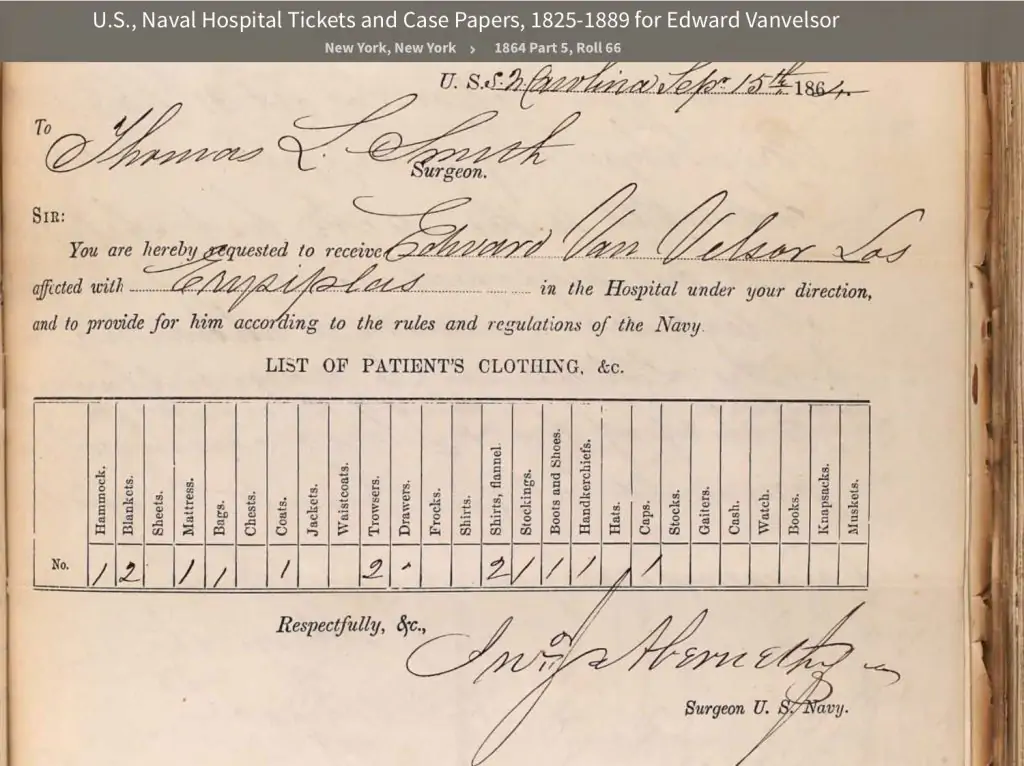
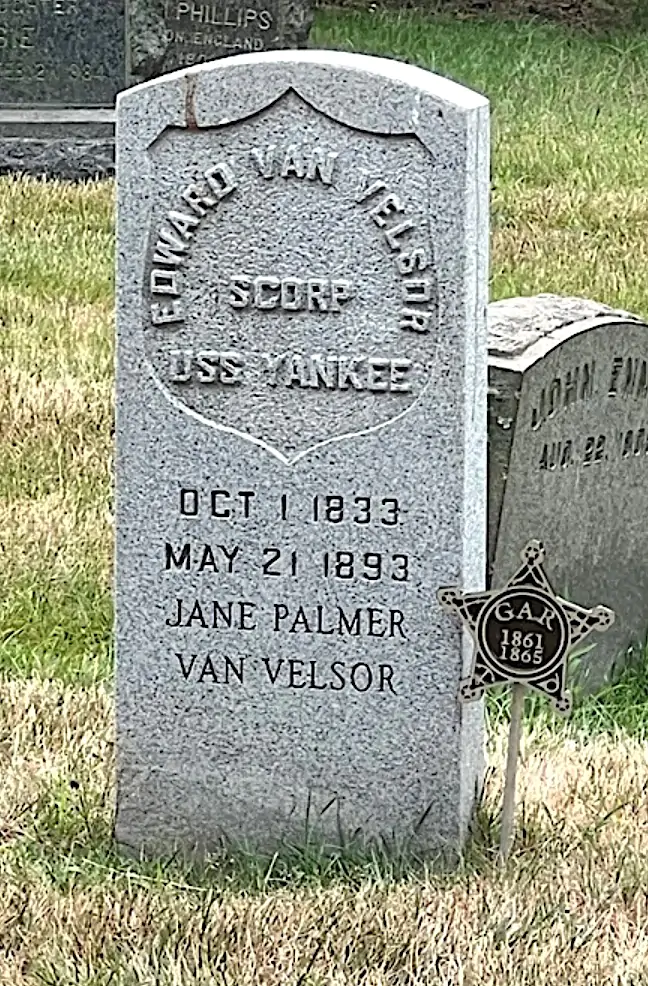
VAN VLECK, ABRAHAM (or ABRAM) K. (1842-1916). Captain, 102nd Regiment, New York State National Guard, Company H; private, 23rd Regiment, New York State National Guard, Company I. Van Vleck first served with the 23rd Regiment as a private when the unit was activated for 30 days in 1863. Subsequently, he enlisted as a captain at New York City on August 8, 1864, was commissioned into the 102nd Regiment for 100 days, and mustered out at New York City on November 13. In 1907, his application for a pension was approved, certificate 1,138,870. His last residence was at 7 West 16th Street in Brooklyn. Annie Van Vleck, who is interred with him, applied for and received a widow’s pension in 1916, certificate 813,903. Section76, lot 3857.
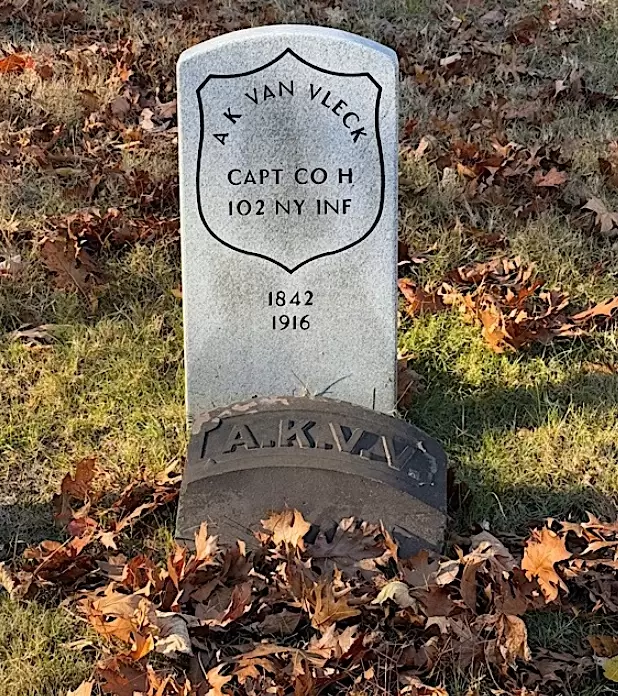
VAN WAGENEN, WILLIAM MANSFIELD (1842-1866). A New Yorker by birth, Van Wagener was not a combatant in the hostilities but served in the United States Christian Commission, an affiliate of the Methodist church, and assisted in the care of the wounded. A graduate of Columbia College, he returned to the ministry after the War. He last lived at 60 West 37th Street in Manhattan. Section 107, lot 65.
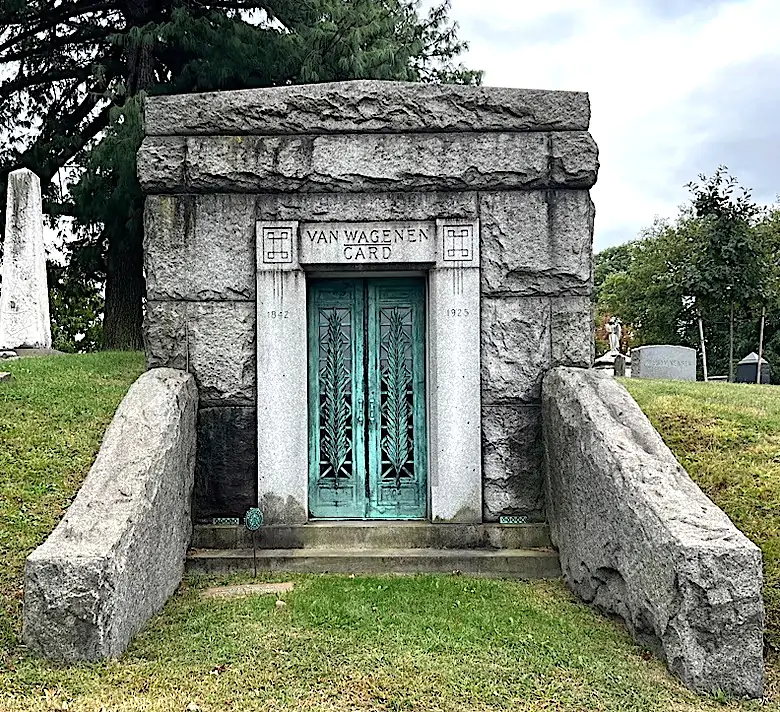
VAN WART, EDWIN FORREST (1840-1900). Private, 5th New York Infantry, Company H. A cap-cutter and a New York City native who resided at 641 Water Street in Manhattan, Van Wart was 5′ 6″ tall with blue eyes and brown hair. The son of William Van Wart (see), also of the 5th New York, he enlisted at New York City on April 25, 1861, and mustered in on May 9. He was listed as absent, sick in the United States Army General Hospital, Annapolis, Maryland, with a fever and pneumonia, from April 21 to May 21, 1862, and was detached to hospital duty as a nurse. On August 31, he was listed as absent without leave since April 21, and was reported as a deserter on October 2. However, a report of the War Department Record and Pension Office, from 1901 concludes, “all charges of absence without leave and desertion against this man are erroneous…” At the end of his hospital detail, he was discharged on May 21, 1863. According to a descendant, he was a carpenter by trade. A grandson of Edwin Forrest Van Wart married a great granddaughter of William Wares (see). Section 135, lot 27263, grave 1012.
VAN WART, WILLIAM (1817-1876). Corporal, 5th New York Infantry, Company H. Born in Haverstraw, New York, he was the father of Edwin Forrest Van Wart (see). A chair-maker by occupation, Van Wart was 5′ 8″ with blue eyes and brown hair. He enlisted as a private on July 17, 1861, at New York City, was promoted to corporal on August 19, and reduced to ranks on December 23 of that year. After being sick with a cough and rheumatism, he was hospitalized in February 1862 and discharged for disability on May 31, 1862, at Baltimore, Maryland. In 1880, his wife applied for and received a widow’s pension, certificate 226,960. Section 12, lot 8137.
VAN WINKLE, SAMUEL E. (1830-1866). Corporal, 5th New York Heavy Artillery, Company D. A Brooklynite by birth, Van Winkle enlisted as a private at New York City on April 3, 1862, mustered immediately into the 5th New York Heavy Artillery, and was promoted to corporal on May 15, 1863. He re-enlisted on March 31, 1864, was reduced in rank to private on September 23, 1864, and was discharged for disability on June 24, 1865, at Harpers Ferry, West Virginia. His last residence was 69 Elizabeth Avenue in Elizabeth, New Jersey, where he died from consumption. Section 28, lot 11188.
VARICK, CHARLES A. (1835-1869). First lieutenant, 1st New York Mounted Rifles, Companies K and E. Born in Brooklyn, he was 5′ 9½” tall with grey eyes, brown hair and a dark complexion. Varick enlisted as a second lieutenant at New York City on September 26, 1862, mustered immediately into Company K of the 1st New York Mounted Rifles, was promoted to first lieutenant on February 1, 1863, effective upon his transfer to Company E, and resigned on February 16 of that year. He last lived in Wycoff, New Jersey. The cause of his death was diarrhea. Section 43, lot 339.
VARLEY, ROBERT (1834–1866). Teamster, 158th New York Infantry, Company H. Of English birth, Varley enlisted at Brooklyn as a wagoner teamster on August 30, 1862, and mustered into the 158th New York on September 3. He mustered out on June 30, 1865, at Richmond, Virginia, and died from cholera one year later. His last residence was in Brooklyn. Section 151, lot 16437.
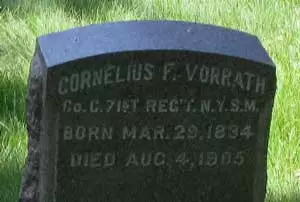
VARRATH (or VORRATH), CORNELIUS T. (or F.) (1834-1905). Private, 71st Regiment, New York State Militia, Company C. Originally from Long Island, New York, Varrath enlisted in 1861 and served with the 71st Regiment for its three month activation that year. In 1872, he applied for and received an invalid pension, certificate 143,144. He last resided at 667 Quincy Street in Brooklyn. Section 186, lot 19640, grave 4.
VAUGHAN, ROBERT (1837-1873). Sergeant, 108th New York Infantry, Company A. Of Irish origin, he enlisted as a sergeant on June 20, 1862, at Rochester, New York, and mustered into the 108th New York the same day. On November 20, 1862, he was reduced in rank to private, although his soldier record indicates that he resigned on that day as a sergeant, and was discharged for disability on February 5, 1863, at Falmouth, Virginia. His last residence was in Ramapo in Rockland County, New York. Section 39, lot 12020.
VAY, NICHOLAS (1839-1872). Private, 13th Regiment, New York State National Guard, Company B. Of Irish birth, Vay first served in the 13th Regiment when it was activated in 1861. He re-enlisted at Brooklyn as a private on May 28, 1862, mustered immediately into the 13th Regiment’s National Guard, and mustered out three months later on September 12 at Brooklyn. His last residence was on Washington Avenue in Brooklyn. Section 154, lot 22811.
VELTMAN, WILLIAM F. (1831-1901). Acting master’s mate, United States Navy. Originally from Poughkeepsie, New York, he enlisted on August 5, 1862, and served as an acting master’s mate in the United States Navy aboard the USS Mohican. He resigned on June 6, 1864.
As per a newspaper article, Veltman, a clerk at the Fourth National Bank, was charged with defrauding the bank by means of forged checks and false entries in 1868 and 1869; he confessed to a bank cashier that he made the false entries. He was found guilty of forgery in the third degree and sentenced on June 18, 1877, to two years in the New York County Penitentiary.
On March 6, 1894, he mustered into the Clarence D. Mackenzie Post #399 of the G.A.R.; he lived in Brooklyn and listed his occupation as accountant. Veltman applied for and received a pension from the Navy in 1897, certificate 27,070; he was designated as having a partial disability and unable to do manual labor. He last lived at 88 Sterling Place in Brooklyn. His death was attributed to uremia. Julia Veltman, who is interred with him, applied for and received a widow’s pension of $8.00 per month from the Navy in 1901, certificate 14,941 (originally 20,526). His name was listed on the Mortuary Table for the G.A.R.’s New York 26th Encampment in 1902. Section 158, lot 14562, grave 14.
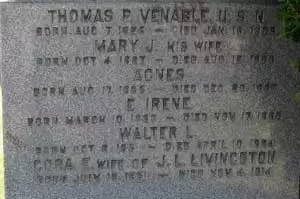
VENABLE, THOMAS P. (1825-1909). Gunner, United States Navy. Born in the District of Columbia, Venable first enlisted as a gunner in the United States Navy at Washington, D.C., on March 19, 1847, and resigned on May 15, 1854. After he was reappointed as a gunner on October 22, 1855, he remained in the Navy throughout his career.
During the Civil War, Venable was attached to the USS Roanoke from May 1861 through March 1862, and was aboard that vessel at Hampton Roads, Virginia, when the CSS Merrimack (CSS Virginia) destroyed the USS Cumberland and the USS Congress on March 8, 1862. Venable served the remainder of the War at the Brooklyn Navy Yard. He retired on August 25, 1887, having served a total of 39 years. According to his obituary in the Evening Post, he was promoted to chief gunner on December 20, 1906, in recognition of his service during the Civil War. His last residence was in Washington, D.C. Section 146, lot 24734, grave 3.
VERNON, ROBERT (1839-1904). Sergeant, 145th New York Infantry, Company D; 150th New York Infantry, Company H. A native of England, Vernon enlisted on April 30, 1862, at New York City, mustered into the 145th New York on September 11, and was transferred into the 150th New York on December 9, 1863. After mustering into the 150th on January 4, 1864, he was wounded on August 15, 1864, and mustered out on May 26, 1865, at Louisville, Kentucky. In 1872, Vernon’s application for an invalid pension was granted, certificate 121,763. He last lived at 11 St. Mark’s Place in Manhattan. His remains were moved to the current location on June 27, 1905. His wife applied for a widow’s pension, application 814,492, but there is no evidence that it was granted. Section 127, lot 17931, grave 87.
VERPLANCK (or VERPLANK), HENRY Z. (1847-1865). Musician, 174th New York Infantry, Company H; 162nd New York Infantry, Company H. A New York native, Verplank enlisted there as a musician on October 16, 1862, and mustered into the 174th on November 10. On February 17, 1864, he transferred into the 162nd with the same rank and mustered out at Savannah, Georgia, on October 12, 1865. He was likely the brother of Robert Verplanck (see). He died at David’s Island, New York Harbor. Section 64, lot 4713, grave 147.
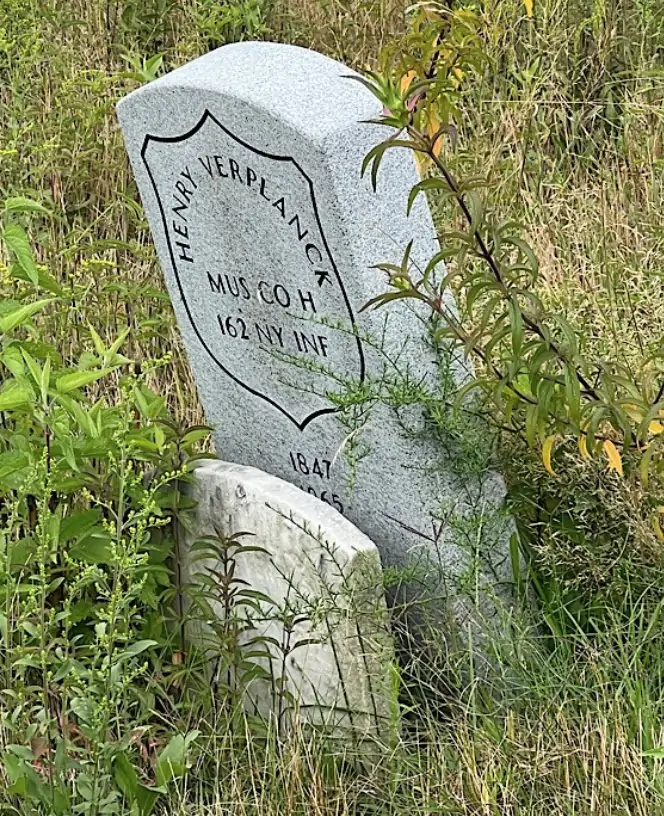
VERPLANCK (or VERPLANK), ROBERT A. (1839-1886). Corporal, 87th New York Infantry, Company I; 40th New York Infantry, Company G. Verplanck, who was born in New York State, enlisted on August 30, 1861, at Williamsburg, New York, as a private. On November 15, he mustered into Company I of the 87th New York and became corporal on January 1, 1862. On September 6, 1862, he was transferred to the 40th New York. He served at the Battle of Gettysburg, Pennsylvania, and at the Battle of Spotsylvania, Virginia. At the latter battle, he was wounded in the chest, captured and taken as a prisoner of war, and was incarcerated at the infamous prison at Andersonville, Georgia, for seven months. The Andersonville records state that he was sent to the prisoner of war camp at Millen, Georgia, on November 11, 1864. He was discharged on October 6, 1864, at Petersburg, Virginia.
In 1885, Verplanck’s application for an invalid pension was granted, certificate 356,873. As per his death certificate, he worked as a truck driver. Most likely, he was the brother of Henry Verplanck (see). His last residence was 454 West 47th Street in Manhattan. His wife applied for and was awarded a widow’s pension, certificate 233,781. Section 64, lot 4713, grave 147.
VERPLANK, JAMES (1846-1882). Musician, 178th New York Infantry, Company D. Born in New York State, Verplank enlisted as a musician at New York City on April 8, 1863, and mustered into the 178th New York on June 19. At some point, he was reduced in rank to private, and was reinstated to musician on June 30, 1864. On October 11, 1864, he deserted from his unit at Linn, Missouri. His last residence was 119 Green Street in Manhattan. Section 83, lot 2440.
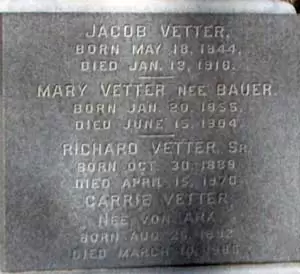
VETTER, JACOB (1844-1916). Private, 11th Regiment, New York State Militia, Company G. After Vetter enlisted as a private in 1863, he immediately mustered into the 11th Regiment and served during its 30-day activation. According to his obituary in the New York Herald, he owned a trucking business in the shadow of the Brooklyn Bridge on Spruce and William Streets in Manhattan, succeeding his father who established the concern in 1840. Vetter was a member of the Arion Club, the Mainzer Club and the Empire City Fishing Club in Eltingville, Staten Island. His last address was 31 Beekman Place in Manhattan. Section 145, lot 25729, graves 4 and 5.
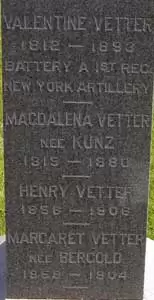
VETTER, VALENTINE (1812-1893). Private, 29th New York Light Artillery, Battery A; 1st Regiment, New York Light Artillery, Battery A. Of German birth, Vetter enlisted as a private at New York City on July 24, 1861, mustered into the 29th Light Artillery on August 12, and was discharged for disability on November 22, 1862. His pension record indicates that he also served in the 1st Regiment’s Light Artillery but there are no further details about that enrollment. In 1884, he applied for and received an invalid pension, certificate 316,587. His last residence was 730 East 6th Street, Manhattan. Section 154, lot 22814, grave 2.
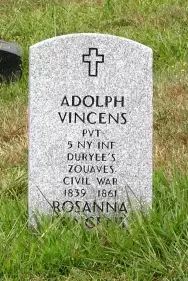
VINCENS, ADOLPH (1839-1861). Private, 5th New York Infantry, Company A. A native of London, England, he worked at the prominent Broadway jewelry firm of Ball, Black & Company, then enlisted at New York City on April 25, 1861, and mustered into the 5th New York on May 9. He was wounded in the chest at Big Bethel, Virginia, on June 10, 1861, and died of his wounds on June 24, 1861, at Fort Monroe, Virginia. His brother went there to retrieve his remains and he was interred at Green-Wood on June 26, the first Civil War battle casualty buried at the cemetery. (Note: Clarence McKenzie (see) was the first casualty of the War who was buried at Green-Wood; he was shot and killed while drilling with another drummer boy.) Section B, lot 9895, grave 757.
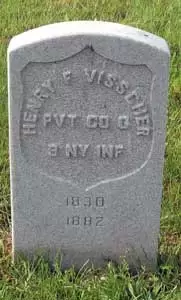
VISSCHER (or VISCHER), HENRY F. (1830-1882). Private, 9th New York Infantry, Company G. Originally from Albany, New York, Vischer enlisted as a private at New York City on May 3, 1861, mustered into the 9th New York the next day, and was discharged for disability at Newport News, Virginia, on August 19, 1861. He died at the Alms House in New York City. Section 36, lot 874.
VITO, CHARLES (1832-1872). Fourth sergeant, 11th Regiment, New York State National Guard, Company B. Vito, a German native, enlisted as a private at New York City on May 28, 1862, the same day he mustered into the 11th Regiment, and was discharged after three months on September 16 at New York City. He returned to the same regiment and company for 30 days in 1863 with the rank of fourth sergeant. He died at the German Hospital in New York City. Section 17, lot 17245, grave 1687.
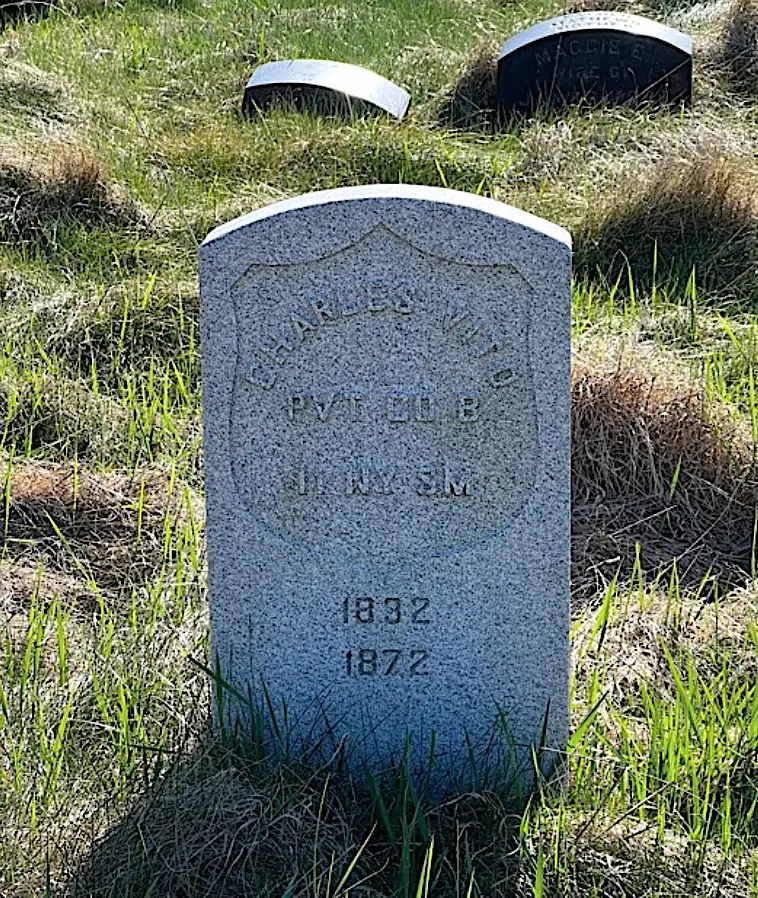
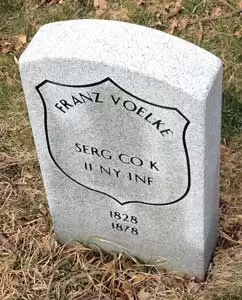
VOELKE (or VOELKLE), FRANZ (or FRIEDRICH) (1828-1878). Sergeant, 11th New York Infantry, Company K. A native of Germany, he enlisted as a sergeant at New York City on May 27, 1861, mustered in that day, and mustered out on September 16, 1862, at New York City. He last lived at 160 Seventh Avenue in Manhattan. Section 115, lot 13536 (Soldiers’ Lot), grave 124.
VOELKER (or VOLKER), CHARLES (1835-1862). First lieutenant, 20th New York Infantry, Company E. Of German birth and a resident of 167 Essex Street in Manhattan, he enlisted as an ensign at New York City on May 3, 1861, and mustered into the 20th New York three days later. He was promoted to second lieutenant on July 4, with rank from May 3 and then promoted to first lieutenant on October 3, 1862, with rank from July 10, 1862. Mortally wounded in action at Antietam, Maryland, on September 17, 1862, he died the next day, and was buried at Green-Wood on October 5 of that year. Section 115, lot 13536 (Soldiers’ Lot), grave 29.
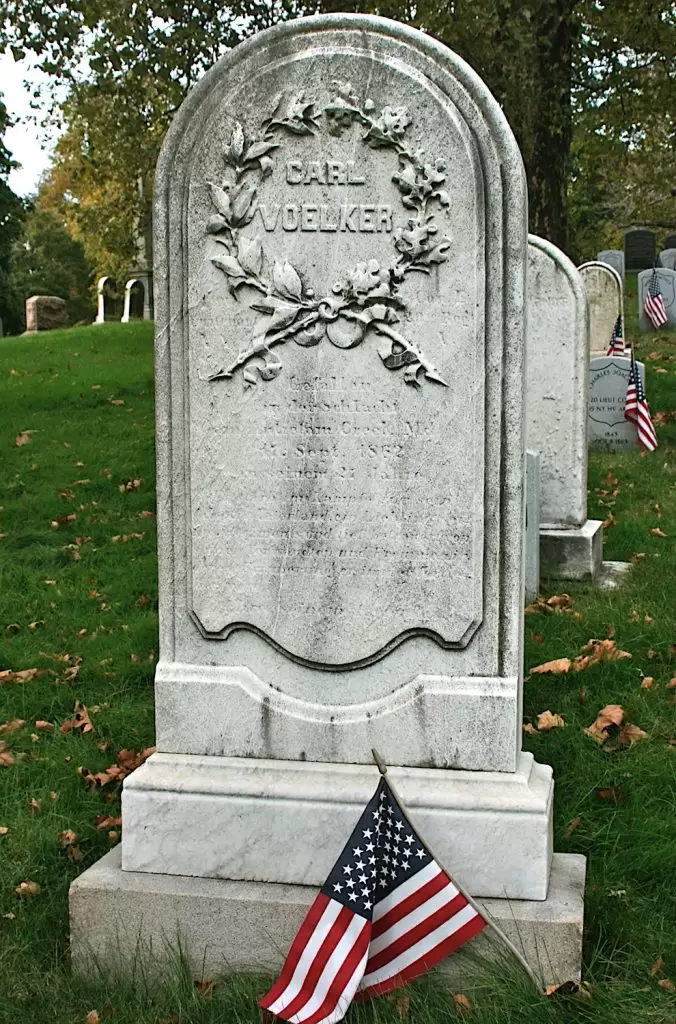
VOGEL, LOUIS HENRY (1843-1924). Corporal, 45th New York Infantry, Company E; 58th New York Infantry, Company E. A life-long resident of Brooklyn, he enlisted as a private on September 27, 1861, at New York City, and mustered into the 45th New York that same day. After being discharged at Lookout Valley, Pennsylvania, on January 3, 1864, he immediately re-enlisted, and was transferred into the 58th New York. Vogel was promoted to corporal on May 28, 1864, and mustered out October 1, 1865, at Nashville, Tennessee. He saw action in many battles including these in Virginia: Fairfax Court House, Second Bull Run, and Chancellorsville. He also fought at Gettysburg, Pennsylvania; Lookout Mountain, Tennessee; and in Sherman’s March.
The owner of a sheet metal factory in Williamsburg, Brooklyn, Vogel was active in the George Rickard G.A.R. Post #362 in Brooklyn. In 1907, he applied for a pension, granted under certificate 1,361,563. At the time he applied for a pension, he described his physical appearance as 5′ 6″ with blue eyes and red hair and tattoos of an eagle on his left arm and the American Coat of Arms on his right arm. He may have been a relative of William Vogel (see). He last lived at 55 Halsey Street in Brooklyn. Section 195, lot 29479.
VOGEL, WILLIAM (1840-1898). Private, 59th New York Infantry, Company F. Vogel was born in New York City, educated in the public schools and became an apprentice to a tin roofer. After enlisting at New York City on October 1, 1861, he mustered into the 59th three days later and deserted on October 11 at East New York after serving one week.
As per the census of 1880, he was a tinware man. In 1883, he was the proprietor of William Vogel & Bros., manufacturers of tinware, at 43 South 9th Street in Brooklyn. In the 1890’s, his factory was well-known for its sports-themed tinware in two colors. His obituary in the Brooklyn Daily Eagle noted that he was an honest businessman who kept prices low by meeting all of his obligations and avoiding indebtedness. In addition, he was active in the Sons of Temperance, a Freemason, and member of the Union and Hanover Clubs. Interest in financial affairs extended to his community where he was a director of the Manufacturers’ Trust Company, Manufacturers’ National Bank and the Manufacturers’ Association, a founder of the Amphion Musical Society, and a member of the Manufacturers’ Insurance Company. He also was associated with the Society of Old Brooklynites and the Exempt Firemen’s Association.
According to an article on February 11, 1898, in the Brooklyn Daily Eagle, Vogel was recovering from an operation in which a skin graft was performed after the removal of a cancer on his scalp. His obituary in the Brooklyn Daily Eagle on March 22, 1898, noted that specialists from Boston tried unsuccessfully to save his life. He may have been a relative of Louis Vogel (see). He last lived at 202 Keap Street in Brooklyn. Section 195, lot 26882.
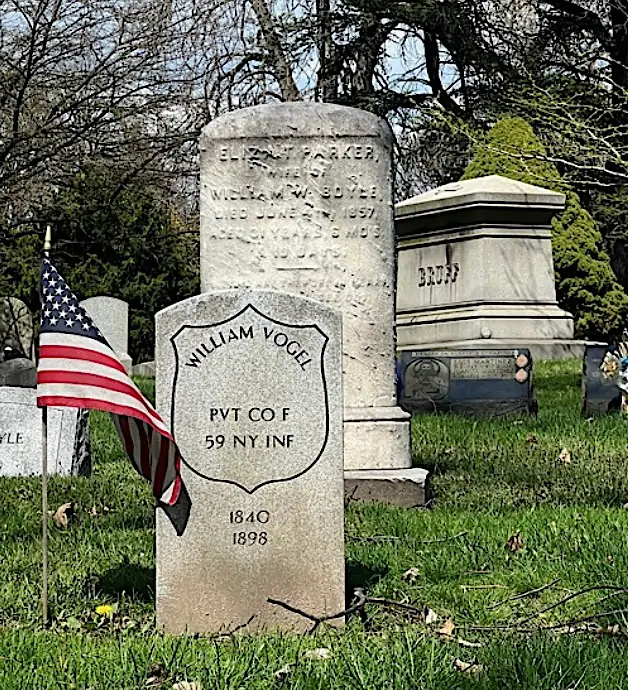
VOGEL, WILLIAM H. (1842-1890). Private, 47th New York Infantry, Company C. He enlisted as a private at New York City on May 18, 1861, and mustered into the 47th New York on September 14 of that year. He deserted on June 1, 1865, at Raleigh, North Carolina. Vogel died of phthisis in the Charity Hospital in New York City. Section E, lot 21100.
VOGELL (or VOGEL), HENRY C. (1806-1887). Assistant surgeon and chaplain, 61st New York Infantry. A native of New York City, he graduated from Madison University then studied medicine for two years before turning to the ministry. After studying at the Baptist Theological Seminary, he served as a pastor at Gunton, Elmira and Rome, New York.
When the Civil War broke out, Vogell enlisted as a surgeon at Alexandria, New York, on January 19, 1862, and was commissioned into the 61st New York’s Field and Staff on that day. He also served as chaplain. His regiment, the 61st, was nicknamed “The Astor Regiment” and fought with the Army of the Potomac in Hancock’s 2nd Corps. At Gettysburg, Pennsylvania, Vogell was Brigade Chaplain for Edward E. Cross’s Brigade. He was promoted to assistant surgeon on November 20, 1863, was in charge of rebel prisons after Lee’s surrender, and mustered out on July 25, 1865, at New York City. He was given a pair of silver-lined gold goblets by the regiment honoring his service. Each goblet was inscribed, “A tribute of affectionate remembrance to H. C. Vogell, D.D., from the 61st N.Y.S.V., for duties and services faithfully and successfully performed for the sick in camp and hospital as chaplain and assistant surgeon. Also for his fidelity in administering to the wounded of battlefields, Fair Oaks, Peach Orchard, White Oak Swamp, Malvern Hill, Savage Station, Chase’s Cross Roads. A cup of cold water shall not lose its reward.”
After the War, Vogell retired from the ministry at Rome, New York, where he had served for 20 years, and moved to New York City in 1887. He was active in Masonic organizations and held the position of State chaplain at one point. He last lived at 799 DeKalb Avenue in Brooklyn. The cause of his death was cerebral softening. His daughter inherited the goblets and a silver tobacco box inscribed to him from Brigadier General Miles Nelson, the colonel of his regiment. Section 189, lot 17259.
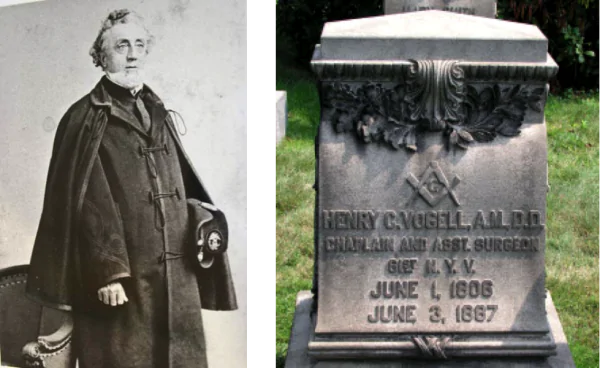
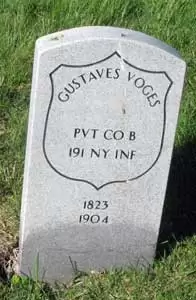
VOGES, GUSTAVES (1823-1904). Private, 191st New York Infantry, Company B. Originally from Germany, he enlisted at Brooklyn on April 3, 1865, mustered into the 191st New York that day, and mustered out on May 3, 1865, at Hart’s Island, New York Harbor. He was a member of the Frank Head Post #16 of the G.A.R. in Brooklyn as of September 25, 1874. His last residence was on Van Brunt Street in Brooklyn. Section 15, lot 17263, grave 2288, graves 15 and 16.
VOGT, FREDERICK (1833-1908). Sergeant, 2nd Independent Battery, New York Light Artillery; 15th New York Heavy Artillery, Companies I and K; private, 29th New York Infantry, Company H. Born in Copenhagen, Denmark, Vogt enlisted as a private at New York City on May 17, 1861, and mustered into Company H of the 29th New York on June 4. He was transferred into the 2nd Independent Battery, New York Light Artillery, on July 21, 1861, was promoted to corporal on June 13, 1862, and to sergeant on April 17, 1863. On June 13, 1863, he mustered out at New York City.
Vogt re-enlisted as a private on August 8, 1863, and mustered immediately into Company I of the 15th New York Heavy Artillery. As per his muster roll, he was a soldier who was 5′ 6″ tall with grey eyes, brown hair and a fair complexion. At some point, he was promoted to sergeant and transferred to Company K. In December 1864, he was detached as a hospital guard to City Point, Virginia, until February of 1865. He mustered out with his company on August 22, 1865, at Washington, D.C.
Vogt’s service in the 2nd Independent Battery during the Civil War is confirmed by the 1890 Veterans Schedule. In 1890, he applied for and received an invalid pension, certificate 588,745. At the time of the 1905 New York State census, he was living in Brooklyn and working at a ferry company. He last lived at 548 Seventh Avenue in Brooklyn. Vogt died from nephritis. Emma Vogt applied for and received a widow’s pension, certificate 641,440. Section 134, lot 16874, grave 206.
VOLCK, GEORGE L. (1844-1909). Private, 47th Regiment, New York State National Guard, Company B; 23rd Regiment, New York State National Guard, Company B. Born in France, Volck immigrated to the United States in 1853. He enlisted at Brooklyn as a private on May 27, 1862, mustered into the 47th Regiment the same day, and mustered out after three months on September 1, 1862, at Brooklyn. He re-enlisted as a private in 1863 for a tour of 30 days and mustered into Company B of the 23rd Regiment. According to the 1900 census, he worked as a public weigher. His last residence was 455 Putnam Avenue, Brooklyn. In 1909, Sarah A. Volck, his widow, applied for and received a pension, certificate 679,754. Section 47, lot 6351.
VON BIBRA, CARL (1830-1899). Corporal, 41st New York Infantry, Company I. A native of Germany, Von Bibra enlisted and mustered into Company I of the 41st New York as a wagoner on June 6, 1861. He received a promotion to corporal of the same company on March 1, 1862. On August 30, 1862, he was wounded in action at Second Bull Run, Virginia, and was discharged for disability at Washington, D.C., on February 18, 1863. His last residence was 428 13th Street, Brooklyn. Section 2, lot 5499, grave 655.
VON FLIEDNER, LEO A. (1840-1898). Sergeant, United States Artillery, Battery E. Originally from Russia, Von Fliedner came to the United States at age sixteen. According to his obituary in The New York Times, he was a sergeant in Battery E of the United States Artillery during the Civil War. A real estate agent with 17 children, he belonged to the James C. Rice Post #29 of the G.A.R. In 1882, his application for an invalid pension was granted under certificate 370,235. He last lived at 417 West 42nd Street in Manhattan but died at his summer residence on West 15th Street in Coney Island. Ellen Von Fliedner, who is interred with him, applied for a widow’s pension, application 681,595, but there is no evidence that it was certified. Section 183, lot 19718.
VON FUERSTENAN (or VAN FÜRSTENAU), LOUIS (or BARON, VON ROTHE) (1819-?). Sergeant, 103rd New York Infantry, Companies C and E. He enlisted as a private at New York City on December 7, 1861, mustered into the 103rd New York on February 15, 1862, and was discharged for disability at Washington, D.C., on December 12, 1862. A reference card, filed under the name Baron Fuerstenan, indicates that he was promoted to sergeant, but the date of that promotion is unknown. Section 43, lot 82.
VON GILSA (or VON GILZA), LEOPOLD (1824-1870). Colonel, 41st New York Infantry. Born in Erfurt, Prussia, his father was a prominent officer in the Prussian Army’s 31st Regiment. Von Gilsa’s father died when he was only nine; his mother remarried another officer from that regiment two years later. Leopold finished his education at the Cadet Corps, and was accepted into the 31st Regiment in 1841, at age seventeen. The details of von Gilsa’s service in Europe are outlined in Rebel In the Blue, A Story of Colonel Leopold von Gilsa by Stefan Slivka in Blue & Gray Magazine (Vol. XXXII, #3, published in 2016) Leopold von Gilsa distinguished himself as a second lieutenant in the first year of the Schleswig-Holstein rebellion in 1848 when the Prussians defeated the Danes in the Battle of Schleswig on April 23, 1848. At that time, the Prussians were called upon to help the large German population in the provinces of Schleswig and Holstein who wanted to join the German Confederation and leave their union with Denmark where an ineffectual king had inherited the throne. After that battle and the subsequent signing of the Treaty of Malmo, the 31st returned home to a joyous welcome in Berlin.
Von Gilsa’s role in the fighting, however, did not end. He was transferred to the 4th Infantry Regiment in December 1848, when there was German rebellion in the Baden-Wurtemberg region. Slivka notes that Von Gilsa’s heart was not in this battle and that after serving through 1849, he resigned from the regiment in February 1850. He then joined the Schleswig-Holstein army in June 1850 in their fight against the Danes as a captain of the 5th Jaeger Company. Von Gilsa clashed with his superiors and was sentenced to ten days of house arrest for circulating a memo that was not acceptable to his superior officer. After the peace was signed between the Danes and the Germans, the Schleswig-Hoslstein army was dissolved on March 31, 1851. Although some sources report that von Gilsa served on the side of the Danes in the Schleswig-Holstein battles, Slivka reports that that is inaccurate; such an action would have been considered the act of a traitor.
In 1853, von Gilsa immigrated to the United States where he found friendship in many German enclaves. After settling in New York City, he was a musician, singer and schoolteacher. During the Civil War, Leopold von Gilsa mustered in as colonel of the 41st New York Infantry, also known as the DeKalb Regiment, in June 1861. Slivka reports that von Gilsa’s previous military service in Europe and his familiarity with the men in the regiment made him a clear choice as colonel. He was wounded in the leg at Cross Keys, Virginia, a year later; that injury put him out of action for several months. He then commanded the 1st Brigade, 1st Division of the 11th Corps at Folly Island, South Carolina. At Chancellorsville, Virginia, his brigade was overrun by Confederate General Stonewall Jackson’s flank attack. Von Gilsa had warned his division commander, Charles Devens, that Confederates were in the woods on their flank, but Devens ignored those warnings.
Outspoken and hot-tempered, von Gilsa was arrested on the march to Gettysburg for allowing more than one man from each unit of his brigade to fetch water for the others on a hot day; they were thirsty after marching in their woolen uniforms. On the arrival at the battlefield, division commander General Francis Barlow relented and allowed von Gilsa to take command of his troops. At Gettysburg, Pennsylvania, his men fought near Barlow’s Knoll but were outflanked and retreated. They were on Cemetery Hill for the battles of July 2 and 3. Slivka notes that von Gilsa vainly tried to stop his men from fleeing on July 2 and July 3. The 41st was then sent to Folly Island where von Gilsa took sick. When the 41st returned to New York in June 1864, there were only 327 veterans left from the close to 1,500 original recruits. In January 1865, he was made colonel of the 191st New York Infantry, but the regiment did not complete its organization.
In 1868, von Gilsa became a naturalized citizen. He applied for and received an invalid pension in 1869. As per his obituary in The New York Times, he was a strict disciplinarian who was idolized by his troops for his fairness. The obituary also noted that the War took a severe toll on his health. In civilian life, he was a piano salesman in New York City. He last lived at 226 East 21st Street in Manhattan. Slivka notes that his superiors, Sigel, Barlow and Carl Schurz, attended his funeral. The Gilsa Post #264 of the G.A.R. was named in his honor. Section 153, lot 19308.
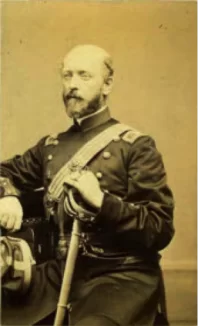
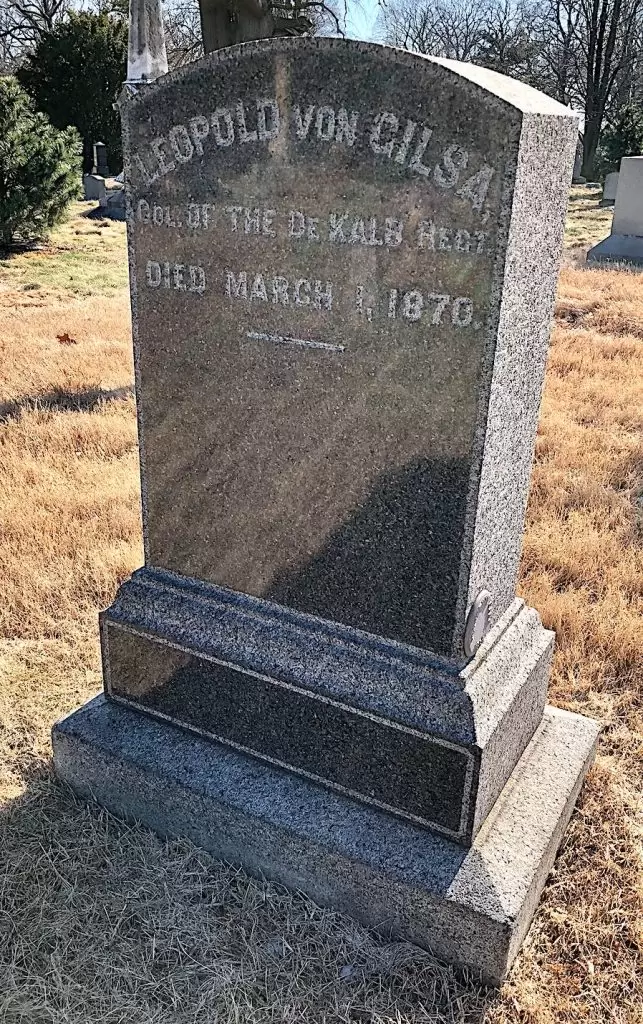
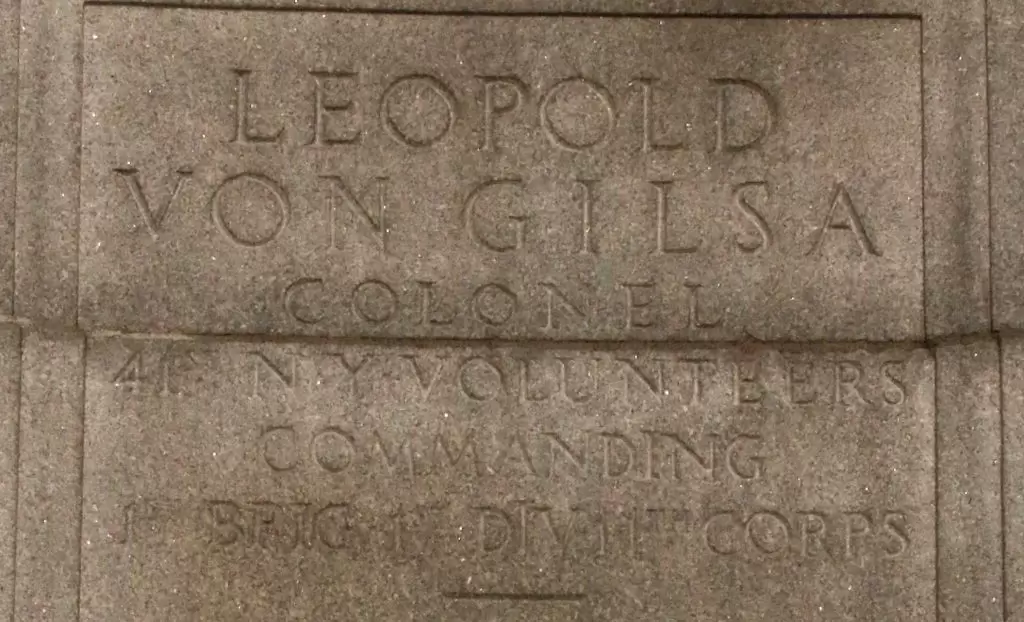
VON GLAHN, GEORGE WILLIAM (1838-1882). Private, 1st New Jersey Infantry, Company I; Veteran Reserve Corps. Born in Germany, he enlisted as a private on May 2, 1861, and mustered into Company I, 1st New Jersey Infantry, on June 4. He was transferred into the Veteran Reserve Corps on September 30, 1863, from which he was discharged on June 4, 1864. He last resided on Adelphi Street, Brooklyn, where he committed suicide by cutting his throat. Section 148, lot 21000.
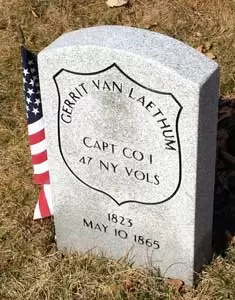
VON LAETHUM (or VAN LAETHUM), GARRETT (or GERRIT) (1823-1865). Captain, 47th New York Infantry, Company I. Von Laethum was born in Holland, and served his adopted homeland during the Civil War. Census records for 1860 indicate that he was employed as an interpreter. His obituary in the Brooklyn Daily Eagle notes that he began service at the start of the Civil War but had to resign due to ill health. Captains J. H. Reynolds, George Tucker and Charles Moore of his regiment wrote the following letter upon hearing of his resignation:
Dear Sir-The Board of Line directors has received your resignation as Captain of Company I of this Regiment, with feelings of most profound regret. Associated as you have been with us, from the organization of the regiment, we will more sadly miss you than if you had only lately joined us. We cannot lose this opportunity of testifying to your many sterling qualities as a soldier and gentleman; prompt and courteous in the execution of your duties, considerate and kind to every one, we can only hope that he who fills the post just vacated by you may embrace as many good qualities of head and heart, and may fill the void in our circle, as creditably. The Field, Staff and Company officers all unite in this expression of regret, and trust that in whatever position fortune may place you that success, prosperity, and fame may crown your endeavors. We are truly and sincerely, your friends.
He last resided on Huntington Street in Brooklyn. He died of consumption on May 4, 1865. Section 115, lot 13536 (Soldiers’ Lot), grave 14.
VON MENGENSEN (or MENGERSEN, MENGERSON, MENGERSSEN), WILLIAM (1832-1862). Captain, 8th New York Infantry, Company B. Von Mengensen’s name was on the manifest of the Hamburg Passenger Lists as W. Mengersen, a landman who lived in Tesen, Germany, who departed from Hamburg on the Austria on April 30, 1858. During the Civil War, he enlisted as a first lieutenant at New York City on April 23, 1861, and was commissioned into Company B of the 8th New York that same day; his name appeared on the rolls as William Mengerson. He was promoted to captain on August 8, 1861, and mustered out at New York City in July 1862. According to the Register of Deaths of Volunteers, he died on July 12, 1862, in New York City; however, his obituary lists the date of his death as July 18 and the cause of his death as typhoid fever.
On July 21, 1862, the New York Daily Tribune reported on Captain Von Mengerssen’s funeral. That article noted that Company B of the 5th New York State Militia acted as escort. Among those in attendance were Colonel Leopold Von Gilsa (see) and sick and wounded volunteers belonging to German regiments. His burial at Green-Wood included military honors. He last lived at 6 Bond Street in Brooklyn. As per filings in the Surrogate’s Court, he had been a resident of New York City and died without a will. Section B, lot 8575, grave 382.
VON NOSTITZ, HANS (or JOHN) (1836-1890). Major, 22nd New York Cavalry; captain, 29th New York Infantry, Company E. Born in Saxony, Germany, to a wealthy family, Van Nostitz received an appointment in the German Army after graduating school. He came to the United States in 1857 and at the outbreak of the Civil War, enlisted at New York City on May 15, 1861, as a captain. On June 4, 1861, he was commissioned into Company E of the 29th New York, from which he was dismissed on October 29, 1862. According to his obituary in The New York Times, he was appointed major of the 22nd New York Cavalry, which formed part of Sheridan’s command in the Shenandoah Valley.
After the War, he served under Maximilian in Mexico and was present at his death. For 23 years, Von Nostitz was an engineer in the Brooklyn Department of City Works. In addition, he was a member of German societies in New York. He died at his home at 128 Dean Street in Brooklyn. Section 141, lot 24855.
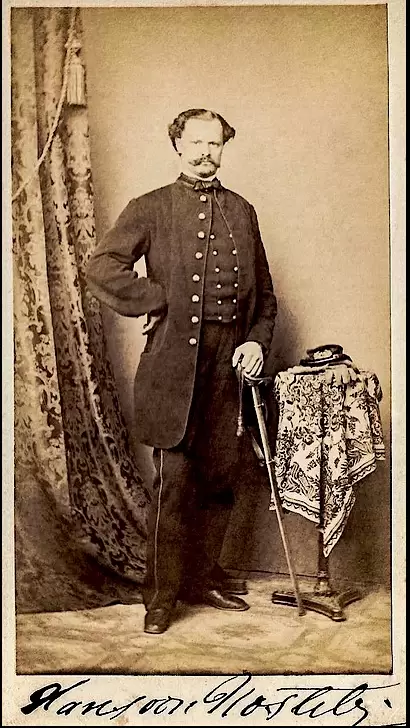
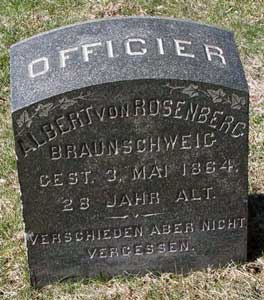
VON ROSENBERG, ALBERT (1834-1864). Captain, 58th New York Infantry, Company A; first lieutenant, 29th New York Infantry, Companies I and H. A native of Braunschweig, Germany, Von Rosenberg enlisted as a second lieutenant at Franklin, New York, on May 16, 1862, and was commissioned into Company H of the 29th New York that same date. The 29th was familiarly known as Astor’s Rifles or the 1st German Infantry. He was wounded in action at Groveton, Virginia, on August 29, 1862.
Von Rosenberg was promoted to first lieutenant on September 7, 1862, and was transferred to Company I at some point before he resigned on May 9, 1863. He had enlisted as a captain in the field in Virginia, on January 1, 1863, and was commissioned into the 58th New York in that rank on November 1, 1863. On May 3, 1864, he succumbed to consumption at New York City; a letter was sent to headquarters bearing news of his death. His tombstone is inscribed “officier (sic).” Section 116, lot 4073.
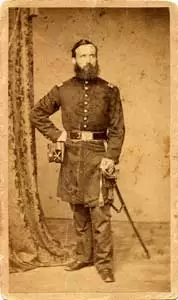
VON WITTKE, JULIUS A. (1829-1873). Captain, 4th New York Cavalry, Companies I and A. Of German birth, he was a carpenter and furniture-maker at the onset of the Civil War. He enlisted as a first lieutenant on December 9, 1861, and was commissioned into the 4th New York Cavalry on that date. In the spring of 1862, he was confined at the General Hospital in Washington, D.C., most likely due to consumption, but returned to service on May 19 and was promoted to captain of Company A on May 21. Von Wittke took sick again, was hospitalized at Cumberland Hospital in Baltimore, Maryland, and was apparently dropped from the rolls on August 13, 1862, by Special Order 189. However, according to another document, he resigned on October 10, 1862, at Fairfax Courthouse, Virginia, citing physical inability to perform his duties. The resignation became effective on October 20.
Although the circumstances are unknown, on December 2, 1862, Von Wittke returned to the same regiment and company and was commissioned as captain after his promotion on November 28 of that year. He resigned on April 9, 1863, at Camp Potomac citing his health. In 1890, his application for an invalid pension was granted under certificate 305,375. His last residence was 351 20th Street in Brooklyn. Section 85, lot 3330, grave 168.
VOORHEES, VALENTINE H. (1830-1889). First lieutenant, New York Marine Light Artillery, Company B; second lieutenant, 13th New York Heavy Artillery, Company K. He enlisted at New York City as a second lieutenant on October 9, 1861, was commissioned into the New York Marine Light Artillery on that day, was promoted to first lieutenant on March 14, 1862, and resigned on September 16, 1862. He re-enlisted on November 30, 1864, at New Berne, North Carolina, as a second lieutenant, was immediately commissioned into the 13th New York Heavy Artillery, and resigned on March 23, 1865, at Portsmouth, Virginia. He resided at 30 Clifton Place in Brooklyn at the time of his death from apoplexy. Section 57, lot 8560.
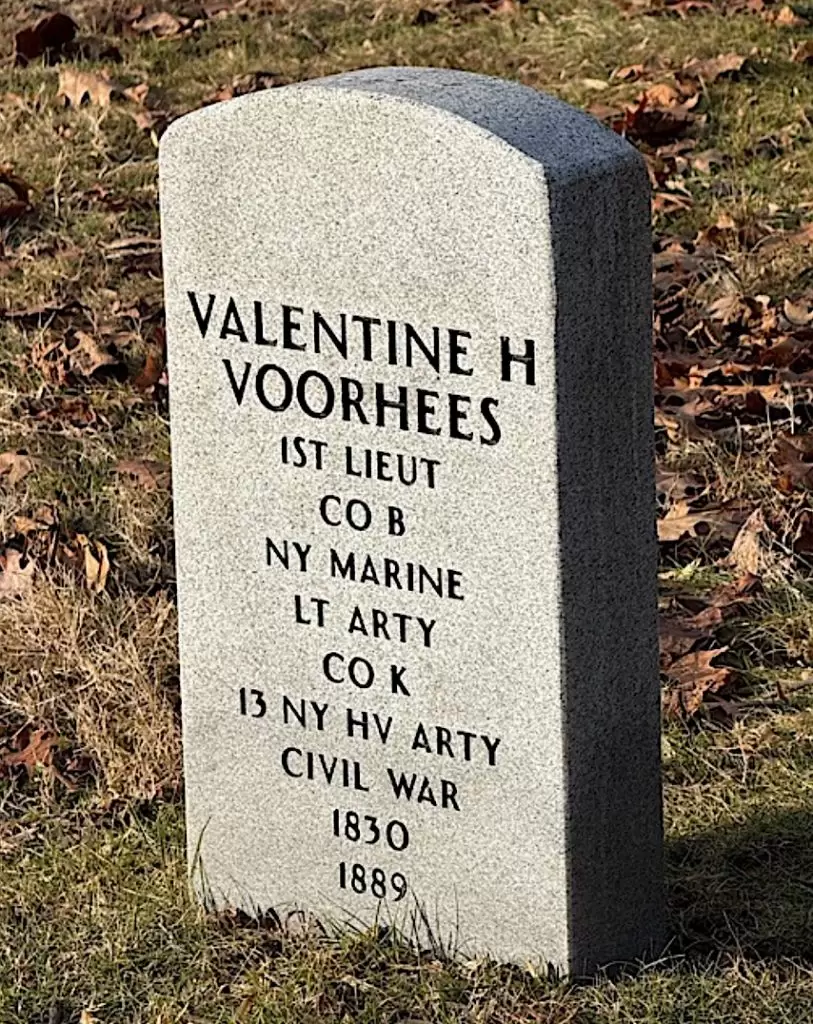
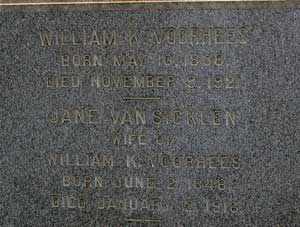
VOORHEES, WILLIAM KOUWENHOVEN. (1838-1921) Trooper, Kings County Cavalry, Troop A. A Brooklynite by birth, he enlisted there as a trooper and served in Troop A, Kings County (New York) Cavalry. Further details are unknown.
The head of a grain company that bore his name, Voorhees was a charter member of the New York Produce Exchange. Active in military organizations, he was a member of the Ulysses S. Grant Post #327 of the Grand Army of the Republic, was grand master of the Covenant Lodge #758 of the Freemasons, and belonged to the Mason Veterans Association. Among the civic associations in which he participated were the Saint Nicholas Society of Nassau, the Society of Old Brooklynites where he was a vice president, and the Holland Society of Greater New York in which he was a board member. His last residence was at the Hotel Mohawk, 379 Washington Avenue in Brooklyn. Section 193, lot 33102.
VOSBURG (or VOSBURGH), CHARLES G. (1833-1887). First lieutenant, 37th New York Infantry, Companies F and B. A native of New York City, Vosburg enlisted there as a private on May 16, 1861, and mustered into Company F of the 37th New York on June 7. On January 21, 1862, he was promoted to first lieutenant and simultaneously transferred to Company B, then was transferred back to Company F on January 28, 1863. Vosburg was taken as a prisoner of war on May 3, 1863, at Chancellorsville, Virginia, and mustered out on June 22, 1863, at New York City. He last lived at 589 First Avenue in Manhattan. His death was caused by phthisis (tuberculosis.) Section 121, lot 7639, grave 19.
VOSBURGH, ABRAHAM (or ABRAM) S. (1825-1861). Colonel, 71st Regiment, New York State Militia. A native of Kinderhook, New York, his ancestors were “Holland Dutch” colonists who settled in Columbia County, New York, in 1642. His father fought in the War of 1812 and his grandfather was in the Continental Army during the Revolutionary War. After moving to New York City in 1844, Vosburgh was commissioned as an engineer in the 71st State Militia in June 1849. Employed in the storage business, he was a colonel in the 71st New York State Militia from 1852-61. On April 20, 1861, he issued the following orders to those in his regiment:
“In compliance with orders from the Commander-in-Chief and Division orders, April 19th, this regiment will assemble at their several armories on tomorrow, Sunday, at 7 A.M., in full fatigue, with fatigue cap, and with overcoat and knapsack, to embark for Washington City.
The regimental line will be formed in Bond Street, right on Broadway, at half-past eight o’clock, precisely.
The men each take one blanket rolled on top of knapsack, a sufficiency of underclothing, an extra pair of boots or shoes, knife, fork, spoon, tin cup and plate, body-belt, and will also provide themselves with cap pouches.
The men will be careful to provide themselves with one day’s rations. Three servants will be allowed to each company, who must report to the Quartermaster at the armory, Centre Market, at 5 P.M., Saturday.
Each officer will be allowed one small trunk, with his name marked on, and sent to the armory by five o’clock.
Every man is expected to report for duty. Now is the time for men to respond.
Quartermaster Roosevelt will report to the Major-General at his office, Tryon Row, for orders for transportation and ammunition.
The band, field music, and non-commissioned staff will report to the Colonel, at the armory, Centre Market, 7 A.M., Sunday.”
On April 22, 1861, he led the 71st New York to Washington, one of the first regiments to be sent to defend the nation’s capital. He soon died in Washington, D.C., of consumption, on May 20, an early casualty of the Civil War. The following hymn was sung by the troops of the 71st at his funeral:
Hush! Our colonel lies in slumber,
Folded close in death’s cold arms;
Never more he’ll join our numbers,
Never more hear war’s alarms.
Frank by nature, brave and loyal–
Dearly loved and prized was he;
Now his wreath is more than royal–
In our hearts enshrined he’ll be.
Never more the drums swift beating,
Nor the clarion trumpet shrill,
Shall arouse him from his sleeping,
And his breast with ardor fill.
He was loved by all his brothers
In the camp – none more than he;
Everything he shared with others,
Now we claim his memory.
And the Seventy-first will cherish
All his virtues, all his aims.
If in battle we shall perish,
Doing what stern duties claim,
He will gaze with satisfaction,
Smiling as he used to smile,
To regard our noble action,
And be proud of us the while.
Wrap our glorious Flag about him,
Let the stripes and stars be seen,
Whilst his comrades who surround him,
Swear to keep his memory green;
Then will his proud soul elate him
Higher still to camps above,
Where the angel warriors ‘wait him,
And a sword of perfect love.
President Abraham Lincoln laid a laurel wreath on his body in Washington; he was interred at Green-Wood on May 23, 1861. Several years later, members of his unit, the 71st Regiment of the New York State National Guard, erected a monument to him at Green-Wood after collecting $5,000 in voluntary contributions. The New York Times reported on May 24, 1866, about the ceremonial unveiling of the memorial, “…The formal inauguration of the monument erected by the 71st Regiment to the memory of Col. Abraham S. Vosburgh, took place yesterday afternoon at Greenwood Cemetery. The ceremonies attendant upon the occasion were imposing in their character, embracing the burial of the remains of the deceased and lamented Colonel, a military salute over the grave and an address by Mayor Hoffman, upon the life and services of the man whose memory the monument was intended to perpetuate…” Topped by an eagle and bearing the inscription “Pro Patria” (for country), this monument was one of the leading attractions of the cemetery. It was surrounded by a spectacular cast iron fence, whose posts were bayoneted rifles. Its gate was adorned with a cast iron Union cap, a belt, and a sword. For years after his burial, members of the 71st fired three salutes to their fallen colonel on Decoration Day. His last residence was at 806 Greenwich Street in Manhattan. Section 123, lot 13808.
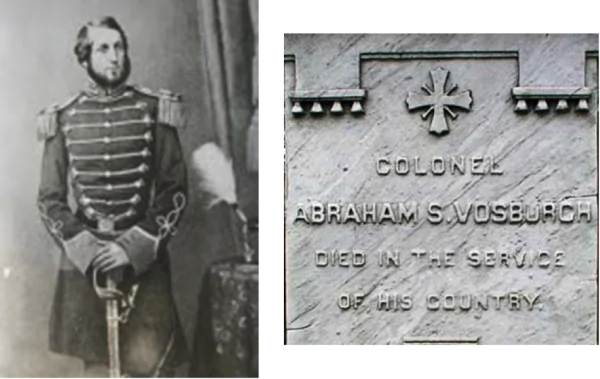
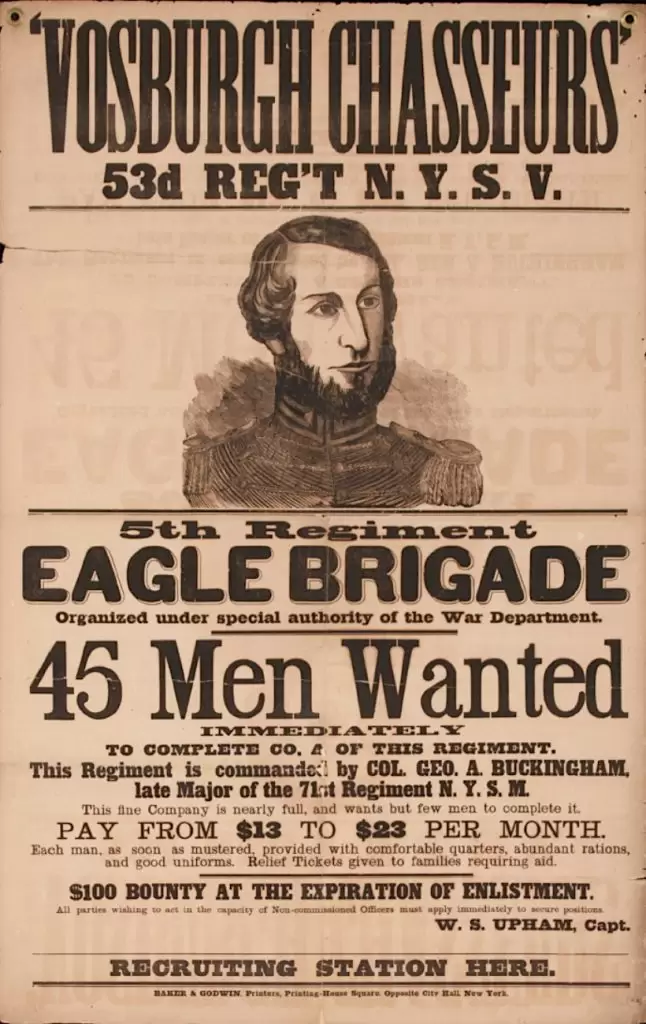
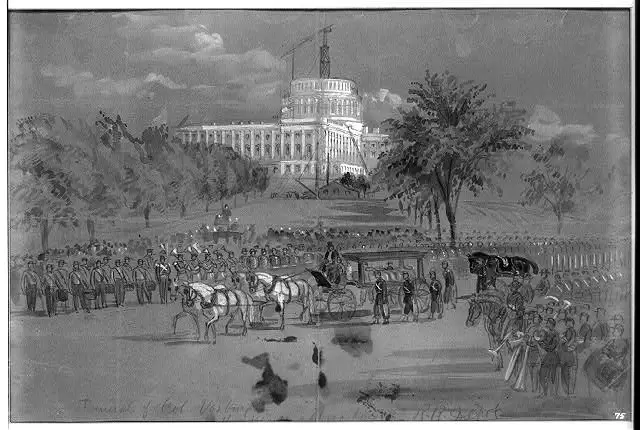
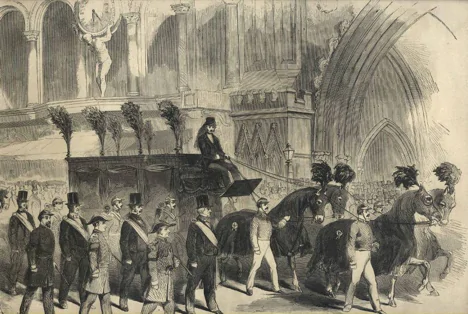
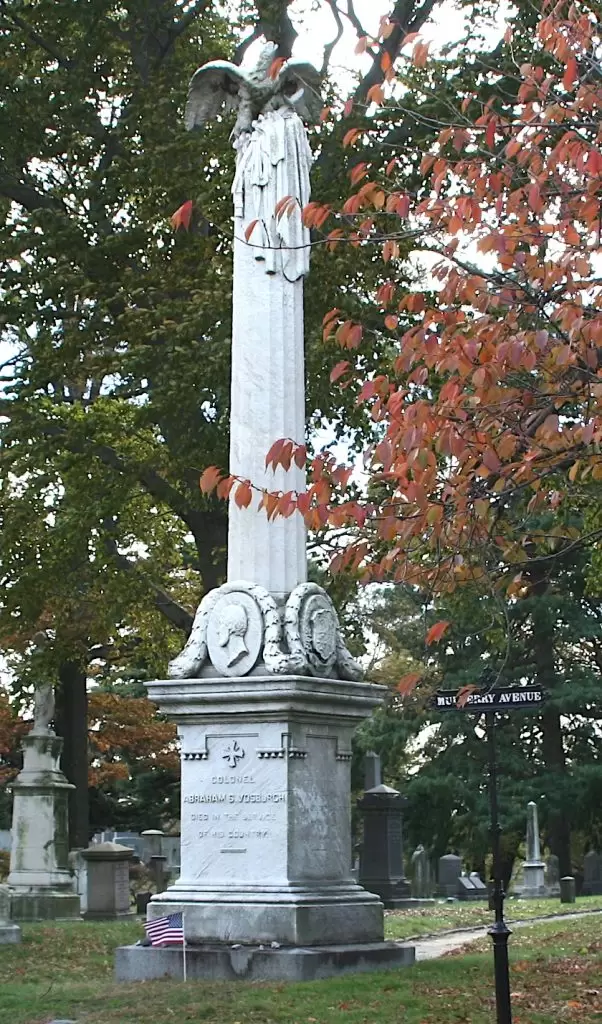
VOSBURGH, MILTON (1844-1891). Private, 36th New York Infantry, Company H. A native of New York City, Vosburgh enlisted there on June 26, 1861, mustered immediately into the 36th New York, and mustered out at New York City on July 15, 1863. Although another soldier history listed a Milton Vosburgh as deserting from Company I of the 36th at Rikers Island, New York City, on July 8, 1861, this contradicts the other information and his pension record indicates that he served in Company H. He drowned in Prince’s Bay, New York. In 1892, Charlotte Vosburgh applied for and received a widow’s pension, certificate 367,265. Section 164, lot 15971.
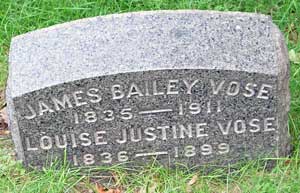
VOSE, JAMES BAILEY (1835-1911). First lieutenant, 165th New York, Company F. Born in England, he enlisted on November 22, 1862, at New York City, was commissioned in that day, and was discharged the next week on November 28, 1862, as per an order from the Department of the Gulf. Soon after, on December 3, he was commissioned as a first lieutenant with rank to November 22, mustered into the 165th New York, and was discharged on May 11, 1863, with a letter to the Adjutant General’s Office filed with his record. According to William Swinton’s History of the Seventh Regiment (1876), Vose also served in Company F of that unit; the dates of his service with the 7th were not noted. A resident of Brooklyn, he last lived on Albany Avenue. He succumbed to myocarditis. Section 135, lot 30010, grave 323.
VOUTE, JOHN OSCAR (1841-1906). Private, 13th Regiment, New York State Militia, Company G. Originally from Germany, he immigrated to the United States on July 5, 1844, on board the Fosca Helena which departed from Rotterdam in the Netherlands. During the Civil War, Voute enlisted as a private and served in the 13th Regiment but the specific dates are unknown.
According to the 1870 census, Voute was living in Brooklyn. He was a member of the Lafayette Post #140 of the Grand Army of the Republic in New York City and a Freemason. In 1905, his application for a pension was granted under certificate 1,109,227. As per his obituary in The New York Times, he worked for the New York Life Insurance Company for forty-two years, retiring at half pay from his position as assistant cashier in 1903. His death was listed as a suicide by a shot to his temple. The aforementioned obituary confirmed his Civil War service. It also noted that he lived in a “handsome” house and his constant worry that his pension would be cut due to retrenchments at the company likely was the reason he took his life. Voute last resided at 64 Myrtle Avenue, Montclair, New Jersey. In 1908, Henrietta Voute applied for and was granted a widow’s pension, certificate 657,744. Section D, lot 19793.
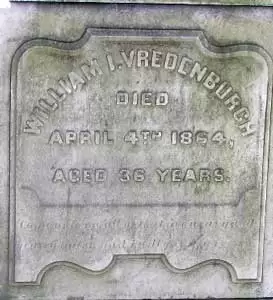
VREDENBURGH, WILLIAM ISAAC (1828-1864). Captain, 9th Regiment, New York State National Guard, Company A. A native of New York State, he enlisted at New York City, was commissioned as captain in Company A, 9th Regiment, New York State National Guard, and was discharged on an unknown date. After he succumbed to consumption, members of the 9th National Guard were invited to his funeral at his parents’ residence at 20 Mott Street in Manhattan. Section 150, lot 14839.
VROOM, ALFRED HINE (1835-1872). First lieutenant, 21st New Jersey Infantry, Company A. After enlisting as a first lieutenant on September 9, 1862, Vroom, who was born in Somerville, New Jersey, was commissioned into the 21st New Jersey six days later. He served with the Army of the Potomac in Virginia and fought at the Battle of Fredericksburg and the storming of Marye’s Heights there. He mustered out on June 19, 1863, at Trenton, New Jersey. His last residence was in Jersey City, New Jersey, but he died in Minnesota. Section 99, lot 1874.
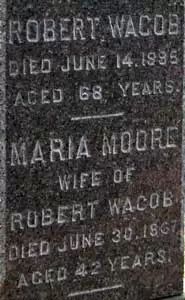
WACOB, ROBERT (1827-1895). Sergeant, 79th New York Infantry, Companies G, A, B, and D. Born in Ireland, Wacob enlisted as a private on August 15, 1862, at New York City. On that day, he mustered into Company G of the 79th New York. From there he transferred intra-regimentally to Company A on May 31, 1864, and to Company B on July 31, 1864. During his service in Company B, he was promoted to corporal on September 26, 1864. On December 1, 1864, he was promoted to sergeant effective upon his transfer to Company D. He mustered out on May 30, 1865, at Alexandria, Virginia. He successfully applied for a pension in 1872, certificate 847,942. He last resided in Port Chester, New York. Section 165, lot 17353, grave 3.
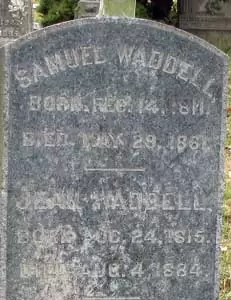
WADDELL, SAMUEL (1811-1861). Captain, 36th New York Infantry. Prior to the Civil War, Waddell was an assistant engineer in the Fire Department and had been the fire warden and assessor in the Sixth Ward in New York City. As per his muster roll, he was commissioned captain with rank from May 16, 1861, but did not muster. He was paid $86.70 for sixteen days of service. He died of disease on or about June 7, 1861, at New York City. As per his obituary, he accidentally fell ten days before his death and a splinter entered his palm; tetanus set in and caused his death. The officers of the 36th, also known as the Washington Volunteers, made the following resolutions upon hearing of the death of Waddell:
Resolved: That the officers of this regiment will attend in a body the funeral of the late Capt. Waddell from his late residence No. 130 Leonard Street.
Resolved: That the usual badge of mourning will be worn for thirty days.
Resolved: That a committee of three, consisting of Major Nathaniel Finch, Lieutenant Colonel Chas. K. Whitney, and Lieutenant H.N. Martin, be appointed to present a copy of these resolutions to the afflicted family.
Resolved: That a copy of these resolutions be published in The New York Times.
He last lived at 130 Leonard Street in New York City. Section 22, lot 6872.
WADE, JAMES (1818-1864). Private, 174th New York Infantry, Company I. Wade enlisted as a private at New York City on October 16, 1862, mustered into the 174th New York on October 22, and was discharged for disability on August 27, 1863, at Baton Rouge, Louisiana. He last resided at 71 Ludlow Street in New York City. His death was attributed to “debility.” Section 163, lot 14635.
WADSWORTH, DANIEL (1821-1909). Private, 6th New York Cavalry, Company C. Wadsworth, who was born in Burlington, Vermont, enlisted as a private at Dansville, New York, on July 25, 1862, mustered into his company that same day, and was discharged for disability on October 29, 1862, at Lovettsville, New York. Wadsworth last lived at 204 President Street in Brooklyn. Section 15, lot 19350.
WAGNER, ALEXANDER (1830-1884). Private, 31st New York Battalion; 30th Independent Battery, New York Light Artillery. Of German birth, Wagner enlisted as a private on September 10, 1861, and mustered into the 31st New York Battalion the next day. He later served in the 30th New York Light Artillery. His last address was 257 19th Street in Brooklyn. His death was caused by phthisis. Section 2, lot 5499, grave 814.
WAGNER, CARL (1841-1886). Private, 20th New York Infantry, Company E; 15th New York Light Artillery. A German native, Wagner enlisted as a private on May 3, 1861, at New York City, mustered into the 20th New York three days later, and mustered out on June 1, 1863, at New York City. He subsequently re-enlisted and mustered into the 15th New York Light Artillery, but the details of that service are not specified. His last residence was 294 11th Street in Brooklyn. Section 85, lot 19417, grave 17.
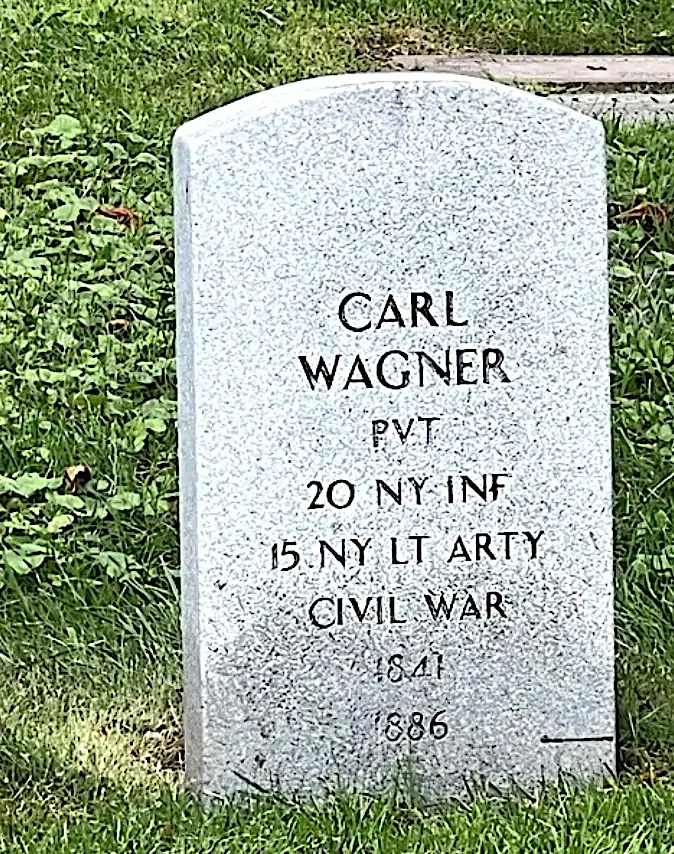
WAGNER, FREDERICK (1835-1888). Second lieutenant, 66th New York Infantry, Company C. Born in Germany, he enlisted at New York City as a sergeant on September 20, 1861, and mustered in on November 5, 1861. He was promoted to first sergeant on January 30, 1862, and to second lieutenant on October 23, 1862. Wagner was dismissed on August 15, 1863. He last resided in South Brooklyn. Cemetery records attribute his death to “fatty degeneration of the heart.” Section 3, lot 21025, grave 482.
WAGNER, LUDWIG (1821-1881). Private, 68th New York Infantry, Company D. Originally from Germany, Wagner enlisted as a private at New York City on December 5, 1864, mustered into the 68th New York that day, and mustered out on November 30, 1865, at Fort Pulaski, Georgia. His last address was on Spring Street in Manhattan. Section 184, lot 19411.
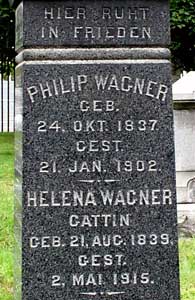
WAGNER, PHILIP (1837-1902). Private, 2nd New York Cavalry, Company G. Of German origin, Wagner enlisted as a private at New York City on August 9, 1861, mustered into the 2nd Cavalry on August 30, and was discharged for disability on October 14, 1862, at Philadelphia, Pennsylvania.
As per his obituary in the Brooklyn Daily Eagle, he lived in Brooklyn for 56 years and was employed in the wine and liquor business for 20 years. He was a charter member of the Brooklyn Saengorbund, a singing society that had its origin in Germany. He last lived at 555 Fifth Avenue in Brooklyn. His cause of death was cancer. Section 137, lot 31031.
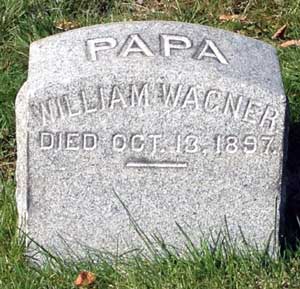
WAGNER, WILHELM (or WILLIAM) (1824-1897). Private, 68th New York Infantry, Company E. Originally from Germany, Wagner enlisted at New York City as a private on August 8, 1861, mustered into the 68th New York two days later, and was discharged for disability on January 10, 1863, at Baltimore, Maryland. In 1889, he applied for and received an invalid pension, certificate 815,998. His last residence was 216 East 77th Street in Manhattan. His wife received a widow’s pension, certificate 472,309. Section 122, lot 17806, grave 76.
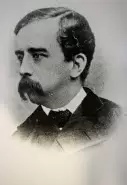
WAINWRIGHT, CHARLES SHIELS (1826-1907). Brigadier general by brevet; colonel, 1st New York Light Artillery. Born in New York City and a farmer by trade, he enlisted as major in the 1st New York Light Artillery on September 25, 1861, at Elmira, New York. On April 30, 1862, he was promoted to lieutenant colonel. In his journal recording events at the Battle of Williamsburg, Virginia, a week later on May 5, he described a stampede in which one of his officers, Chauncey McKeever (see), became frenzied:
When we got to within a mile of the front, I heard heavy firing…Pushing on as fast as I could alone, just as I reached the hospital I met the first of a string of ambulances, wagons, and other vehicles, just breaking into a run; the men too were starting, hospital attendants and such like. In fact, [this was] the commencement of a stampede. The road was so narrow at this point that but one wagon could pass at a time. One of my limbers [ammunition carts] was first; all were yelling and hollering to their horses and to those in front to get on. Drawing my sabre, I rode right at the lead driver of the limber, and brought that up short, so stopping the whole concern. The firing at the front was diminishing, and the stampede died out in a few minutes. Just then Third Corps Chief of Staff Chauncey McKeever came galloping back, waving his sword and swearing like a demon, “Shoot the cowards!” In a few minutes a couple of squadrons of cavalry, who had been sent around by a road to our left came back. McKeever insisted they would fire on the wagoners, though I told him that the fright was all over. The man seemed crazy, so fearing the officer in command of the cavalry might be as great a fool as himself and fire, I pushed on to the front out of the way.
On June 1, 1862, he rose to the rank of colonel. On September 1, 1862, he wrote from Alexandria, Virginia,
There is an immense amount of ill feeling all through the army, especially against [General John] Pope [who Lincoln had appointed to command the Army of the Potomac]; and the cry for “little Mac” [General George McClellan] grows louder every day, not only from his own old army, but from all the other troops. I hear that he has been put in command of the defences (sic) of Washington, and all the troops within them, which must now include all Pope’s and McDowell’s commands as well as the Army of the Potomac, except the garrisons up the river…” He commanded his forces later that month at Antietam, Maryland, and at Fredericksburg, Virginia, on December 11-15 of that year. Major General John F. Reynolds, United States Army, praised Wainwright in his report of December 21, 1862, “I am indebted for the excellent judgment he displayed in the management and disposition of the whole artillery of the corps, and for the admirable manner in which the damages it received were repaired on the field and the guns again brought into action under his supervision…
He fought at Chancellorsville, Virginia, and at Gettysburg, Pennsylvania. On July 1, 1863, he wrote in his diary about his troops’ retreat as they were under Rebel fire at Cemetery Ridge:
…”When I returned (to the seminary), I found the Fifth Maine limbering up. I stopped them, when Lieutenant Whitaker told me that General Wadsworth had said they had better withdraw. Remembering what I had supposed to be Howard’s order to hold Seminary Hill to the last, I had no notion of going off, and rode around to see that none of the guns moved. An officer now informed me that a rebel line was advancing on our right. Looking at it, I was sure that it was the Eleventh Corps, and could not be convinced to the contrary until they opened fire on a portion of that corps which I could now see making for the town. I then at once ordered all to limber up and move at a walk towards the town. I would not allow them to trot for fear of creating a panic. But I had very little hope for getting them all off, for the rebs were close upon us; so near that a big fellow had planted the colors of his regiment on a pile of rails within fifty yards of the muzzles of Cooper’s gun at the moment he received his order to limber up. As I sat on the hill watching my pieces file past and cautioning each one not to trot, there was not a doubt in my mind but that I should go to Richmond. Each minute I expected to hear the order to surrender for our infantry had all gone from around me, and there was nothing to stop the advancing line. Just as the last of Stewart’s caissons was coming into the road, a number of the enemy’s skirmishers, sweeping around the south side of the college buildings, opened fire across the road at about fifty yards distance. Our infantry did not return the fire, so there seemed no chance but what they would kill all my horses. Perhaps, though, it was well for me that our infantry instead of making fight took at once and in a body to the left, over the railroad… embankment. This cleared the road and I shouted, ‘Trot! Gallop!’ as loud as I could. It did not take long for the whole eighteen pieces and six caissons to be in full gallop down the road, which being wide allowed them to go three abreast. As I saw the head carriages already at the turn of the road just before entering the town, I felt that now all were safe. And my next duty being to look out a new position for them I galloped to the front. In order to get by the batteries I was obliged to climb over the railroad and enter the town by another street.
“I had hurrahed a little before I was out of the woods. The rebs pulled off the skirt of my coat; that is, after I left the road they got some pieces on the crest we had just left, and fired into the tail of our column, smashing up three of Stewart’s caissons. The rascals south of the road, too, killed the off-wheeler of Lieutenant Wilbur’s last piece; and when he had just got him cut out and was starting again, they shot down three more horses, his own horse, and one of the drivers. So the gun was abandoned. I was terribly grieved when I heard of it, for I had begun to look upon our getting off from that place as quite a feat and wished that it could have been without the loss of a gun. The more I think of it, the more I wonder that we got off at all.
“The streets of the town were full of the troops of two corps. There was very little order amongst them save the Eleventh took one side of the street and we the other; brigades and divisions were pretty well mixed up. Still the men were not panic stricken; most of them were talking and joking. As I pushed through… to the top of Cemetery hill, the existence of which I now learned for the very first time. I reached the top of the hill almost as soon as my first battery. Here I found General Howard who expressed pleasure at seeing me and desired me to take charge of all the artillery, and make the best disposition I could of it…”
Because of his artillery’s valiant defense of Cemetery Hill at Gettysburg on July 2 and 3, 1863, Wainwright Avenue there is named in his honor. He wrote the following to Headquarters about the battle on those two days:
July 2.–During the morning several moving columns of the enemy were shelled at intervals, but no engagements occurred until about 4 p.m., when they planted a battery of four 20-pounders and six 10-pounder Parrotts in a wheat-field on our immediate front, at about 1,300 yards, and opened the most accurate fire I have ever yet seen from their artillery. We replied with our thirteen 3-inch guns with good effect. It was an hour and a half, however, before we were able to compel them to withdraw, and then they hauled off their two right pieces by hand. Twenty-eight dead horses were found on the knoll occupied by this battery. A portion of the guns again took position farther to the right, but were soon silenced, as we could bring an additional number of pieces to bear on them there. Soon after, Captain Cooper’s battery, which had suffered considerably, was relieved by Captain Ricketts’ battery of six 3-inch guns.
About dusk they again opened from a knoll on our left and front, distant 1,800 yards, which fire was followed by a strong attack upon our position by General Rodes’ Louisiana [?] brigade. As their column filed out of the town they came under the fire of the Fifth Maine Battery at about 800 yards. Wheeling into line, they swung around, their right resting on the town, and pushed up the hill, which is quite steep at this corner. As their line became fully unmasked, all the guns which could be brought to bear were opened on them, at first with shrapnel and afterward with canister, making a total of fifteen guns in their front and six on their left flank. Their center and left never mounted the hill at all, but their right worked its way up under cover of the houses, and pushed completely through Wiedrich’s battery into Ricketts’. The cannoneers of both these batteries stood well to their guns, driving the enemy off with fence-rails and stones and capturing a few prisoners. I believe it may be claimed that this attack was almost entirely repelled by the artillery. My surgeon, who was in the town and dressed many of their wounded that night, tells me that they reported their loss in this attack as very great.
July 3.–There was no serious attack upon the position we held during this day’s fight. The batteries fired occasional shots at bodies of the enemy’s troops in the distance during the morning, and joined in the general artillery engagement in the afternoon. The fire of the enemy’s batteries was noticed to be much less accurate than on the previous day, owing, I think, in a measure to their keeping their guns too much under cover of the hills on which they were posted.
With regard to the behavior of the batteries during this three days’ fight, I have only to say that all the officers and men performed their duty to my perfect satisfaction. I would mention the case of a shell exploding immediately under one of Captain Cooper’s guns in the heat of the second day‘s engagement, killing or wounding all the detachment around the gun, yet fire from that piece was reopened before all the wounded men were removed.
Wainwright later served as the Chief of Artillery, 1st Army Corps, Army of the Potomac, and in the same capacity on the staff of Brigadier General Joseph Hooker. His guns are credited with breaking the Confederate attack at the Battle of North Anna, Virginia, on May 23-26, 1864. On June 8, 1864, he wrote in his journal about false reports in New York’s Journal of Commerce and World that Lincoln proclaimed that Grant was in serious trouble and the country in dire straits. He wrote of the suspension of those publications, “…Great blame is laid on Mr. Lincoln for this arbitrary proceeding, but he, poor fellow, I am sure is not to blame; I doubt if he was even consulted in the matter; every day he seems to have ‘less influence with the present Administration.’” On August 1, 1864, Wainwright was promoted by brevet to brigadier general of United States Volunteers “for brave, constant, and efficient services in the battles and marches of the campaign.” Major General George G. Meade also made that recommendation a month later in a note to Secretary of War Stanton on September 19. On June 1, 1865, Brevet Major General Henry J. Hunt, United States Army, in his report from Fort Albany, Virginia, commended Wainwright for efficient performance of duties under arduous circumstances.
After the War, Wainwright lived in New York, Europe and then settled in Washington, D.C., where he was incapacitated with blindness and complications of malaria. He died in Washington, D.C. His lengthy Civil War diary, A Diary of Battle: The Personal Journals of Colonel Charles S. Wainwright, 1861–1865, was published in 1962, and is considered by critics as one of the finest and frankest Civil War diaries in existence. Section 151, lot 16331.
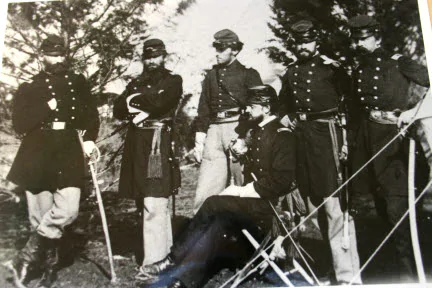
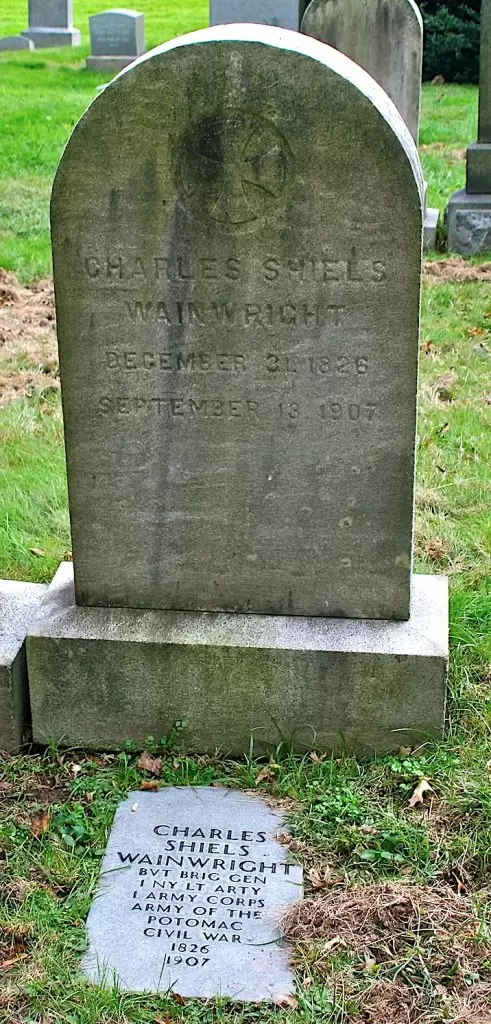
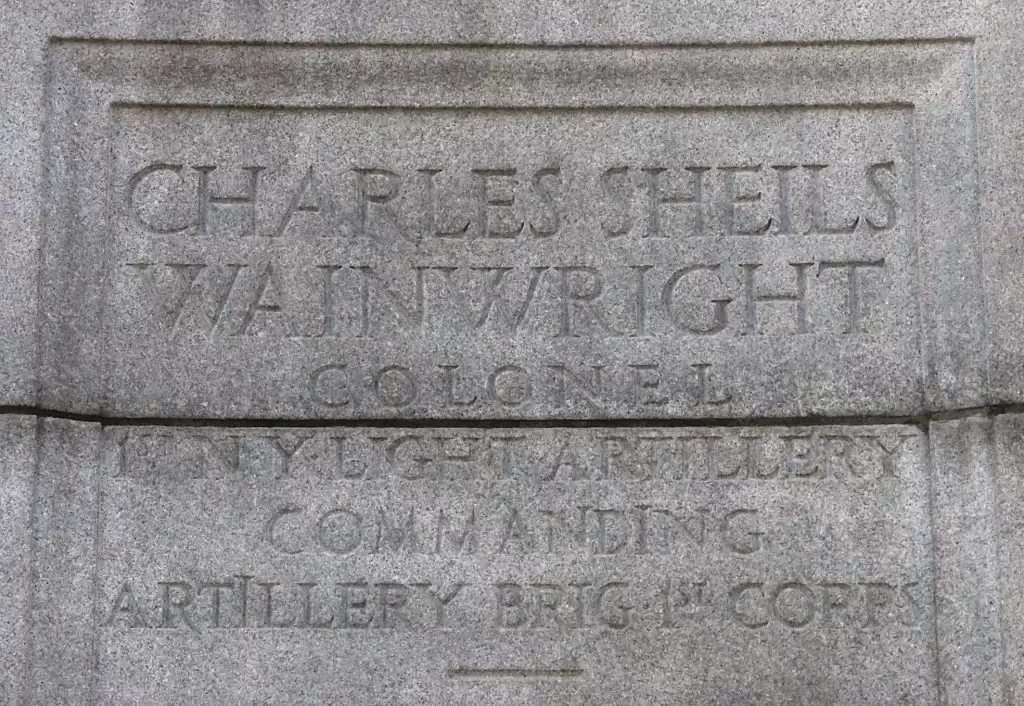
WAIT, EDWARD A. (1835-1869). Private, 25th New York Cavalry, Company G. A native of New York City, Wait enlisted there at the 3rd Congressional District as a private on March 29, 1864, and mustered into the 25th Cavalry on that date. He was reported sick at the time his company mustered out. His last residence was 306 East 30th Street in Manhattan. His remains were moved to the current location on November 6, 1879. Section 10, lot 22945.
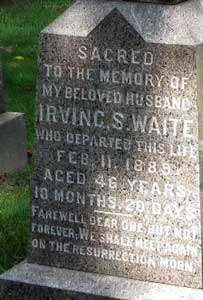
WAITE, IRVING S. (1842-1889). Corporal, 125th New York Infantry, Company A. A native of New York, he enlisted as a corporal on August 1, 1862, at Grafton, New York, and mustered into the 125th New York on August 27. After being taken as a prisoner of war at Harpers Ferry, Virginia, on September 15, 1862, he was paroled there the next day. Waite mustered out at Alexandria, Virginia, on June 5, 1865. His last residence was on West 21st Street in Manhattan, his death attributed to a fall. In 1904, his widow applied for a pension, application 808,641, but there is no certificate number. Section 164, lot 16749.
WAKEFIELD, JAMES (1842-1898). Private, 31st New York Infantry, Company K. Born in England, he enlisted and mustered into the 31st on June 14, 1861. He was discharged for disability on September 21 of that year at Alexandria, Virginia. He last lived at 1031 DeKalb Avenue in Brooklyn. He died from pneumonia. Section 162, lot 15256, grave 3.
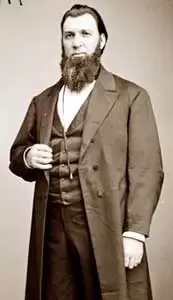
WAKEMAN, ABRAM (1824-1889). Congressman and lawyer. Born in Greenfield Hill, Connecticut, Wakeman first worked as a teacher in New Rochelle, Rockport and Rochester, New York. According to his obituary in the New York Herald, he developed an interest in politics and stumped New York State on behalf of William Henry Harrison. In 1849, he moved to New York City where he was a lawyer, then state assemblyman (1851), and was elected to Congress in 1854 as a Whig. During his time in Congress, he supported the anti-slavery side in the debates over the admission of Kansas to the Union.
When the Civil War began, he raised the 81st Pennsylvania Volunteers. A member of the Republican Convention that nominated Abraham Lincoln, he was appointed postmaster of New York City 1862-1864. The obituary notes that during the Draft Riots in New York City in 1863, he defended the Post Office and in retaliation, his house was ransacked and destroyed.
Subsequently, Wakeman was the surveyor of the Port of New York during the Lincoln and Johnson administrations. After he returned to law, he was one of the proponents of extending the railroads to the ocean and was a developer of Manhattan Beach. Active in many civic associations, he was a member of the Urban League Club, the American Institute and the Historical Society. In addition, he founded the Irving Savings Institution and the Hamilton Fire Insurance Company of which he was the director. He last resided on East 20th Street in New York City. His death was caused by diabetes. Section 108, lot 3067.
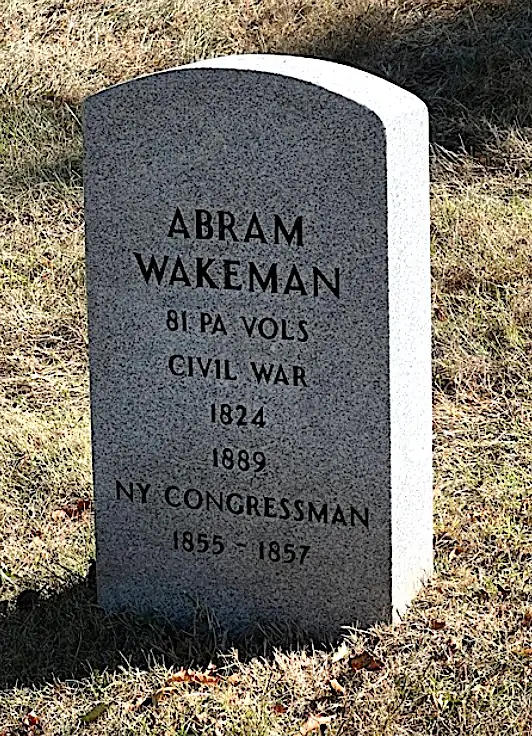
WAKEMAN, JAMES (1820-1888). Private, 65th New York Infantry, Company G. Wakeman enlisted on August 21, 1863, mustered into the 65th New York that day, and was discharged for disability on April 7, 1863. He last lived at 456 Perry Street in Brooklyn. Wakeman died from diabetes. Section 108, lot 3067.
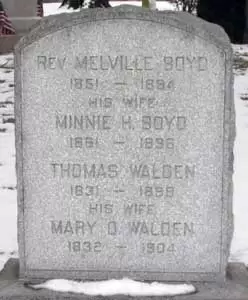
WALDEN, THOMAS (1831-1899). Landsman, United States Navy; rank unknown, 13th Regiment, New York State Militia. According to his obituary in The New York Times, Walden, who was born in New York City of Huguenot descent, served in the 13th Regiment at the onset of the Civil War. He then enlisted as a landsman and mustered into the Navy on August 2, 1861, at Portsmouth, New Hampshire. The obituary states that he was for some time the private secretary to Admiral Farragut. His soldier record indicates that he failed to appear at his discharge. After the War, he was employed by The New York Paper Trade Journal. He was also the park commissioner of Holyoke, Massachusetts, where he last lived. Section 41, lot 1377.
WALDO, EBENEZER G. (1834-1877). Sergeant, 37th Regiment, New York State Militia, Company C. Originally from Connecticut, Waldo enlisted at New York City and served as a sergeant in the 37th Regiment for 30 days in 1863. His last residence was 424 West 22nd Street in Manhattan. Section 82, lot 1749.
WALDO, WILLIAM BARRETT (1840-1862). Private, 133rd New York Infantry, Company D. A native of New York City where he lived at 135 9th Street, Waldo enlisted as a private at New York City on August 22, 1862, mustered into the 133rd New York on September 24, and died on October 11, 1862, at Camp Chase, Virginia, of debility and exposure. Section 51, lot 12582.
WALDRON, HAMPDEN (or HAMPDON, HAMPTON) (1841-1924). Major by brevet; first lieutenant, 84th New York (14th Brooklyn) Infantry, Companies I and D; 127th New York Infantry, Company B. Born in Boston, Massachusetts, and employed as a clerk, he enlisted as a second lieutenant at Albany, New York, on April 2, 1862, and was commissioned into Company I of the 14th Brooklyn that day. He stood 5′ 7″ with blue eyes and light brown hair. Waldron was promoted to first lieutenant on August 18, 1863, effective upon his transfer to Company D on December 9, 1863, and mustered out at New York City on June 3, 1864. During his service, he was an acting aide-de-camp and assistant adjutant general to General Casey. Subsequently, he was a first lieutenant in the 127th New York from June 6, 1864-June 30, 1865. On July 20, 1865, he became a captain in the 5th Regiment, serving until his discharge on June 16, 1866. On June 18, 1866, he was brevetted to major of United States Volunteers “for faithful and meritorious service.”
After the Civil War, Waldron was employed in the mercantile business and lived for several years in Kingston, New York, spending many summers in the White Mountains of New Hampshire and winters in Florida. His application for an invalid pension was granted in 1904, certificate 1,084,829. He last lived in New York City and died of angina pectoris in Jersey City, New Jersey. Camilla M. Waldron, who is interred with him, applied for a widow’s pension in 1925, application 1,231,174. Section 18, lot 8232.
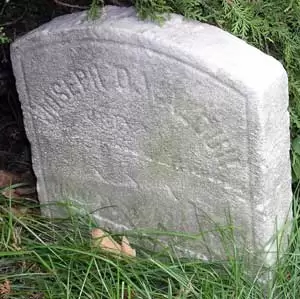
WALDRON (or WALDUN), JOSEPH (1844-1893). Private, 72nd Indiana Infantry, Company K. A resident of Delphi, Indiana, he enlisted on August 15, 1862, mustered into the 72nd Indiana on that date, and mustered out on July 24, 1865, at Nashville, Tennessee. In 1890, his application for an invalid pension was approved, certificate 806,682.
Waldron last lived on Prince Street in Brooklyn but died at the Brooklyn Insane Asylum. A government-issued stone is on his gravesite (misspelled Waldun). His widow, Helen Waldron, who is interred with him, applied for a pension in 1896, application 597,764, but there is no certificate number. Section 86, lot 5633, grave 3.
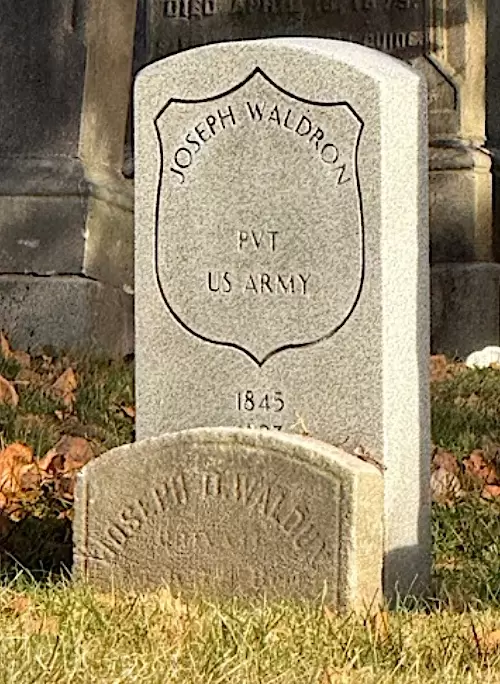
WALKE, HENRY (1808-1896). Rear Admiral, United States Navy. Born on a plantation in Virginia, he was educated in Ohio, then began his naval career as a midshipman on February 1, 1827. Attached to the frigate Delaware in the Mediterranean Squadron from 1828-31, he passed midshipman in June 1833 and was promoted to lieutenant on December 9, 1839. He served in the Gulf Squadron as executive of the bomb-brig Vesuvius during the Mexican War. Walke was commissioned commander on December 14, 1855, after serving in the Mediterranean.
Walke was commander of the storeship Supply at the Navy Yard at Pensacola, Florida, when it was seized in January 1861 by secessionists. He negotiated the removal of the garrison, which he led to New York City. For this he was court-martialed for leaving his post without permission, found guilty, and given a mild admonishment. He continued to serve in the Navy in expeditions on the Mississippi River, at Fort Henry on February 6, 1862, and at Fort Donaldson on February 10-16, 1862. He was heroic in running his gunboat Carondelet past enemy batteries on Island No. 10 in April 1862, an action described by one commentator as “one of the most daring and dramatic events of the War.” He commanded the Carondelet at Memphis, Tennessee, on June 6, 1862, fought the Confederate ram Arkansas on the Yazoo River on July 12 of that year, and was commissioned captain four days after that engagement.
Subsequently, in 1863, he commanded the ironclad Lafayette downstream and helped in the capture of Vicksburg, Mississippi. The next year he was stationed off Europe, and commanded the Sacramento in its search for Confederate cruisers. It was Walke and his crew, along with Commodore Thomas T. Craven and the Iroquois, who, when confronted by the might of the CSS Stonewall off Ferrol, Spain, refused to accept the confederate ship’s challenge to fight.
Walke was promoted to commodore on July 25, 1866, commanded the Naval Station at Mound City, Illinois, in 1868, rose to rear admiral in 1870, and retired from the Navy in 1871 to live out his remaining years in Brooklyn. His book, Naval Scenes and Reminiscences in the Civil War, which included his sketches, and in which he claimed that he had “fought more for this country than any other officer in the Navy,” was published in 1877. He last lived at 492 3rd Street in Brooklyn. His death was caused by the grippe (influenza). Section 20, lot 9292.
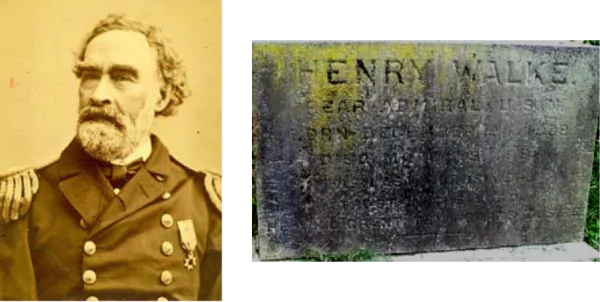
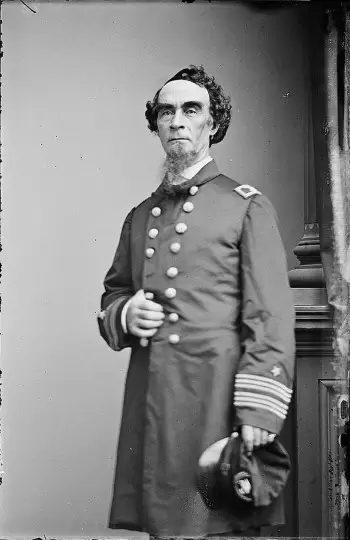
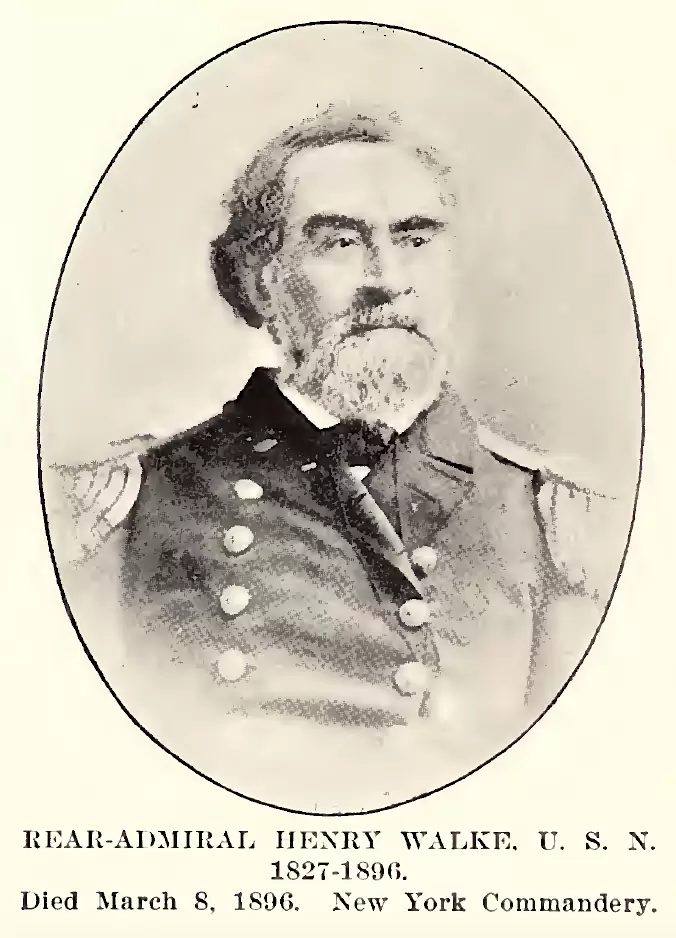
WALKER, ALEXANDER JAMES (1832-1872). Private, 22nd Regiment, New York State National Guard, Company H. Born in Scotland, Walker enlisted at New York City as a private on May 28, 1862, mustered into the 22nd Regiment on that day, and mustered out three months later on September 5 at New York City. His last residence was 148 Madison Avenue in New York City. Section 115, lot 20785.
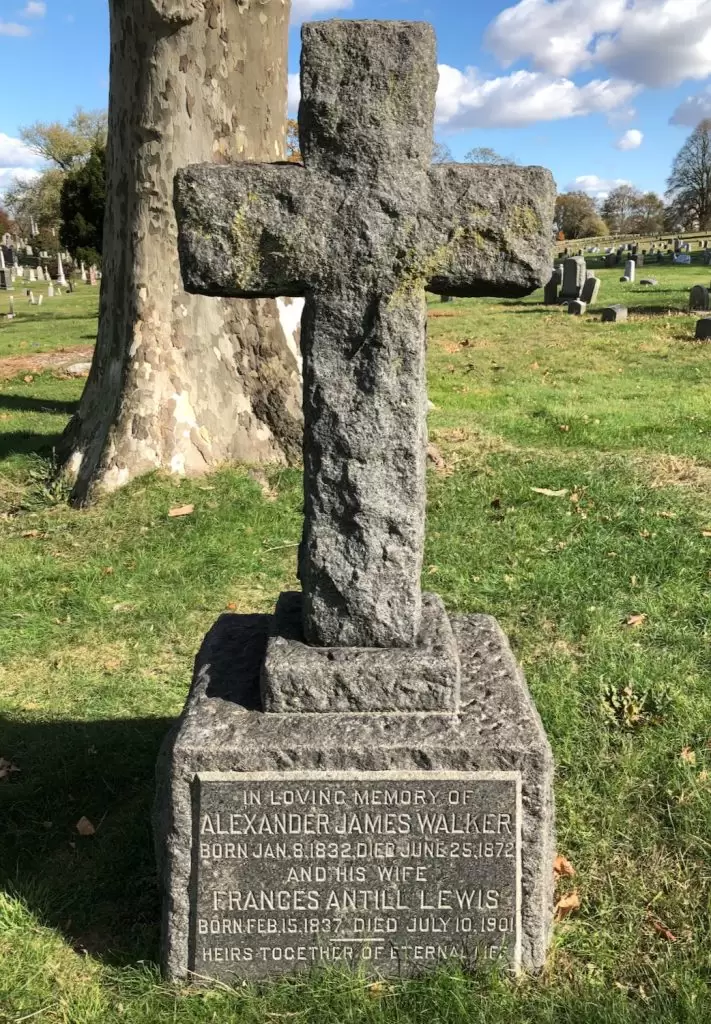
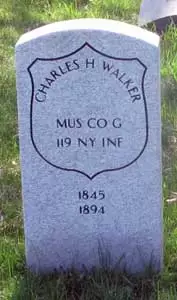
WALKER, CHARLES H. (1845-1894). Musician, 139th New York Infantry, Company G. Walker enlisted as a drummer, served with the 139th New York, and mustered out as a musician. Specific details are unknown.
As per his obituary in the Brooklyn Daily Eagle which confirmed his service in the Civil War, he was a member of the Ulysses S. Grant Post #327 of the G.A.R., the 139th Veterans, and was a Freemason. The obituary noted that he suffered from consumption as a result of his military service and had worked at the naval office of the Customs House. Members of the 139th were invited to his funeral. His last home was at 278 Dean Street in Brooklyn. His death was attributed to phthisis (tuberculosis.) In 1894, an application for a minor’s pension was granted under certificate 398,823. Section 114, lot 8999, grave 323.
WALKER, ISAAC S. (1827-1862). Captain, 65th New York Infantry, Companies E and H. Born in New Hampshire, he enlisted as a captain at New York City on August 24, 1861, was immediately commissioned into the 65th New York, also known as the 1st United States Chasseurs. He was transferred to Company H on September 1 of that year. He died of typhoid fever on May 27, 1862, at a hospital in Fort Monroe, Virginia. He last lived at 125 Willoughby Street in Brooklyn. His obituary in the New York Herald on June 3, 1862, said in part, “…The remains were escorted to Greenwood by a company of the 23rd N.Y.S.M., who made quite a creditable appearance. Walker was an excellent officer and was but thirty-five years of age at the time of his death.” Section 110, lot 9755.
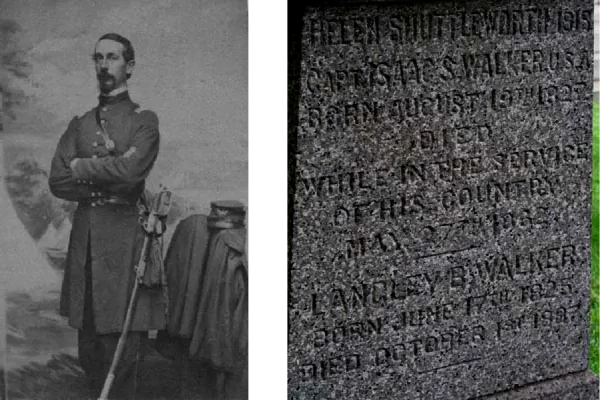
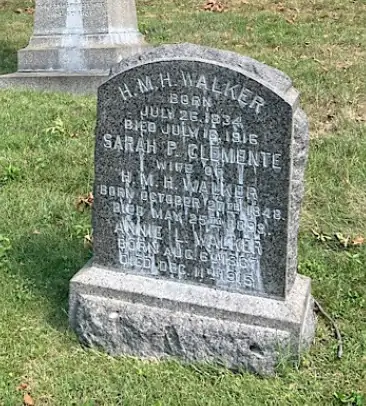
WALKER, JAMES (1844-1934). Private, 62nd New York Infantry, Companies K and A. Walker, a native of Ireland, enlisted on May 22, 1861, at New York City, as a private. He mustered into Company K of the 62nd New York, known familiarly as Anderson’s Zouaves, and transferred into Company A of the regiment on July 7 of that year. Walker mustered out on June 29, 1864, at Petersburg, Virginia.
According to his obituary in The New York Times, he was employed for 52 years with the Seth Thomas Clock Company to which he donated his clock and watch library. Renowned for his mineral collection, he was a member of the Brooklyn Mineralogical Club and donated his mineral collection to the Brooklyn Children’s Museum three years before his death. Remaining interested in military affairs, he was one of the last surviving members of the Ulysses S. Grant Post #327 of the G.A.R. His last residence was 731 Lexington Avenue in Brooklyn. Section 62, lot 2224.
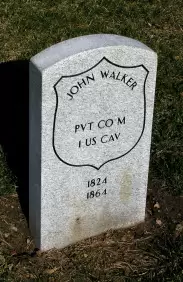
WALKER, JOHN (1824-1864). Private, 1st Cavalry United States Regular Army, Company M. Born in Nova Scotia, Canada, he served with the 1st Cavalry of the Regular Army. Other details of his service are unknown. He died from chronic diarrhea in a hospital for soldiers on 51st Street in Manhattan. A marble Veterans Administration stone was ordered for him early in the 20th century. Section 115, lot 13536 (Soldiers’ Lot), grave 83.
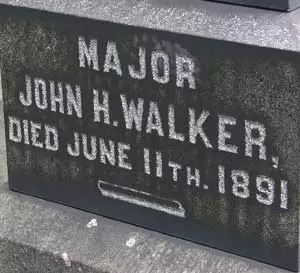
WALKER, JOHN HOBART (1843-1891). Major and captain by brevet; captain, 14th Infantry, United States Army; private, 13th Regiment, New York State Militia, Company D. A native of Saratoga Springs, New York, Walker began his military service as a private when he enlisted at Brooklyn on April 23, 1861, and mustered immediately into the 13th New York State Militia. Prior to his discharge from the militia on June 20, 1861, he was promoted to first lieutenant and commissioned into the 14th Infantry, United States Army, on May 14, 1861. He was brevetted to captain on June 27, 1862, “for gallant and meritorious service in the Battle of Gaines Mill, Virginia,” and was brevetted to major on September 17, 1862, “for gallant and meritorious service in the Battle of Antietam, Maryland.” Walker received a promotion to captain on May 6, 1865, and was transferred to the 23rd New York Infantry of the U.S. Army on September 21 of that year, serving until his retirement on March 27, 1869.
As per his obituary in the Brooklyn Daily Eagle, he earned the nickname of “Fighting Jack Walker” during his military service. The obituary goes on to add that while on a scouting mission out West in 1869, he and others were caught in a blizzard that ultimately cost him most of the vision in one eye and the loss of some vision in the other. After that incident, he was sent to San Francisco, California, against his wishes, and retired from service. A prominent member of Rankin Post #10 of the G.A.R., he was its commander for three years, was chairman of the Memorial Committee for a time, and was grand-marshal on Decoration Day (now Memorial Day) when U.S. Grant came to Brooklyn to review the parade. He was also a Freemason.
According to the article in the Brooklyn Daily Eagle, Walker took care of an uncle who lived at 73 Utica Avenue in Brooklyn and, as a result, befriended the Hull family. One day, he took the Hull children and Mrs. Hull to Coney Island for an outing. When Alfred Hull, who lived apart from his wife, heard about the outing, he broke down the door of Mr. Walker’s uncle, and assaulted John Hobart Walker, causing his death from a fracture. Mr. Hull, who was charged with homicide, later claimed that he was drunk. Walker last lived on Willoughby Avenue in Brooklyn. Section 27, lot 11275.
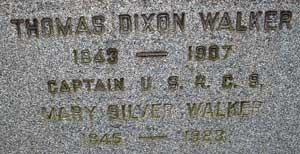
WALKER, THOMAS DIXON (1843-1907). Captain, United States Revenue Cutter Service. Walker was born in New Jersey. According to the inscription on his gravestone, he was a captain in the United States Revenue Cutter Service. His obituary in the New York Sun confirmed his service in the Navy during the Civil War but gave no details.
As per his obituary in the New York Herald, Walker was ranking officer at New York Harbor during the America’s Cup races held there in 1901 and 1903. In that capacity, he organized the patrol fleet for the yacht races and commanded the fleet during the races; the New York Yacht Club recognized his work in America’s Cup with a special resolution. In 1902, he was appointed chairman of a commission to revise the regulations for the Revenue Cutter Service, and headed a commission in 1906 that tested the strength of anchors. The obituary noted that he was a personal friend of Sir Thomas Lipton whom he met during international competitions. Lipton later requested that Walker be in charge of the Great Lakes Yacht Race (1906) whose winner received the Lipton Trophy. He was a member of the Columbia and Chicago Yacht Clubs, the Milwaukee Club and the Ulysses S. Grant Post #327 of the Grand Army of the Republic. Section 86, lot 25903.
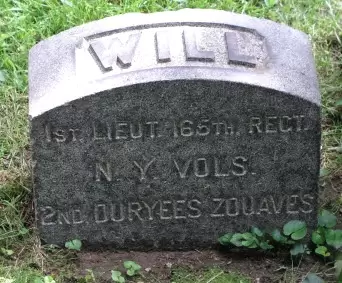
WALKER, WILLIAM J. (1838-1886). First lieutenant, 165th New York Infantry, Companies F and B. He enlisted at New York City as a second lieutenant on October 30, 1862, and was commissioned into Company F of the 165th that day. During his service, he was wounded on June 14, 1863, at Port Hudson, Louisiana, and promoted to first lieutenant effective upon his transfer to Company B on February 1, 1864. On September 1, 1865, he mustered out at Charleston, South Carolina. He died of inflammation of the bowels in Cumberland, Maryland. Section 67, lot 1836.
WALL, FREDERICK A. (1844-1906). Private, 83rd New York Infantry, Company K; 6th New York Independent Battery. Wall was a native of New Jersey. On August 15, 1861, he enlisted and mustered into the 83rd New York at New York City, and transferred into the 6th New York Independent Battery on December 7 of that year. According to his obituary, he was wounded in action twice and served in 24 battles including Antietam, Maryland; Seven Oaks and the Wilderness, Virginia; and Gettysburg, Pennsylvania. He was discharged on August 16, 1864, at New York City. In 1886, his application for an invalid pension was granted, certificate 420,705. That obituary also indicates that he served as a lieutenant; according to Phisterer, a F. A. Wall was commissioned a second lieutenant in the 182nd New York Infantry in 1863, but never mustered in at that rank.
Wall was a member of the Hamilton Post #182 of the G.A.R., joining in 1889. He was employed as a decorator. He last lived at 150 West 122nd Street in Manhattan. His death was attributed to cholelithiasis (gallstones). Section 107, lot 8059.
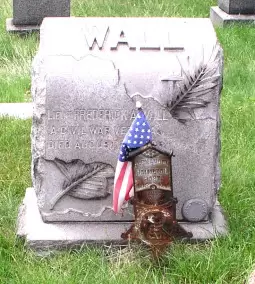
WALL, JOHN PATRICK (or PATRICK J.) (1842-1885). Sergeant, United States Marine Corps. After enlisting on October 11, 1859, Wall, a native of England, served on the USS Connecticut until his discharge at the Marine Barracks in Brooklyn on October 15, 1863, at the expiration of his term. He last lived in Brooklyn at 67 Clermont Avenue. In 1890, Jennie Wall, who is interred with him, applied for and received a widow’s pension from the Navy, certificate 8,938. Section 199, lot 25572.
WALL, MICHAEL W. (1840-1888). Captain, 8th Regiment, New York State Militia, Company B. Serving during three activations of the 8th Regiment, Wall, who was born in Brooklyn, enlisted at New York City as a second lieutenant on April 23, 1861, and was commissioned into the 8th Regiment two days later. He was promoted to first lieutenant on May 29, and mustered out on August 2 at New York City. When he returned to the same regiment and company in 1862, which was then part of the New York State National Guard, he was promoted to captain and commissioned in on May 29, 1862, and mustered out after three months on September 10 at New York City. He returned to the same assignment on June 17, 1863, when he was commissioned in, and mustered out after 30 days on July 23 at New York City. Wall last lived on East 54th Street in Manhattan; he died of Bright’s disease in Thomasville, Georgia. Section 56, lot 9802.
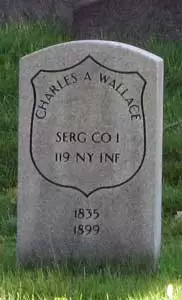
WALLACE, CHARLES A. (1835-1899). Sergeant, 119th New York Infantry, Company I. Wallace enlisted as a sergeant on August 15, 1862, at New York City, and mustered into the 119th on September 5, 1862. At some point, he was reduced to the rank of private, then promoted to corporal before he mustered out on June 7, 1865, at Bladensburg, Maryland. He last lived in Greenwich, New York. Section 43, lot 4669, grave 6.
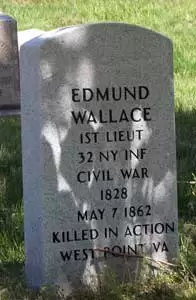
WALLACE, EDMUND (or EDMOND) (1828-1862). First lieutenant, 32nd New York, Companies K and G. A New Yorker by birth, he lived at 26 Watt Street in Manhattan, when he enlisted at New York City as a first sergeant on May 17, 1861. Two weeks later, he mustered into Company K of the 32nd New York. He was transferred to Company G on August 9, 1861, upon his promotion to second lieutenant on that date. A day later, he was promoted to first lieutenant. He was killed in action on May 7, 1862, at West Point, Virginia, and was interred at Green-Wood eight days later. Section 122, lot 9895, grave 852.
WALLACE, JAMES (1843-1864). Private, 62nd New York Infantry, Company A. Wallace enlisted as a private at New York City on May 3, 1861, and mustered into the 62nd New York a month later on June 30. After re-enlisting on February 5, 1864, he was wounded at Petersburg, Virginia, on June 23, 1864, and died of his wounds on September 20, 1864, at Washington, D.C. He last resided at 220 East 9th Street, New York City. Section 167, lot 16856.
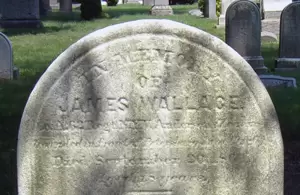
WALLACE, MICHAEL (1812-1865). Private, 82nd New York Infantry, Company D. Wallace, whose family called him Malcomb, enlisted at New York City on September 1, 1861, and mustered into the 82nd New York on September 25. He was 5′ 10″ with gray hair and eyes. According to his descendant, he was a former police officer and baker at the time of his enlistment and lied about his age when he enrolled, saying that he was 39 rather than revealing that he was in fact 49 years old.
Wallace served as a teamster, teamsters’ cook, and was in the pioneer corps during his first tour of duty. He re-enlisted as a veteran volunteer on December 29, 1863, at Stevensburg, Virginia, and was detached to the brigade commissary department. On June 22, 1864, he was captured at Petersburg, Virginia, confined at Richmond on June 25, then on June 29 was transferred to a prison in Lynchburg, Virginia. From there he was transferred to the notorious Confederate prison in Andersonville, Georgia. After his return at Vicksburg, Mississippi, on April 21, 1865, he went to Benton Barracks, Missouri, then was sent to Camp Parole at Annapolis, Maryland, on May 5, 1865, and mustered out on May 14, 1865, at New York City. Wallace contracted chronic diarrhea at Andersonville that ultimately caused his death on December 22, 1865. He is buried in the same lot as his son-in-law, George S. Hodgson (see). He died at his residence, 314 East 24th Street in Manhattan. His wife, Ann E. Wallace, applied for and was granted a widow’s pension in 1866, certificate 115,230. Section 62, lot 2223.
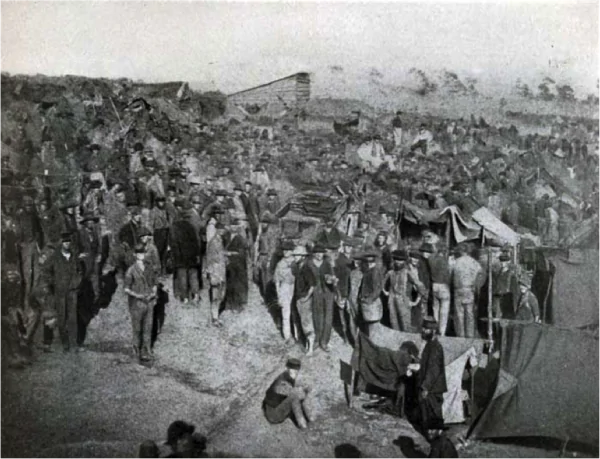
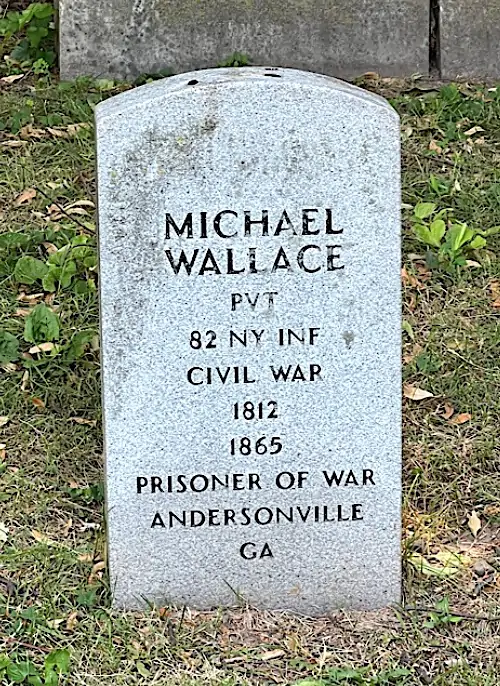
WALLACE, SAMUEL (1840-1905). Captain, 79th New York Infantry, Companies D, I, G, and H. A native of Ireland, he enlisted as a private at New York City on May 13, 1861, and mustered into Company D of the 79th on May 27. He was promoted to sergeant major on January 8, 1862, the same day that he was transferred to the Field and Staff of the regiment. On November 1 of that year, he rose to second lieutenant effective upon his immediate transfer to Company I. Wallace became a first lieutenant the next month on December 19 and was transferred that day to Company G. He rose to captain on August 1, 1863, effective upon his transfer that day to Company H, and mustered out on May 31, 1864, at New York City. A Brooklyn resident, his death was a suicide in Jersey City, New Jersey. Section 155, lot 22972, grave 6.
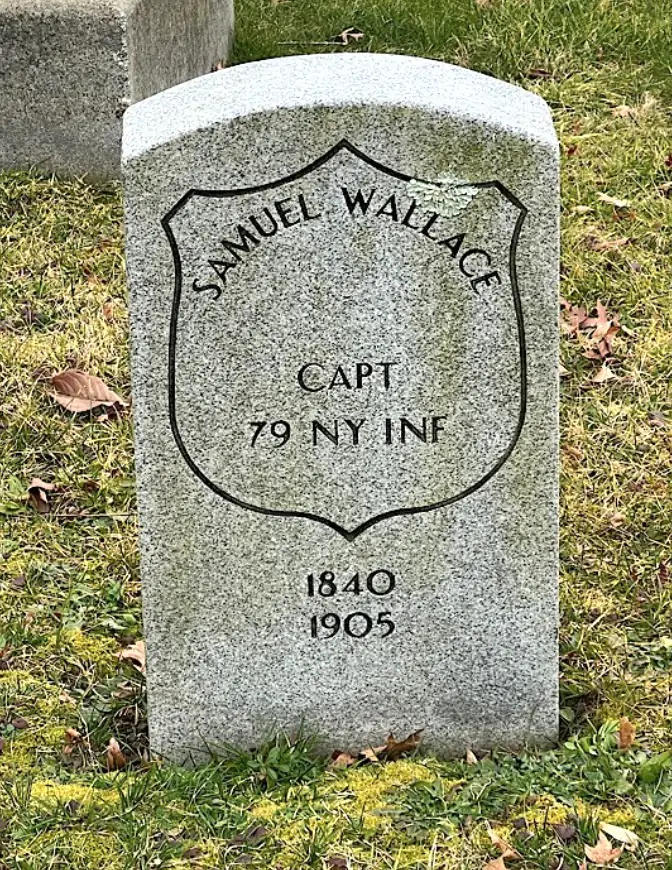
WALLACE, WILLIAM W. (1837-1898). Private, 56th New York Infantry, Company E. Wallace, who was born in New York State, enlisted on July 6, 1861, at Middletown, New York, as a private. On September 1, 1861, he mustered into the 56th New York from which he was discharged for disability on July 5, 1862, at Harrison’s Landing, Virginia. In 1878, he applied for and was granted an invalid pension, certificate 520,662. His last residence was 121 Eighth Avenue in New York City. His widow was awarded a pension in 1899, certificate 483,858. Section 101, lot 7569, grave 12.
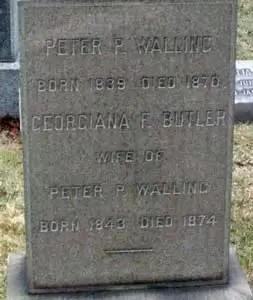
WALLING, PETER (1839-1870). Private, 25th Regiment, New York State National Guard, Company A. Born in Brooklyn, Walling enlisted as a private at Albany, New York, on May 31, 1862. On that date he mustered into the 25th Regiment and mustered out three months later on September 8 at Albany. His last residence was on Third Avenue in Brooklyn. Section 183, lot 19142.
WALSH, FRANK E. (1841-1876). Captain, 15th Regiment, New York State National Guard, Company E; first lieutenant, 18th Regiment, New York State National Guard, Company E; A New York native, Walsh enlisted at Rye, New York, as a first lieutenant on July 8, 1863, and was commissioned that day into the 18th Regiment. He mustered out on August 15, 1863. He re-enlisted as a captain at Mamaroneck, New York, on June 4, 1864, was commissioned into the 15th Regiment that day, and mustered out on July 7, 1864, at Fort Richmond, New York Harbor.
After the Civil War, Walsh served in the 18th New York National Guard from June 10, 1865-November 9, 1869, as its lieutenant colonel. He last lived at 669 8th Avenue in Manhattan. His death was caused by Bright’s disease. In 1921, Mary Walsh applied for a widow’s pension, application 1,169,871, but no certificate number is listed. Section 113, lot 17315.
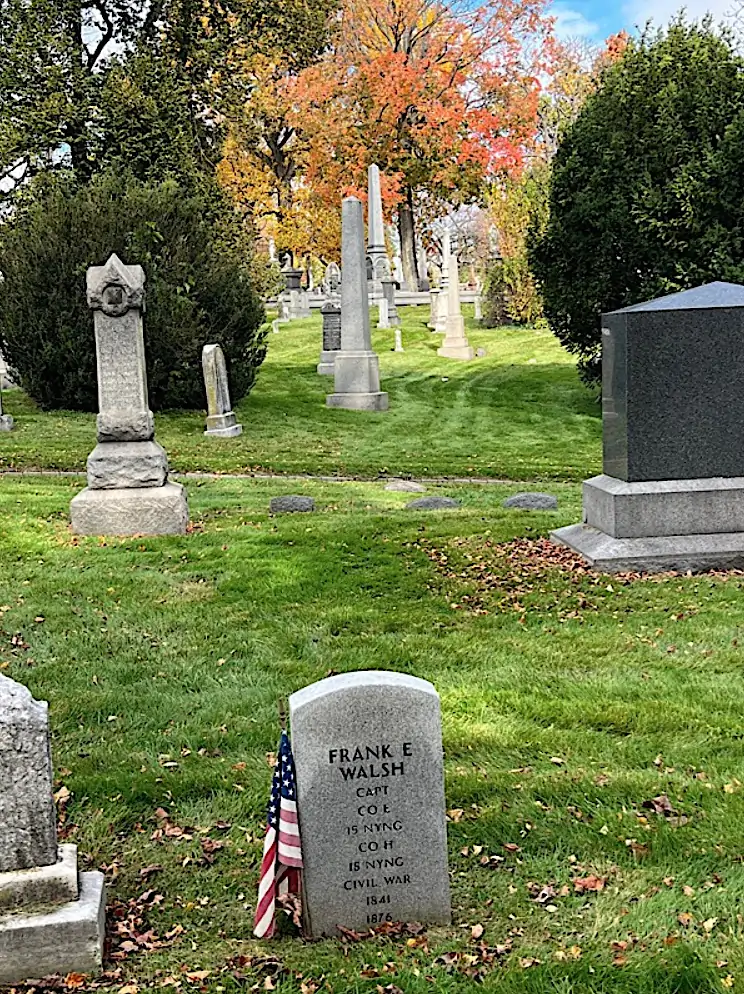
WALSH, PATRICK (1824-1908). Private, 173rd New York Infantry, Company D. Of Irish birth, he enlisted at Flatbush on September 20, 1862, mustered into the 173rd on October 30, and deserted two months later on December 28 from a ship in the harbor. Walsh last lived on Jefferson Avenue in Brooklyn. Section 207, lot 20982, grave 3.
WALSH, ROBERT (1828-1889). Private, 5th United States Infantry, Company K; 7th United States Infantry. Of English birth, Walsh enlisted out West in 1859 and served as a soldier in the Indian wars. During the Civil War, he first served as a private in the 5th Infantry, Regular Army. In February 1864, he transferred into the 7th U.S. Infantry and returned to the 5th Infantry in April 1864, and served with galvanized Yankees, Confederate prisoners of war who swore allegiance to the Union. After the War, the 5th returned to duty in the West where the regiment saw action against Indians in Kansas and the northern plains. At some point, Walsh was promoted to sergeant. He died at Post Hospital on Governor’s Island in New York City. Section 6, lot 20118, grave 605.